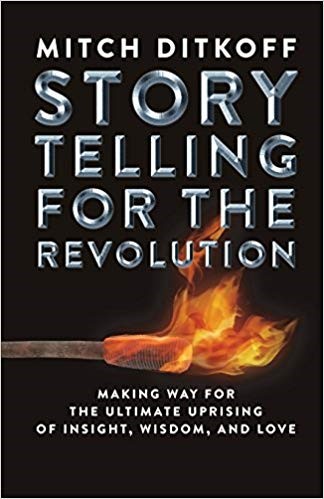TEAM LEADERS: Communicate Your Responsibilities to Your Team!

If you are a Team Leader, one of the first things you will need to do is let your team know the full scope of your roles and responsibilities.
You may think they know, but it's very likely that they don't -- at least not at the level of specificity that a high performing team requires.
And if team members don't understand what you actually DO -- and WHY you do it -- chances are good that they will resist, rebel, or reject your efforts to play your role.

1. HOW TO PROCEED: As soon as possible, meet with your team and explain the scope of your role. If you happen to be a new team leader (and your team is doubtful of your skills, leadership ability, or authority),let them know, who, specifically, in your organization, has empowered you to BE the Team Leader and that you take your responsibility very seriously.
Be sure to mention that one of your main roles is to be a helpful resource for team members -- to be there for them to help ensure that they enjoy their job, learn, grow, collaborate, and accomplish their ambitious performance goals for the year.
NOTE: Some members of your team probably perceive you as the person who is going to judge, evaluate, correct, criticize, intimidate, and hassle them. Paranoia alert! This is old school thinking. Or more like pre-school thinking.
A savvy team leader will quickly dispel this bogus notion. The faster you can let your team know that the essence of your role is be of of major support to them, the better.
2. BE SPECIFIC ABOUT YOUR ROLES AND RESPONSIBILITIES: The term "Team Leader" will mean different things to different people. Unless you explain precisely what your role is (and what it's not), you will be at the mercy of your team members' wide range of concepts, assumptions, and projections.
The best way to minimize this kind of background noise is to clearly and confidently describe, one by one, your Team Leader roles and responsibilities.
Towards that end, take a look at the list of your possible roles and responsibilities below. Note the ones that accurately describe your job and add whatever items may be missing.
-- Help your team articulate and fulfill its mission statement
-- Listen non-judgmentally
-- Share your expectations for the year
-- Establish and uphold standards of excellence
-- Facilitate the process of establishing team agreements
-- Work with team members to set performance goals
-- Observe and evaluate performance on-the-job
-- Give useful, humane, and timely feedback
-- Coach and mentor
-- Clarify team members' roles and responsibilities
-- Hold people accountable for results
-- Identify, clarify, and communicate team processes
-- Facilitate team meetings
-- Secure resources for the team
-- Ensure that team members create their Learning Plans for the year
-- Promote the teams' successes to Senior Leadership
-- Establish a simple, inspiring ideation process
-- Conduct performance reviews
-- Acknowledge individual and team progress
-- Address team challenges, conflicts, and breakdowns
-- Do everything possible to ensure the team's well-being

Posted by Mitch Ditkoff at 11:39 AM | Comments (0)
April 09, 202425 Reasons Why Brainstorming Sessions Fail in Your Company

Whenever I ask my clients to tell me about the quality of their company's brainstorming sessions, they usually roll their eyes and grumble, noting several of the phenomena below.
Recognize any of them in your organization?
1. Lame facilitation
2. Wrong problem statement
3. Unmotivated participants
4. Hidden (or competing) agendas
5. Insufficient diversity of participants
6. Addiction to the status quo
7. Lack of clear ground rules
8. Insufficient trust in the facilitator
9. No transition from "business as usual"
10. Lack of robust participation
11. The extroverts take over
12. Habitual idea killing
13. Attachment to pet ideas
14. Discomfort with ambiguity
15. Hyper-seriousness

16. Endless interruptions
17. People come late and leave early
18. Premature adoption of the first "right idea"
19. Group think
20. Hierarchy, turfs, and competing sub-groups
21. Imbalance of divergent and convergent thinking
22. No tools or techniques to spark creativity
23. Inadequate idea capture methods
24. Premature evaluation
25. No meaningful follow through
Free the Genie sessions eliminate all of the above
Posted by Mitch Ditkoff at 07:45 AM | Comments (5)
April 07, 2023The Awesome Power of Immersion

"If I had an hour to solve a problem," explained Albert Einstein, "I'd spend the first 55 minutes thinking about the problem, and the last five solving it."
Translation? One of the secrets to having a big breakthrough is immersion -- "the state of being deeply engaged, involved, or absorbed."
Immersion is the ocean in which our fabulous insights, ideas, and illuminations are swimming. That's why Yogis seek out caves, embryos gestate, and writers go on retreat.
And that's why my business partner, Steven McHugh, and I rented a townhouse in Boulder, Colorado for 30 days and 30 nights when it was time for us to start up Idea Champions. We knew we had a great idea for a business, but we also knew that ideas were a dime a dozen and that unless we really immersed we'd end up with nothing much more than a charming story to tell at cocktail parties -- the idea for a business, but not the business itself.
Armed with little more than a flip chart, a few marking pens, and a burning desire to create something new, we unplugged from all our other commitments and jumped in with both feet.

We talked. We walked. We walked our talk. We noodled. We conjured. We brainstormed, blue-skied, dialogued, role played, invented, read, sang, stretched, drank coffee, wine, the crisp Colorado air, and whatever else it took to free ourselves from the gravity of what we already knew. If this was Rocky 1, our townhouse was the Gym, Adrienne nowhere in sight.
And every night before we went to bed, blissed out of our trees, we'd remind each other to remember our dreams and speak them aloud the first thing in the morning.
CLUES. We were looking for clues, hints, perfumed handkerchiefs dropped by our muse while we slept and anything else that bubbled to the surface of the imaginal stew we found ourselves now swimming in.
Crackpots? No. More like crockpots, simmering in our own creative juices, unimpaired by the almost infinite amount of distractions we had grown accustomed to calling our life.
Immersed. We were completely immersed -- two eggs submerged in the boiling water of creation, heat turned up, lid on, timer off.
Our walls? The walls of our abode? Covered with paper, sketches, scribbles, post-its, quotes, pictures, lists, charts, diagrams, questions, and take out menus -- the barely decipherable hieroglyphics of our journey into who knows where.
The floors? Our mothers would have had a heart attack, littered as they were with anything we didn't have a place for. Rube Goldberg meets Fellini. Yin meets Yang meets Jung -- the flora and fauna of two aspiring entrepreneurs on fire with possibility.

But our immersion went far beyond the four walls of our abode. It was a state of mind, not a geographical location. It didn't really matter where we were. Walking by the creek or sitting in a bar was all the same to us, ruled as we were by our shared fascination, random silken threads of conversation with complete strangers, and the increasingly apparent sense that we were on to something big.
And then, on the morning of the 19th day, very much at ease in our townhouse abode, there was a knock on the door -- a loud and insistent knock, a knock both of us found rather odd since nobody knew where we lived -- or so we thought.
"It's open," Steven shouted from across the room. "Go ahead and let yourself in."
And there, at the threshold, stood a woman neither of us knew, a woman boldly announcing that, for the past three days, she'd been hearing about "these two creativity guys" and she just had to meet us, her business now on the cusp of either breaking through or breaking down.
I don't remember a single thing of we said, but whatever it was hit the nail on the head.
The next day, there was another knock on the door. Apparently, someone else had heard about our whereabouts. This guy had a business, too, or was trying to have a business. He spoke. We listened. He spoke some more. We listened some more, occasionally asking a question or two and sharing some insight. He too, got what he needed.
On the third day, Jesus did not rise from the grave, but, yes, there was another knock on the door -- just enough proof to the logical part of our minds that the previous two visits were not random events, but part of some kind of emerging pattern -- what fans of Rupert Sheldrake might refer to as manifestations of the morphogenetic field, or what less metaphysical folks might describe as our very own "field of dreams."
Steven and I had done nothing at all to draw these people to us -- no ads in the paper, no posters on poles, no calls, no emails, no flyers, no social marketing campaigns. The only thing we'd done was immerse -- dig deeply into our own highly charged process of creating something new.
But this "nothing at all" wasn't nothing at all. It was something -- something grand and glorious. Something extraordinarily attractive.

Is a mother hen sitting on her egg doing nothing at all? Is she slacking? Is her seeming disappearance from the poultry marketplace a sign of irresponsibility?
To the casual observer, maybe that's what it looks like, but nothing could be further from the truth. Sitting is exactly what the mother hen needs to do in order to bring new life into the world. Stillness, not action, is her path.
Did Steven and I accomplish what we set out to do during our 30 days of immersion? Yes, we did. In spades. Beyond the inspiration, collaboration, and good feelings we experienced, we emerged with the design of our first product -- a creative thinking training we ended up licensing to AT&T just two years later for a truck load of money.
Was our immersion time all fun and games? No way. Chaos and confusion were our housemates, but the rent they paid sparked a ton of learning, creativity, discovery, and a new found willingness to make friends with the unknown -- what Henry Miller was referring to when he defined confusion as "simply a word we've invented for an order that is not yet understood."
In today's business world, immersion is a very rare commodity. ADD rules the day. Time is sliced and diced. We don't have time. Time has us. We tweet, we delete, we tap our feet, but all too often nothing much beyond the status quo ever really happens. Downtime has become an anathema -- the province of "B list" players. Busy-ness and business have become synonymous.
The assumption? The more we do and the faster we do it, the more success we'll have. Boil an egg? Ha! We microwave it -- even if it tastes like shit. Dive in? No way. We hydroplane.
But it doesn't have to be that way. It really doesn't.
Slowing down and going deep trumps speeding up and going crazy. Immersion trumps diversion. It's possible. Yes, it is. I have proof. And so do YOU, if only you would pause long enough to remember those extraordinary times when you unplugged, tuned in, and dove into your own process of creating something new and wonderful.
A QUESTION FOR YOUR CONSIDERATION:
What can you do, this week, month, or quarter, to unplug from the daily grind and give yourself the luxury of immersion? Where will you go? When? And who will you invite to accompany you, if anyone?
Excerpted from my forthcoming book: WISDOM AT WORK: How Moments of Truth on the Job Reveal the Real Business of Life.
Excerpted from Storytelling at Work
MitchDitkoff.com
IdeaChampions
Posted by Mitch Ditkoff at 08:58 PM | Comments (0)
November 03, 2021Brainstorming vs. Braincalming

If you work in a big organization, small business, freelance, or eat cheese, there's a good chance you've participated in at least a few brainstorming sessions in your life.
You've noodled, conjured, envisioned, ideated, piggybacked, and endured overly enthusiastic facilitators doing their facilitator thing. You may have even gotten some results. Hallelujah!
But even the best run brainstorming sessions are based on a questionable assumption -- that the origination of powerful, new ideas depends on the facilitated interaction between people.
You know, the "two heads are better than one" syndrome.

I'd like to propose an alternative for the moment: "two heads are sometimes better than one."
For the moment, I invite you to consider the possibility that the origination of great, new ideas doesn't take place in the storm, but in the calm before the storm... or the calm after the storm... or sometimes, even in the eye of the storm itself.
Ever wonder why so many people get their best ideas during "down time" -- the time just before they go to sleep... or just after waking... or in dreams... or in the shower... or in the car on the way home from work?
Those aren't brainstorming sessions, folks. Those are braincalming sessions. Incubation time.
Those are time outs for the hyperactive child genius within us who is always on the go. Methinks, in today's over-caffeinated, late-for-a-very-important-date business world, we have become addicted to the storm.
"Look busy," is the mantra, not "look deeply."
We want high winds. We want lightning. We want proof that something is happening, even if the proof turns out to be nothing more than sound and fury. High winds do not last all morning. Sometimes the storm has to stop.
That's why some of your co-workers like to show up early at the office before anyone else has arrived. For many of us, that's the only time we have to think.
"The best thinking has been done in solitude," said Thomas Edison. "The worst has been done in turmoil."
I'm not suggesting that you stop brainstorming (um... that's 20% of our business). All I'm suggesting is you balance it out with some braincalming. The combination of the two can be very, very powerful.
HERE'S A FEW WAYS TO GET STARTED:
1. In the middle of your next brainstorming, session, restate the challenge -- then ask everyone to sit in silence for five minutes and write down whatever ideas come to mind. (Be ready for the inevitable joking that will immediately follow your request). Then, after five minutes are up ask everyone to state their most compelling idea.
2. Ask each member of your team to think about a specific business-related challenge before they go to bed tonight and write down their ideas when they wake up. Then, gather your team together for a morning coffee and see what you've got.
3. Conduct your next brainstorming session in total silence. Begin by having the brainstorming challenge written on a big flip chart before people enter the room. Then, after some initial schmoozing, explain the "silence ground rule" and the process: People will write their ideas on post-its or flip charts. Their co-workers, also in silence, will read what gets posted and piggyback. Nobody talks.
It's your decision, at the end of the idea generating time, if you want the debrief to be spoken -- or if you want people to come back the next day for a verbal debrief.
"Let us be silent, that we may hear the whispers of the gods." - Ralph Waldo Emerson
The Mothership: Idea Champions
Posted by Mitch Ditkoff at 10:23 PM | Comments (6)
September 07, 2021100 Lame Excuses for Not Moving Forward With Your Great Idea

Do you have an inspired idea or project you want to manifest, but... er... um... just can't seem to get things rolling? Chances are good your reasons why are on the list below. No problem. Join the club. Without beating yourself up, simply note the ones that are your Achilles heel, then try the simple "go beyond excuses" exercise at the end of the list. You're welcome.
1. I don't have the time.
2. I don't have the money.
3. I have neither the time nor the money
4. Coronavirus!
5. I've got too much on my plate right now
6. I'm just not feeling it
7. I'll feel crappy if I fail
8. I'm just not that organized
9. I'm juggling way too many projects
10. My moon is in Sagitarius

11. I'm not good at presenting my ideas
12. I don't have enough support
13. The Illuminati!
14. My customers aren't asking for it
15. I don't have any customers
16. I don't have an office/studio/desk
17. I'm an artist, not a business person
18. My day job takes all my time
19. I don't have the right equipment
20. What if I'm just kidding myself?
21. I've already got enough headaches
22. I don't need yet another thing to do
23. My home life will suffer
24. I'm not disciplined enough
25. It's an idea way ahead of its time
26. I don't have an assistant
27. I don't have enough information
28. Someone will probably steal my idea
29. It will take me way too long to get results
30. We're in a down economy
31. I don't like filling out paperwork
32. People will laugh at me
33. My significant other will think I'm crazy
34. I need to chill for a while
35. The concept is too disruptive
36. I have to take care of my parents
37. I don't tolerate ambiguity all that well
38. I have to walk the dog
39. Now is not a good time to start a new project
40. I don't have the right personality for this
41. I'm going through too many changes right now
42. Where do I even begin?
43. If I succeed, too much will be expected of me
44. My laptop's in the shop
45. Things are changing so fast, my head is spinning
46. I need a break
47. I don't have enough clout to get things done
48. It's just not worth the effort
49. I'm getting close to retirement
50. My other projects will suffer
51. Been there, done that
52. I don't want another thing to think about
53. I won't have any time left for my family
54. A more nimble competitor will beat me to the punch
55. I don't have the right collaborator
56. I've never done anything like this before
57. I probably won't make any money from this
58. I'm not as young as I used to be
59. I don't have the right credentials
60. I need more information
61. I can't find my wallet
62. It will be hard sustaining the motivation
63. I've tried before and failed
64. I'm not smart enough to pull this off
65. I don't want to go to any more meetings
66. It will take too long to get up to speed
67. I have to do my laundry
68. I don't know how to get the funding I need
69. Winter's coming
70. The marketplace is too volatile
71. This is a luxury I can't afford
72. I need to get my ducks in a row first
73. I don't have any ducks
74. I'm trying to simplify my life, not complicate it
75. The dog ate my homework
76. I don't like long lists like this
77. I have to pay the bills
78. I don't have the patience
79. What if this doesn't work?
80. I'm too right-brained for this sort of thing
81. I need to lose five pounds
82. I'm getting too old for this
83. Who am I kidding? It's a ridiculous idea.
84. I don't have a business plan
85. I don't have an instagram account
86. It's just not in the cards
87. What's that sound? Over there. By the refrigerator.
88. Market conditions aren't right
89. I need to focus on making some money first
90. My carbon footprint is too big
91. What I really need is a vacation
92. I don't have a marketing plan
93. Mercury is in retrograde.
94. Nostradamus didn't predict it
95. Maybe next year
96. Time for dinner
97. Project? What project?
98. I would if I could, but I can't, so I won't
99. I can't afford a lawyer
100.I just don't have the time
HOW TO GO BEYOND THESE LAME EXCUSES

1. Make a list of your most bothersome excuses.
2. Turn each excuse into a question, beginning with the words "How can I?" (For example, if your excuse is "I don't have the time", ask yourself "How can I make the time?")
3. Brainstorm each question -- alone and with a friend.
4. Try this. It's free
5. DO something about it within the next 48 hours.
Idea Champions
MitchDitkoff.com
What you get when you google "excuses"
ZoomStorming
Posted by Mitch Ditkoff at 08:53 AM | Comments (0)
July 13, 202110 Ways to Help Left Brainers Tap Into Their Creativity

If your job requires you to lead meetings, brainstorming sessions, or problem solving gatherings of any kind, chances are good that most of the people you come in contact with are left-brain dominant: analytical, logical, linear folks with a passion for results and a huge fear that the meeting you are about to lead will end with a rousing chorus of kumbaya.
Not exactly the kind of mindset conducive to breakthrough thinking.
Do not lose heart, oh facilitators of the creative process. Even if you find yourself in a room full of 10,000 left brainers, there are tons of ways to work with this mindset in service to bringing out the very best of the group's collective genius:
1. Diffuse the fear of ambiguity by continually clarifying the process
Most left-brain-dominant people hate open-ended processes and anything that smacks of ambiguity.
Next time you find yourself leading a creative thinking session, make it a point to give participants, early is the session, a mental map of the process you'll be using. Explain that the session will consist of two key elements: divergent thinking and convergent thinking.
In the divergent segment, you'll be helping people consider non-traditional approaches. In the convergent segment, you'll be helping people analyze, evaluate, and select from the multiplicity of ideas they have generated.
If participants are going to get uneasy, it will happen during the divergent segment. Your task? Periodically remind them of where they are in the process. "Here's our objective," you might say. "Here's where we've been. Here's where we are. And here's we're going. Any questions?"
2. Get people talking about AHAS! they've had
No matter how risk averse or analytical people in your sessions may be, it's likely that all of them -- at some time or another -- have had a really great idea.  "Creativity" really isn't all that foreign to them (although they may think it is). All you need to do to get them in touch with that part of themselves is help them recall a moment when they were operating at a high level of creativity.
"Creativity" really isn't all that foreign to them (although they may think it is). All you need to do to get them in touch with that part of themselves is help them recall a moment when they were operating at a high level of creativity.
Get them talking about how it felt, what were the conditions, and what preceded the breakthrough. You'll be amazed at the stories you'll hear and how willing everyone will be, after that, to really stretch out.
3. Transform limiting assumptions
One of the biggest obstacles to creativity is the assumption-making part of our brain -- the part that is forever drawing lines in the sand -- the part that is ruled by the past. Most people are not aware of the assumptions they have -- in the same way that most drivers are not aware of the blind spot in their mirror.
If you want people to be optimally creative, it is imperative that you find a way to help them identify their limiting assumptions about the challenge they are brainstorming. "Awareness cures," explains psychologist Fritz Perls. But DON'T get caught in a lengthy discussion about the collective limiting assumptions of the group. This is often just another way that left-brain dominant participants will default to analyzing and debating.
Instead, lead a process that will help participants identify and explore their limiting assumptions. Then, time allowing, help them transform each of these limiting assumptions into open-ended "How can we?" questions for brainstorming.
4. Encourage idea fluency
Dr. Linus Pauling, one of the most influential chemists of the 20th century, was once asked, "How do you get a good idea?" His response? "The best way to get a good idea is to get lots of ideas and throw the bad ones away."
That's why "Go for a quantity of ideas" is the first rule of brainstorming. You want to encourage people, early and often, to go for quantity. This will short circuit participants' perfectionistic, self-censoring tendencies -- two behaviors that are certain death to creativity.
5. Invite humor
The right use of is a great way to help people tap into their right brains. Indeed, "haha" and "aha" are closely related. Both are the result of surprise or discontinuity. You laugh when your expectations are confronted in a delightful way.
Please note, however, that your use of humor must not be demeaning to anyone in the room. Freud explained that every "joke" has a victim and is used by the teller to gain advantage over the victim -- a way to affirm power. And when a group finds itself in the realm of power (and the yielding of power), it will undoubtedly end up in left brain territory.
You don't want to feed that beast.
Instead, set the tone by telling a victimless joke or two, or by your own self-deprecating humor. But even more important than "joke telling" is to allow and encourage a free flowing sense of playfulness.

6. Do the right brain/ left brain two-step
Brainstorming for 3, 4 or 5 hours in a row is unusually exhausting, resulting in the "diminishing returns" syndrome. Creative thinking, like life itself, follows natural laws. Day is followed by night, winter by spring, inbreath by outbreath.
That's why the design of your creative thinking session needs to alternate between the cerebral and the kinesthetic -- between brainstorming and some kind of hands-on, experiential activity. By doing this two-step, participants will stay refreshed and engaged.
7. Periodically mention that chaos precedes creative breakthroughs
Left-brained, logical people are rarely comfortable with ambiguity, chaos and the unknown. It seems messy. Disorganized. Downright unprofessional. Indeed, much of the Six Sigma work being done in corporations these days is to reduce variability and increase predictability.
Paradox alert!
If you want to get really creative, you will need to increase variability and help participants get more "out of control." Picasso said it best, "The act of creation is first of all an act of destruction." Tom Peters said it second best, "Innovation is a messy business."
So, when you sense that your session is filled with ambiguity-phobic people, remember to mention how it's normal for ambiguity to precede a creative breakthrough. You may even want to mention how you will be purposefully infusing the session with moments of ambiguity, just to prime the creative pump.
8. Establish criteria for evaluation
The reason why ideas are usually considered a dime a dozen is because most people are unclear about their process for identifying the priceless ones. That's why a lot of brainstorming sessions are frustrating. Tons of possibilities are generated, but there is no clear path for winnowing and choosing.
Let's assume, for example, that the session you facilitate generates 100 powerful, new ideas. Do you have a process for helping participants pare the 100 down to a manageable few? If not, you need one. Ideally, the criteria for selecting ideas will be clarified before the session and introduced to participants early in the session.
Please note that there is some debate amongst brainstorm mavens as to when to offer the criteria. Some say this should happen at the beginning of the session (to help assuage the left brain need for logic and boundaries). Others suggest delaying the identification of criteria until just before the idea evaluation process. Either way will work. Your call.
9. Be a referee when you have to
No matter how many ground rules you mention about "suspending judgment" or "delaying evaluation," you are going to have some heavy hitters in the room just waiting for a moment to doubt your approach or "the process."
Indeed, one of the favorite (often unconscious) strategies of some left-brainers is to debate and question the facilitator every step of the way. While you want to honor their concerns and right to speak their truth, you also want to hold the bar high for the intention behind the brainstorming session -- and that is to challenge the status quo, entertain the new, and create space for imaginations to roam.
Don't be afraid to be firm with participants who want to control the session. At the very least, ask them to suspend their need for "convergence" (i.e. evaluation, judgment, decision making) to the end of the session when there will be plenty of time to exercise that very important muscle.
10. Consult with the tough people on the breaks
Every once in a while, a really opinionated person shows up in a session -- someone who is probably very smart, competent, experienced, with a big BS detector, and just enough arrogance to make you feel uncomfortable. These people can really affect the group, especially if they hold positions of power in the organization.
In the best of all worlds, these people would always be on your side. They won't be. Be careful about playing to these people in a neurotic attempt to get their approval. You won't get it. But DO seek them out on breaks and engage them. Get them talking. Pay attention. See if you can pick up any useful feedback or clues about revising your agenda or approach.
Even though you wouldn't choose to be trapped on a desert island with them, these folks may turn out to be a huge blessing -- because they are carriers of a particular sensibility that needs to be honored. More than likely, some of the other people in the room are feeling the same thing, but have been too polite to show their true colors. So, don't be afraid of these people. They can be a very valuable resource.
Idea Champions
Brainstorming for left-brainers
Right-brain teaching stories
Posted by Mitch Ditkoff at 10:43 PM | Comments (3)
July 04, 2021How to Spark Group Genius
Posted by Mitch Ditkoff at 04:49 PM | Comments (0)
November 02, 2020If You Plan on Asking an Outside Innovation Consultant for Help

If someone from your company's leadership team asks you to locate an outside consultant to help your organization raise the bar for innovation, stop for a moment and ask the person asking you to locate an outside consultant to answer the following questions.
If they answer "NO" to any of them or look at you as if you are ungrateful, uppity, or "not a team player", do not accept the assignment.
Really. I mean it. DO NOT ACCEPT THE ASSIGNMENT.
If you're afraid to decline the assignment, not only is the project doomed, but you will soon end up experiencing the kind of low grade corporate virus that leads people to drink too much, feel depressed, or become overly judgmental of their colleagues.
If you say YES to the "go find me a consultant" request without understanding the current reality of your senior team, you will only be going on a wild goose chase -- wasting your time, theirs, and the TBD consulting company's who will be asked to quickly generate a hefty proposal that few, if any, of your senior leaders will be ready, willing, or able to respond to.
QUESTIONS TO ASK YOUR SENIOR LEADERS BEFORE LOOKING FOR AN OUTSIDE INNOVATION CONSULTANT
1. Do you have a clear, compelling vision of our organization's future? If not, are you willing to create one?

2. Are you personally committed to fostering a culture of innovation? Are other senior leaders on the same page with you? If not, are you and your colleagues willing to get on the same page within the next few weeks?
3. Are senior leaders willing to walk the talk -- modeling the kind of behaviors they want to see others manifesting on the job?
4. Are you willing to challenge the status quo?
5. Are you open to receiving new ideas from the workforce -- and are you willing to establish a process that will make it easy for them to do so?
6. Are you willing to listen more deeply to what employees are thinking and feeling?
7. Are you committed to establishing and supporting an Innovation Council that will drive the process to raise the bar for innovation?
8. Are you willing to invest in a long-term approach, rather than treating the effort as a flavor-of-the-year initiative?
9. Are you willing to go beyond "command and control", empower people, and push decision making further down the food chain?
10. Are you open to input, guidance, and coaching from an outside company who can support you and the senior team in all of the above?
If you are unable or unwilling to ask these kinds of questions, the only thing you will end up achieving is further enabling the "kick the can down the road" mentality of your organization's senior team. By asking you to find an outside consultant to "help", they will have paid their dues for the moment and maybe be better able to sleep that night, but the whole thing will be little more than a charade -- one that simulates the effort to foster organizational change, but in the end is merely a clever way to fiddle while Rome burns.
Beyond sage on the stage consulting
Idea Champions
Culture of Innovation Keynote
Storytelling as an innovation catalyst
Posted by Mitch Ditkoff at 10:43 PM | Comments (1)
September 04, 202041 Ways Business Leaders Can Foster a Culture of Innovation

Yes, we know you want your organization to be more innovative. And yes, we know you want to improve your organization's culture of innovation. The best place to start? With YOU.
1. Give up needing to be the smartest person in the room.
2. Seek out people who think differently than you do.
3. Reward new thinking.
4. When you delegate, delegate.
5. Listen more, tell less.
6. Create an environment where no idea is considered dumb.
7. Be a learner, not a know-it-all.
8. Require that 30% of all budget proposals include innovative
products, processes, strategies, business models, or management
approaches.
9. Celebrate failures and learn from them.
10. Don't rush to resolve differences. Tolerate ambiguity while
gaining a deep understanding of the thought processes underlying
all positions.
11. Surface conflict and support minority positions.
12. Let go of your way of doing things.
13. Explore the territory before seeking a destination.
14. Reward people who disagree with you.
15. Protect the new from the old.
16. Get feedback to test whether what you think you communicated is what people actually heard.
17. Do whatever is necessary to deeply engage employees in the realm of the possible.
18. Do whatever is necessary to create widespread understanding and commitment to a shared vision of the future.
19. Reward teamwork and unselfish effort -- not individual heroics.
20. Accept as much of yourself as you can.
21. Recognize the talents of those around you and leverage them to the max.
22. Pave the way for your subordinate's success.
23. Develop all your reports to be your successor.
24. Provide very specific, timely, behavior-based positive feedback.
25. Begin your feedback with what you like about a new idea.
26. Make the path to considering, evaluating, and deciding on new ideas clear and easy to navigate.
27. Look behind "wild ideas" for potential new directions.
28. Never write anyone off. Try to understand where they are coming from before judging them.
29. Don't forget that everything you do is scrutinized for meaning.
30. Spend at least 20% of your time in two-way communication with people at all levels of your organization -- and spend most of this time listening, not explaining.

31. Be intentional and deliberate. Be clear about what you are trying to achieve and test whether that is what you are getting.
32. Stick your neck out for what you believe in and value.
33. Acknowledge when you don't know -- and rely on others to help you figure it out.
34. Give the work back. Your job is to get the best that everyone has to give -- not come up with all the answers yourself.
35. Eliminate fear from the workplace. Foster excitement and commitment.
36. Acknowledge when you are wrong. Don't defend yourself. Just learn from your mistakes.
37. Engage others in the exploration of what is possible. (Don't create unnecessary limits).
38. Keep your organization in the zone of "productive disequilibrium." Resist efforts to revert to the "tried and true."
39. Increase freedom and accountability. Let employees experiment with whatever approaches they think are worth exploring while remaining accountable for results. Let them own the "how." You own the "what".
40. Provide timely feedback and data to everyone so they can identify what is working and what needs fixing.
41. Remember that the only person you can change is yourself.
-- Barry Gruenberg
Idea Champions
Brainstorm Champions
Storytelling as a way to change culture
Posted by Mitch Ditkoff at 02:22 PM | Comments (0)
July 09, 2020The DNA of Idea Champions Workshops and Trainings

Most people think that the ability to be innovative is a mystical state available only to the chosen few.
The effort, they imagine, takes a lot of time and hard work. And since they don't have time and don't like hard work, they reason that innovation just isn't in the cards for them.
But innovation is not a mystical state. It's a natural state -- a human birthright. The people in your organization, in fact, already are innovative. The only thing is: their natural ability to be innovative is being obscured by their own habits of mind and a variety of bothersome organizational constraints.

Their challenge is the same one as seeing the "hidden" arrow in the FedEx logo (look between the "E" and the "X").The arrow has always been there, but most people never notice it.
This is the work of Idea Champions. We help people see what they already have, but don't know how to access.
We help people make meaningful adjustments of vision, insight, and perception so they can acknowledge, embrace, and apply their innate ability to be more creative on the job -- and, for those clients who want to reinvent their "innovation process", we help them figure it out.
What follows is a brief summary of how we do this...
1. Know Thy Customer:
Long before we ever get into a room with participants, we do our due diligence -- learning about WHO we are serving, WHAT they expect, and HOW our time with them will be the most significant.
Sometimes this takes the form of phone interviews. Or online polls. Or studying key documents our clients send us in order to understand their current reality, industry, business challenges, organizational constraints, and hoped for outcomes.
2. Customization:
Based on our assessment of our client's needs, we put together a game plan to get the job done. Towards this end, we draw on more than 100 "innovation-sparking" modules we've been developing since 1986.
3. Co-Creation:
Early in the design process, we invite our clients to give us feedback about our approach. Their feedback stirs the creative soup and provides us with the input needed to transform a good session design into a great one.
4. Spacing In:
We make a great deal of effort to ensure that the space in which our sessions take place are as ideal as possible. Form may follow function, but function also follows form.
When participants walk into an Idea Champions session, they begin "mind shifting" even before the session begins. It is both our belief and experience that culture/environment is a huge X factor for creativity and innovation.
5. Drive Fear Out of the Workplace:
W. Edwards Deming, one of America's most revered management consultants, was a big proponent of removing fear from the workplace. So are we. Towards that end, each of our sessions begins with a norm-setting process that makes it easy for participants to establish a dynamic culture of innovation for the day.

6. Mindset:
Organizations don't innovate, people do. But not just any "people." No. People who are energized, curious, confident, fascinated, creative, focused, adaptive, collaborative, and committed.
People who emerge from our sessions are significantly more in touch with these "innovation qualities" than when they began. Their minds have changed. They see opportunities when, previously, all they saw were problems.
They let go of perfectionism, old paradigms, and habitual ways of thinking. In their place? Open-mindedness, listening, idea generation, original thinking, full engagement, and the kind of commitment that drives meaningful change.
7. Balancing Polarities:
Human beings, by nature, are dualistic, (i.e. "us" vs. "them," "short-term" vs. "long-term," "incremental" vs. "breakthrough," "left brain" vs. "right brain".)
The contradictions that show up in a corporate environment (or workshop) can either be innovation depleters or innovation catalysts. It all depends how these seeming conflicting territories are navigated. Idea Champions is committed to whole-brain thinking -- not just right brain or left brain thinking.
Our work with organizations has shown us that one of the pre-conditions for innovation is a company's ability to strike the balance between these polarities.
Each workshop we lead and each consulting engagement we commit to is guided by our understanding of how to help our clients find the healthy balance between the above-noted polarities.
8. Expert Facilitation: "A rock pile ceases to be a rock pile when someone contemplates it with the idea of a cathedral in mind," wrote St. Exupery.
This, quite simply, is what Idea Champions does. But we do far more than just contemplate. We also architect and build.
Since 1986, we've been facilitating innovation-sparking engagements for a wide variety of industries. We have mastered the art and science of turning lead (or leaders) into gold. And we can train your people to do the same thing we do.
9. Experiential Challenges: "What I hear, I forget. What I see, I remember. What I do, I understand."
So said the great Chinese sage, Confucius. This 14-word quote describes the essence of our work. Simply put, we get people off their "ifs, ands or buts," and into the experience of what's possible.
While we value theory, research, models, data, best practices, business cases, and most of the other flora and fauna of business life, we've come to understand that the challenge of sparking insight, breakthrough, and change, is best accomplished by doing -- not talking.
That's why all of our sessions include experiential challenges that provide participants with visible ways of seeing innovation in action -- what supports it and what obscures it.
10. Emergent Design: Awakening the creativity of an organization's workforce is not a follow-the-dots exercise.
Although all of our interventions begin with carefully crafted project plans and agendas, our facilitators are fluent in the art and science of making the kind of real-time adjustments, refinements, and improvisations that are the difference between a good session and a great session.
Facilitators who attempt to imitate our approach find it difficult to succeed without first learning how to master the art of emergent design. The good news is that it can be learned -- and this is just one of the things we teach in our Train the Trainer programs.
11. Edutainment: Idea Champions sessions are a hybrid of two elements: education and entertainment. We know that when participants are enjoying themselves their chances of learning increase exponentially.
That's why we make all of our sessions a hybrid of education and entertainment. Participants do not get tired. They do not get bored. They do not sneak long looks at their smart phones.
12. Full Engagement: Idea Champions sessions are highly participatory. Our facilitators are skilled at teasing out the brilliance of participants, regardless of their social style, job title, or astrological sign.
But perhaps more importantly, our facilitators know how to help participants tease out each others' brilliance. Eventually, everyone gets into the act. The shy people take center stage and the power players take a back seat. The collective wisdom in the room gets a much-needed chance to be accessed and expressed.
13. Convergence: Idea Champions is successful because what we do works. And one of the reasons WHY it works is because our sessions help participants translate ideas into action.
Ideas are powerful, but they are still only the fuzzy front end of the innovation process. Ultimately, they need to turn into results. Creativity needs to be commercialized. Our workshops, trainings, and consulting interventions help our clients do exactly that.
14. Tools, Techniques, and Takeaways: Ideas Champions closes the gap between rhetoric and reality. We don't just talk about innovation or teach about it -- we spark the experience of it. And we do that in very practical ways.
One way is by teaching people how to use specific, mind-opening techniques to access their innate creativity. Another way is by providing our clients with a variety of innovation-sparking guidelines, processes, and materials that can be immediately used on the job.
Idea Champions
Creating a Culture of Innovation
Storytelling at Work
Brainstorm Facilitation Training
What our clients say
Posted by Mitch Ditkoff at 04:06 PM | Comments (1)
February 11, 2020What's Next After Twitter

Ever since Twitter made its appearance on the scene in 2006, millions of people have become enamored with the prospect of delivering a message in 140 characters or less.
Short and sweet has become the name of the game. Brevity rules.
And why not? In a world ruled at least as much by ADD as by maniacal despots, who's got time for anything else?
These days, we don't have time. Time has us.
But according to industry sources, Twitter has become passe. Like the SONY Walkman. Like your father's Oldsmobile. Like the last two sentences of this paragraph.
That's why I've invented TWI -- the next, new super hip, low carbon footprint, social networking platform.
It's quicker. It's faster. And by the end of this post, the company will have already issued an IPO.
140 characters? Please! That's an eternity!
With TWI all you get is 20 characters. That's an 86% improvement in productivity over Twitter. 86%!
If you can't deliver your message in 20 characters, you're obviously a slacker and we don't want your business. Why would we? You'd probably end up calling our customer service bots and wasting their time with your long-winded complaints.
TWI. Think about how much more efficient you will be -- leaving you so much more time to drink coffee and get more things done.
C'mon! What are you waiting for? Time. Is. Passing. Act now!
Idea Champions
Quick way to spark innovation
Even quicker
Posted by Mitch Ditkoff at 05:21 AM | Comments (0)
December 11, 2019On Creating an Innovation Mindset

If you want to spark innovation in your organization and are looking for the diamond cutters stroke, consider storytelling. Since 1987, I've tried everything under the sun to help my clients raise the bar for innovation. What I've discovered is that innovation begins in the mind and that unless people are in the right mindset, innovation will never be more than a pipe dream. Storytelling, I've learned, is the simplest, fastest, most memorable way to get people into an innovation mindset. Here's how we do it. And if you only have 90 minutes, this is how we do it. Its also boosts employee engagement.
I wrote the book
The back story
In our clients words
Posted by Mitch Ditkoff at 11:10 AM | Comments (2)
November 30, 2019Are You an Idea Addict?

There are lots of things in this world people get addicted to: alcohol, nicotine, heroin, sex, and iPhones, just to name a few. But perhaps the biggest addiction of them all is the addiction to our own ideas. Here's how it works:
We think something up. We feel a buzz. We tweak it, we name it, we pitch it, and POOF, the addiction begins.
At first, like most habits, it's a casual pursuit with a thousand positive side effects: increased energy, renewed focus, and a general feeling of well-being. Like wow, man. But then... we think about it in the shower. We think about it in the car. We think about it when people are asking us to think about other things. We even dream about it.

Soon we want everyone to know about it. We want them to feel the buzz. We want them to nod in agreement. We want them to recognize just how pure our fixation is.
If this is where it ended, it wouldn't be that big of a deal. I wouldn't be calling it an addiction. Maybe I'd be calling it an "inspiration," or a "commitment" or a "visitation from the Muse." But it doesn't end there. It goes on and on and on and on -- often to our own detriment.
If you are launching a new, creative venture, of course, you want to conjure up cool ideas. That's a good thing. But if you cling to ideas just because they're yours, or just because you've invested major time and energy into in them, then it's time to take a good look of what "intoxicating ideas" of yours it might be time to let go. Commitment is one thing. Addiction is quite another.
What hot, new idea of yours might you be just a little bit too addicted to?
Idea Champions
Brainstorm Champions
MitchDitkoff
Posted by Mitch Ditkoff at 08:20 PM | Comments (2)
October 06, 2019A Real Life Example of the Power of Giving Feedback

Most Fortune 500 companies have some kind of corporate strategy in place for ratcheting up their innovation efforts. Consultants are hired. CEOs give pep talks. And internal initiatives are launched.
To the casual observer, it all looks good, but few of these initiatives ever amount to anything In fact, research indicates that 70 percent of all change initiatives fail.
Why such a low percentage? It depends on who you ask. Senior leaders see it as a workforce issue. The workforce sees it as a senior leader issue. Consultants see it as an issue their company is best suited to resolve. And the occasional in-house astrologer sees it as a Gemini in Pluto issue. Bottom line, nobody really knows.

Here's how I see it: one of the biggest (and least addressed) reasons why most change initiatives fail can be traced back to the cro-magnon way most innovation-seeking people give and receive feedback -- especially when it comes to pitching high concept ideas.
Case in point: Some years ago, Lucent Technologies asked me to facilitate a daylong "Products of the Future" ideation session for 75 of their best and brightest. The pay was good. The challenge was compelling. And I was going to have carte blanche to design the session just the way I wanted.
Or so I thought.
The woman who had contacted me, I quickly found out, reported directly to the CEO. So far, so good. And her concept of the session was spot on -- that the CEO and his Direct Reports (a new rock band?), would make an appearance at the end of the day to listen to five BIG IDEA pitches and then give their feedback, real-time.
Theoretically, this made perfect sense. But theory and reality are two very different things -- kind of like the difference between asking your teenage daughter to clean up her room and her actually doing it.
The harsh reality is this: The vast majority of Senior Leaders are not very skillful when it comes to giving feedback -- especially in response to ideas that challenge the status quo. "Feedback," for them, has become code for "With all due respect, let me tell you why your idea sucks".
As a facilitator of high profile brainstorming sessions, I cannot, in good faith, allow this all-too-predictable dynamic to play itself out. Not only will potentially profound ideas be prematurely dismissed, the hard-working, brilliant people who have spent all day generating and developing these ideas will become royally pissed, disempowered, humiliated, passive/aggressive, and depressed. The result? Very few of them will want to participate in future sessions.
So I told the consultant-seeking woman from Lucent that I, in service to the outcomes she was about to hire me to ensure, needed to meet with her CEO so I could teach him and his team how to give effective, humane feedback to a roomful of 75 future product generating optic fiber geniuses.
 "Impossible!" was her response. "Our CEO is very busy man -- and besides... he doesn't like consultants."
"Impossible!" was her response. "Our CEO is very busy man -- and besides... he doesn't like consultants."
"Got it," I said, quickly assessing my options. "And thank you, so much, for your kind invitation to facilitate the session, but I must respectfully decline" -- and, with that, I began packing up my briefcase.
This, shall we say, caught her slightly off guard. "I... don't understand where you are going with this," she replied.
"Look," I said. "If you want to get meaninful results from an all-day brainstorming session, especially if you are flying people in from who knows where, we've got to be absolutely sure that the feedback at the end of the day is done well. I am not going to walk 75 of your best and brightest people off the plank."
I could tell that my unexpected feedback was registering. "OK, OK...but the best I can do is get you five minutes with him during the coffee break just before the report outs".
"Great," I said. "I'll take it."
Fast forward two months.
From 8:30 am -- 3:00 pm, 75 of Lucent's most brilliant technologists conjured up products that made my head spin. The room was abuzz with glorious possibilities. The sense of accomplishment was palpable. At 2:45 they selected five of their best ideas and summarized them on flipcharts. At 3:00, it was time for coffee and sugar, me craning my head for the CEO and his merry band of direct reports.
I envisioned him to be a tall man, silver-haired, with a large Rolex and a steely look in his eyes -- someone who might be good friends with the Governor and eventually have his portrait hanging in the lobby at headquarters. He was, much to my surprise about 5'6", wearing a Mickey Mouse t-shirt, loafers, and no socks. My kind of guy.
"Rich," I began, extending my hand. "Welcome, Mitch Ditkoff here from Idea Champions, facilitator of today's extraordinary ideation session, "how would you like to learn a simple technique in the next five minutes that will not only take all the dread out of giving feedback, but spark some seriously powerful idea development on the spot?"
He looked at me as if I'd just given him the holy grail. "You're on!"
"Great. Here's how it works," I began. "When an idea is pitched, first say what you LIKE about it -- the upside, what's promising. After a few genuine likes, then express your CONCERNS -- the stuff you probably wanted to say in the first place. But for each concern you express, it will be your responsibility to follow it with a SUGGESTION, a way that would resolve your concern and keep the idea alive Got it?"
"Got it."
"Oh... one more thing, Rich. If you forget to use the method, do I have your permission to remind you?"
"Absolutely".
The senior team took their place on stage, sitting behind a table, draped in black, that reminded me of the Nuremberg Trials. The 75 brilliant brainstormers took their seats at round tables -- everyone attentively listening to me describe the feedback process that was just about to unfold.

The first BIG IDEA pitch was excellent -- a compelling idea for a telecommunications platform of the future that was utterly mind blowing. The audience applauded, I acknowledged the presenter, and then gave the floor to the CEO, reminding him to use the feedback technique I'd taught him just a few minutes ago -- which he proceeded to do for, oh, maybe 30 seconds or so.
After that? It was Apocalyse Now meets The Godfather, with a little Don Rickles in Vegas thrown in for good measure, a scene I'd witnessed countless times before in corporate America -- the kneejerk, reptilian-brained, go-for-the-jugular tendency most senior executives have to focus on what's wrong with a new idea before what's right.
Speaking into the mic in my best baritone imitation of the Wizard of Oz, I quickly intervened.
"Oh Mr. CEO of a very large and profitable telecommunications company. Remember the LCS technique! First your LIKES, then your CONCERNS, then your SUGGESTIONS."
In an optic fiber nanosecond, he sheepishly smiled, thanked me for the reminder, and returned to the technique.
The rest of the session went off without a hitch. Five powerful ideas got pitched. Seven of Lucent's top executives weighed in with insight, honesty, and graciousness. And 75 aspiring innovators experienced something they had probably never experienced before -- that it was possible to spend all day brainstorming "out there" possibilities and get the kind of feedback from senior leadership that was honorable, empowering, easy-to-listen to, and immediately helpful.
SO WHAT? Ever hear the phrase "ideas are a dime a dozen." Of course you have. It's one of the classic truisms we were all brought up to believe. That old saw, however, is less about ideas being inconsequential, than it is about people not knowing how to elicit their value. Granted, not every idea is worth developing, but far too many good ones are lost along the way because the person to whom the idea is pitched is blinded by their own knee jerk reactions.
The literature is filled with examples of great ideas whose value was not immediately recognized. The steam engine. The MacIntosh. FedEx. And the Post-It Note just to name a few. All of them were pitched to the "powers-that-be" and all were victims of knee jerk, naysaying, idea killing behavior. Yes, it's true, many senior leaders beat the drums for "out of the box thinking". But when push comes to shove, as it often does, their drumming is more like fingernails on the edge of an office desk than a conga player with fire in his eyes. So let's give our senior leaders what they need to make the shift from theory to practice -- and that is a simple method for them to respond to new and untested ideas in a way that increases the odds of innovation actually happening.
NOW WHAT? Think about your style of responding to new ideas. Do you listen? Do you pause long enough to see the seed of innovation? Do you give meaningful feedback in a humane way? And what about your organization? Do people know how to give and receive feedback? Do they take the time? Does the process increase the odds of innovation becoming a reality? If not, what can you about it this week to turn things around?
Posted by Mitch Ditkoff at 06:46 PM | Comments (0)
September 13, 2019What I Learned from Being Heckled at a Corporate Keynote Presentation
Every person who has ever had a job has experienced at least one "moment of truth" in their life -- a time when all the chips were on the table and the decision of whether to go "all in" or not had to be made.
One such moment happened to me a few years ago when I was facilitating a creative thinking session for 110 of Lucent Technology's "best and brightest" -- a room full of brilliant computer scientists with more PhDs than most politicians have excuses.

There I was, on stage, introducing the day with a slide show of quotes from legendary innovators, when a man in the 10th row stands up and screams, "You are totally wrong! I used to work with that guy and he never would have said anything like that! If you can't get your quotes right, why should I believe anything you're about to tell us?"
If this was the Wild West, I had just been challenged to a duel at High Noon, armed only with a remote and a blueberry muffin.
Standing as I was in the epicenter of the optic fiber universe, I had only a nanosecond to assess the situation. There was no time for a strategic plan, no time for deliberation, no time to call my coach. This was Defcon 1, me face-to-face with one very angry man.
"Well..." I began (stalling for as much time as a single word would allow), "it is possible that you're right. The slides I'm showing today were just finalized yesterday and my assistant may have made an incorrect attribution. I will check with her when I get back to the office. That being said, I invite you to focus on the good stuff that's here for you today, not the possible flaws."
Logical? Yes. Effective? No. My comments only made him angrier, his face growing redder by the moment.
I now had a choice to make -- whether to further engage my corporate heckler in a heroic attempt to win him over or continue with the reason why I'd been hired in the first place -- to help seriously left-brained scientists tap into their lesser-used right brain.

Choosing the latter, I proceeded to teach a powerful mind-opening technique based on the thinking styles of Albert Einstein and Garry Kasparov (a former Soviet Union Grand Chess Master).
Technique taught, I walked to the side of the stage and observed.
For the next five minutes, everything went smoothly. Everyone in the audience was focused and doing the work.
Then, without warning, Mr. You-Got-Your-Slides-All-Wrong stood up and, with great velocity, began approaching the stage. On a scale of 1-10, with "1" being walking and "10" being storming, he was a 9.8.
The faster he walked, the quieter the room got as I took my stance and readied myself for whatever was next.
Two feet from me, my fast approaching inquisitor stopped dead in his tracks, looked at me fiercely, eyes on fire, and exclaimed, "This is amazing!"
"What is amazing?" I replied.
"The technique you taught," he said. "I just had an incredible breakthrough about a problem I've been struggling with for years."
Happy for him and greatly relieved, I asked if he'd like to share his breakthrough with the group -- a task that would require the two of us to change roles for a few minutes, him taking center stage as teacher, me taking his seat, as student.
Which is exactly what we did.
The man was on a roll, inspired, lucid, and highly expressive. I couldn't have asked for a better spokesperson to convey the message I was trying to communicate that day -- a message about the innate ability all people have to go beyond their limiting assumptions and tap into a realm where breakthrough insights abide.
The dramatic and very visible shift my "heckler" had made from left-brained naysayer to right-brained savant was the embodiment of a teaching I couldn't have scripted in a hundred years. This had never been about me putting this man in his place or him putting me in mine. It was about changing places and seeing the world and ourselves through new eyes.
FOOD FOR THOUGHT

None of us know when the moment of truth will come. None of us know what it will look like and how we will respond.
But we do know this: If we are awake and engaged in our work, it will come. There is no escape. The more we are already "all in", the easier it will be for us to respond to whatever comes our way. The more we are able to flex to the moment and make wise choices that serve the greater good, the more powerful the outcomes will be.
My moment of confrontation, at Lucent, did not allow me the luxury of deep deliberation. I had to trust myself, be in the moment, and go with the flow. But even more than that, I had to be willing to reframe what seemed to be a problem into an opportunity. I had to make lemonade out of lemons, on the spot, and not squirt anything in the eyes of the people I was there to serve.
My task was not to find fault with the fault finder (an easy thing to do), but to transform the moment into deeper understanding.
On the front lines of business, it is extremely easy to find fault in others. Even on a good day, most of us are woefully imperfect -- filled with a lifetime's worth of quirks, projections, fears, habits, and routines -- the kind of stuff that bugs even our closest friends. Throw in the X factor of stress, heavy workloads, and constantly changing priorities and you have a formula for... well... major heckling.
Your mission, should you choose to accept this assignment, is not to take it personally.
The person who is heckling you (at work, on the street, or in your home) is most likely having a bad day, week, month, quarter, year, or life. If Jesus, himself, was to make a sudden appearance, your heckler would probably find fault with his hair, clothes, or accent.
If you react with the same negativity that is coming your way, all you'll end up doing is throwing fuel on the fire. If you hate being judged, but then judge the judgers for judging, you will only end up in a fun house hall of mirrors with no exit.
Make sense?
PS: At lunch, after the high drama Lucent session, my client informed me of three things: 1) The man who heckled me does the same thing to every outside speaker no matter how much coaching he's received; 2) The exchange between the heckler and me was the perfect embodiment of one of Lucent's core values at the time -- allowing creative dissonance -- a value they had been trying, unsuccessfully, to embed it their culture for years and; 3) As a result of the positive impact my session had, Lucent was going to license my company's creative thinking training. Lemons hadn't just turned into lemonade, they turned into some major cash flow, too.
FOR YOUR CONSIDERATION: Think of a moment of truth you've had in the past year -- a surprise encounter that demanded an intuitive, in-the-moment response from you. What was that like for you? What did you do? What did you learn from the experience? And if, perchance, you did not respond in a way that worked, what might you do differently next time?
The story above is excerpted this book
It is NOT excerpted from this book
Posted by Mitch Ditkoff at 09:39 PM | Comments (0)
August 29, 2019Leave Your Title at the Door and Remove the Door From It's Hinges

When I co-founded my company in 1986, I had two business cards made. One said "President." The other said "Archduke." Whenever I gave clients a choice, they always wanted the Archduke card.
In time, I gave all the Archduke cards away and never re-ordered them -- in a pitiful attempt, I think, to seem more professional.
Fortunately, everything comes full circle. Last night, while enjoying a wonderful concert in my hometown of Woodstock, my next title was suddenly revealed.
Director of Public Elations (and, no, I did not forget the "R".)
In a flash, not only did I get an insight into what my focus will be for the next few years, I also discovered an entirely new field.
Cirque du Soleil is a perfect example.
Gracefully walking the high wire of the Experience Economy, they know their success is intimately connected to their ability to elate the public -- to uplift, inspire, and activate joy.
Southwest Airlines also understands this.
Theirs is a corporate culture founded on delight. Even Starbucks and Barnes & Noble have gotten into the act. Both of them know their product needs to be more than coffee and books, but a feeling -- a sense of well-being, ease, and community.
In a word, elation.
And so, I decided to share my title-changing revelation with my colleagues -- the "Senior Consultant," the "Webmaster," the "Chief Technology Officer," and the "Director of Operations."
I asked them to tell me what new titles they'd like. Here's what they told me:
- Chief Enlightenment Officer
- Princess of Possibility
- Head of Lettuce
- Webmaster of My Domain
- Director of Whatever Needs Directing
- Duke of URL
- Head of Steam
- Lord High Minister of Depth and Feared Wielder of the Reality Check
How about YOU?
What new title do YOU want to see on your next business card? What name more creatively describes what you really do at work?
Idea Champions
Free the Genie
The Innovation Accelerator
Illustration: gapingvoid
Posted by Mitch Ditkoff at 02:30 AM | Comments (12)
August 08, 2019How to Foster a Sustainable Culture of Innovation

Looking for inspiration and guidance on how to make your company more conducive to innovation? Here's some food for thought and action -- Idea Champions' ten most popular postings on the subject.
HOW TO FOSTER A CULTURE OF INNOVATION
1. The Garden of Innovation
2. 50 Ways to Foster a Culture of Innovation
3. 56 Reasons Why Most Corporate Innovation Efforts Fail
4. Innovation: It's About Time
5. The Paradox of Innovation
6. The Art of Seeing the Invisible
7. The 100 Lamest Excuses for Not Innovating
8. Innovation Is An Inside Job
9. 41 Ways Business Leaders Can Foster a Culture of Innovation
10. The Four Currents of a Culture of Innovation
MitchDitkoff.com
Idea Champions
Who We Are
Our clients
What our clients say
Posted by Mitch Ditkoff at 05:17 PM | Comments (0)
March 20, 2019Big Blues From the Viagra People

In 1999, I conceived and co-founded (with Paul Kwicienski) the world's first interactive business blues band, Face the Music.
The concept was a simple one: help organizations increase teamwork and decrease complaint by getting employees to write and perform original blues songs.
The concept resonated with a lot of industries, especially Big Pharma.
Oh yeah, they had the blues, lots of blues, like the "Now We Gotta Compete with Generic Drugs from Canada Blues," and the "No One Trusts the Drug Companies Anymore Blues," and the always popular, "Our Pipeline Is Empty, But Our Inbox is Full Blues."
So we weren't all that surprised when Pfizer came calling...
They had a big conference coming up and wanted to do "something different" to engage participants -- all of whom were high ranking business leaders.
Though our approach seemed risky to them at first, our testimonials from other Fortune 500 companies were proof enough we were the real deal for them to sign on the dotted line.
And so they did.
Unlike most bands -- or business simulations, for that matter -- our service began long before we took the stage.

For each client wanting the complete experience, we'd write a custom blues song weeks before -- a kind of musical caricature of their company that we'd perform to kick off our performance -- a modern day Greek Chorus routine that loosened up audiences while modeling the message of the evening -- to speak (or in our case, sing) the truth.
And though we always shared our lyrics with clients long before an event, rarely were we asked us to modify what we wrote.
Pfizer was a different story.
From their perspective, our lyrics were "incendiary, politically incorrect, and might be taken the wrong way."
Customer-focused as we were (and not wanting to blow a good pay day), we revised our lyrics overnight and submitted version 2.0 the first thing in the morning.
Pfizer didn't like our new version, either. Or version 3.0, 4.0, or 5.0.
After five failed attempts, we decided to drop the custom song and focus on the classic blues songs that made up the bulk of our play list.
But doubt had crept into our client's mind. He was now officially nervous and wanted to see the lyrics to all our songs.
"Piece of cake," we reasoned to ourselves. The lyrics we'd be sending him had been performed for more than a hundred years all over America and were a huge part of the DNA of the nation.
True. But they weren't part of Pfizer's DNA. Our client had major issues with every song we sent them.
So we emailed him the lyrics to another ten classic blues songs. He rejected those, too.
Now, we had the blues. Like the legendary Robert Johnson, we stood at the crossroads, Blackberries and guitars in hand.
"Gentlemen," I began the damage-control conference call in the most corporate voice I could muster, "with all due respect, you have just rejected the lyrics of the most popular 20 American blues songs from the past hundred years. Remember, you are engaging the services of a blues band, not a polka band. You've got to have more trust in us."
Ooooh... the "T" word!
They hemmed. They hawed. Them hemmed again. And then with a semi-shrug of their collective shoulders and the growing recognition that their event was just a few days away, they chose the seven tamest songs and gave us a tepid thumbs up.
"But remember!" they warned, "the show must end no later than 9:30 sharp. Not a minute more."
Show time!
When we got to the venue, I could tell we were in for an interesting night.
Though our client greeted us pleasantly enough, something was off. Outwardly, he was fine. Inwardly, he was anxious, uptight, constricted, nervous, sweating, and silently obsessing about how he was going to cover his ass should his worst nightmares about the evening come true.
The band picked up on his mood and immediately tightened up.
Knowing that good music doesn't issue forth from tight musicians, I sent the band backstage for a glass of wine and some small talk while I filibustered with the client -- the theater now rapidly filling with hundreds of people who made a lot more money than we did.

"Remember," the client reminded me again before the lights went down, "the show must end at 9:30 sharp!"
The band's first two songs that night were lame. Very lame. Channeling the tension of our neck-on-the-line client, the band was playing it safe -- not exactly a formula for foot stomping blues.
By the third song, thank God, the band found its groove. The audience relaxed and the songs they wrote and performed were some of the funniest we'd heard in a while.
I looked at my watch. It was 9:27. Quickly, I signaled the band to wrap things up when, out of the corner of my eye, I noticed the client making his way to the stage.
Actually, "making his way" wasn't the right phrase to describe his approach. "Storming the stage" was more like it.
I looked at my watch again. Now it was 9:28 and the client was getting closer by the nanosecond. I spoke faster, much faster, doing my best to finish before the bewitching hour
Two sentences from closure, the man bounds up the stairs and lunges towards me.
"Keep playing!" he blurts. "Tell the band to keep playing! This is really going well! Forget the 9:30 deadline. Keep playing!"
I signal the band and they segue into BB King"s "Let the Good Times Roll" -- the 12-minute version. South Side Denny takes off on a blistering guitar solo.
South Side Slim is wailing at the top of his lungs. Screaming Sweet Pea Fradon is bringing down the house. Blind Lemon Pledge is on top of his game.
Everyone in the audience is singing and dancing and clapping and laughing.
The pharmaceutical blues? Gone. At least for the moment
Excerpted from Storytelling at Work
For more on Face the Music, click here or here.
Check out our Six Sigma Blues.
Go beyond the business blues keynotes
Posted by Mitch Ditkoff at 01:56 AM | Comments (0)
March 08, 2019Reviving Two Birds with One Stone

Awesome illustration by GapingVoid
mitchditkoff.com
Fostering a Culture of Innovation: The Keynote
Posted by Mitch Ditkoff at 06:36 PM | Comments (0)
February 09, 2019The Four Currents of a Culture of Innovation

I've been doing a lot of thinking these days about "culture of innovation" -- trying to get down to the root of what the heck it's all about.
It's easy to wax poetic about the topic (and a lot of people do), but too much of the stuff I've been reading sounds like bad advertising copy for motherhood and apple pie.
So, at the risk of oversimplifying the whole thing, here's my blogospheric whack at boiling the mumbo jumbo down to the core.
If you want to create a sustainable culture of innovation, you will need to understand that there are always four forces at work -- four currents that are always interacting with each other:

1. Top Down
2. Bottom Up
3. Outside In
4. Inside Out
1. TOP DOWN: It is essential that the leaders of your organization play a "culture-enhancing role" far more than they currently do. They may not think they have the time or the experience, but they've got to step up to the plate and really own the effort.
The people in the trenches need to know that the head honchos not only care about innovation, but are willing to do whatever it takes to establish a company culture conducive to it.
I'm not advocating phony pep talks from the C-Suite. I'm advocating that senior leaders actually lead the effort. I'm advocating that all those wonderful people with three letter acronyms after their name walk the innovation talk... stir the soup... shake and bake... and do everything they can do to martial company resources in whatever way is necessary to transform "business as usual" to "I love this place and I can't wait to get to work." Yes, it's possible.
2. BOTTOM UP: If an organization wants to innovate, it will need to get everyone into the act. Not just senior leaders. Not just R&D. Everyone. Ideas -- the fuzzy front end of innovation -- can come from anywhere, anytime. When an organization really GETS this and finds new ways to tap the collective brainpower of the workforce, the culture starts changing for the better. People become more proactive. More energized. More passionate about their work.
Indeed, it could easily be said that the democratization of the workplace is one of the most important social movements of the 21st century. As power and decision-making trickle down, creative output ratchets up. People become self-organizing, self-directed and, on a really good day, selflessly committed to being a force for positive change.
3. OUTSIDE IN: Establishing a culture of innovation is only meaningful if the fruits of the effort yield the kind of results that are valued by your customers. Otherwise, the effort to "change the culture" will turn into some kind of weird, solipsistic ritual that will have no impact on the people you are serving.
Do you know who your customers are? Do you know what they want? Do you have any kind of process in place to track changing market conditions, demographics, and emerging trends? Have you figured out how to get real feedback and input from your customers -- how to include them in your ideation process?
4. INSIDE OUT: Ah... now we're really getting down to it. If you want a culture of innovation, you will need to find a way to unleash the passion, fascination, and inspiration of your workforce.
Not by dangling carrots and sticks (read Dan Pink's new book, Drive, if you doubt me), but by finding a way to activate the innate desire for meaning, enjoyment, and success that is buried deep within the bones of every single person who shows up for work day after day.
Organizations don't innovate. People do.

If you can find a way to unlock the primal mojo of your workforce, you won't need to manage as much as you do. You won't need to rely so heavily on incentive plans, performance reviews, pep talks, frowns, and punishment.
That stuff only exists because your workforce is disengaged.
But when people are on fire with purpose, in touch with their own authentic desire to create, a culture of innovation will naturally evolve.
A big thank you to Val Vadeboncoeur, Tim Moore, Barry Gruenberg, Paul Roth, and Michael Pergola for their humongous collaboration, insight, creativity, and perseverance on this topic.
Idea Champions
What our clients say
Brainstorm Facilitation Training
Ingenious Leadership
Posted by Mitch Ditkoff at 04:27 PM | Comments (5)
December 21, 2018The Martial Arts of the Mind

Ten years ago I was invited to teach a course on "Innovation and Business Growth" at GE's Crotonville Management Development Center for 75 high potential, business superstars of the future.
The GE executive who hired me was a very savvy guy with the unenviable task of orienting new adjunct faculty members to GE's high standards and often harsher reality.
My client's intelligence was exceeded only by his candor as he proceeded to tell me, in no uncertain terms, that GE gave "new instructors" two shots at making the grade -- explaining, with a wry smile, that most outside consultants were intimidated the first time they taught at GE and weren't necessarily at the top of their game.
I'm not sure how you say it in Esperanto, but in English what he said translates as "The heat is on, big time."
I knew I would have to raise my game if I expected to be invited back after my two-session audition was over.
And so I went about my business of getting ready, keeping in mind that I was going to be leading a 6-hour session for 75 of GE's "best and brightest" flown half way around the world -- high flying Type A personalities with a high regard for themselves and a very low threshold for anything they judged to be unworthy of their time.
I had five weeks to prepare, five weeks to get my act together, five weeks to dig in and front load my agenda with everything I needed to wow my audience: case studies, statistics, quotes, factoids, and more best practices than you could shake an iPhone at.
I was ready. Really ready. Like a rookie center fielder on designer steroids, I was ready.
Or so I thought.
The more I spoke, the less they listened. The less they listened, the more I spoke, trotting out "compelling" facts and truckloads of information to make my case as they blankly stared and checked their email under the table.
Psychologists, I believe, would characterize my approach as "compensatory behavior."
I talked faster. I talked louder. I worked harder -- attempting in various pitiful ways to pull imaginary rabbits out of imaginary hats.
Needless to say, GE's best and brightest -- for the entire 45 minutes of my opening act -- were not impressed.
Clearly, I was playing a losing game.
My attempt to out-GE the GE people was a no-win proposition. I didn't need new facts, new statistics, or new quotes. I needed a new approach -- a way to secure the attention of my audience and help them make the shift from left-brained skepticism to right-brained receptivity.
And I needed to do it five minutes, not 45.
The next few days were very uncomfortable for me, replaying in my head -- again and again -- my lame choice of an opening gambit and wondering what, in the world, I could do to get better results in much less time.
And then, like an unexpected IPO from Mars, it hit me. The martial arts!

As a student of Aikido, I knew how amazing the martial arts were and what a great metaphor they were for life.
Fast forward a few weeks...
My second session, at Crotonville, began exactly like the first -- with the Program Director reading my bio to the group in an heroic attempt to impress everyone. They weren't.
Taking my cue, I walked to center stage, scanned the audience and uttered nine words.
"Raise your hand if you're a bold risk taker."
Not a single hand went up. Not one.
I stood my ground and surveyed the room.
"Really?" I said. "You are GE's best and brightest and not one of you is a bold risk taker? I find that hard to believe."
Ten rows back, a hand went up. Slowly. Halfway. Like a kid in a high school math class, not wanting to offend the teacher.
"Great!" I bellowed, pointing to the semi-bold risk taker. "Stand up and join me in the front of the room!"
You could cut the air with a knife.
I welcomed my assistant to the stage and asked him if had any insurance -- explaining that I had called him forth to attack me from behind and was going to demonstrate a martial arts move shown to me by my first aikido instructor, a 110-pound woman who I once saw throw a 220-pound man through a wall.
Pin drop silence.
I asked our bold risk taker to stand behind me and grab both of my wrists and instructed him to hold on tight as I attempted to get away -- an effort that yielded no results.
I casually mentioned how the scenario being played out on stage is what a typical work day has become for most of us -- lots of tension, resistance, and struggle.
With the audience completely focused on the moment, I noted a few simple principles of Aikido -- and how anyone, with the right application of energy and the right amount of practice, could change the game.
As I demonstrated the move, my "attacker" was quickly neutralized and I was no longer victim, but in total control.
In three minutes, things had shifted. Not only for me and my attacker, but for everyone in the room.
That's when I mentioned that force was not the same thing as power -- and that martial artists know how to get maximum results with a minimum of effort -- and that, indeed, INNOVATION was all about the "martial arts of the mind" -- a way to get extraordinary results in an elegant way.
PS: I was invited back 26 times to deliver the course.
THE COMMENTARY
Every day, no matter what our profession, education, or astrological sign, we are all faced with the same challenge -- how to effectively communicate our message to others.
This challenge is particularly difficult these days, given the glut of information we all must contend with. The amount of information available to us is doubling every ten years! Yearly, more than one million books are published. Daily, we are bombarded with more 6,000 advertising messages and 150 emails. As a result, most of us find ourselves in a defensive posture, protecting ourselves from the onslaught of input.

What I've discovered in the past 25 years of working with some of the world's most powerful organizations is that if I really want to have get my message across, I've got to deliver it in a what that gets past the "guardians at the gate" -- the default condition of doubt, disengagement, and derision that comes with the territory of life in the 21st century business world.
My rite of passage at GE was a microcosm of this phenomenon.
Indeed, my presumptive effort to "win over my audience" by impressing them with data, case studies, and best practices was a losing game. Not only was I barking up the wrong tree, I was in the wrong forest.
The key to my breaking through the collective skepticism of GE's best and brightest wasn't a matter of information. It was a matter transformation.
They didn't need to analyze, they needed to engage -- and it was my job to make that easy to do. Or, as Mahatma Gandhi so deftly put it, I had to "be the change I wanted to see in the world."
I had to do something that invoked the curious, playful, and associative right brain, not the logical, linear, analytical left brain -- tricky business, indeed, especially when you consider that most business people, these days, have a very low threshold for anything they judge to be impractical
Which is why I chose the martial arts as the operational metaphor at GE, my attempt to move them from the Dow to the Tao.
Impractical? Not at all.
Bottom line, whether we know it or not, we have all entered the "experience economy" -- a time when being involved is at least as important as being informed.
Information is no longer sufficient to spark change. Data is no longer king. Thinking only takes us part of the way home. It's feeling that completes the journey -- the kind of feeling that leads to full on curiosity and the kind of engagement that opens the door to exciting new possibilities.
Which is exactly what happened at GE when I made the shift from marshaling my facts, to marshaling my energy -- and by extension, the energy of 75 of GE's best and brightest.
FOOD FOR THOUGHT: What message have you been trying to deliver (with too little impact) that might be communicated in a totally different way -- a way that more successfully engages people and leads to measurable results?
Excerpted from Storytelling at Work
Idea Champions
Applied Innovation
My Keynotes
It All Began With Balls
Big Blues from the Viagra People
Posted by Mitch Ditkoff at 10:58 PM | Comments (3)
December 12, 2018Allow More Time to Be Creative!
It doesn't get any simpler than this, folks! You want to be more creative? You want to create the conditions that allow other people you work with to be more creative? Stop rushing them! Go beyond the nanosecond! Allow more time!
Carl Jung chimes in
Idea Champions
Allow more time for storytelling!
Play time at AT&T
Posted by Mitch Ditkoff at 06:07 PM | Comments (0)
September 06, 2018A Big Shout Out to All of the Teachers on the Planet

In the past 12 months I have spent 90 days working very closely with Al Siraat College, an Australian school in the Islamic tradition, located in the suburbs of Melbourne. Working at the school for a month at a time, I've had an extraordinary opportunity, to see, first hand, up close and personal, both the glory and the challenge of what it takes be a teacher in 2018 and also what's required to establish the kind of school culture that is conducive to real learning.
On the glory side of the equation, there is a lot to acknowledge -- countless opportunities for teachers to make a difference in the lives of the next generation of movers and shakers... never-ending chances to open eyes, open minds, and open hearts... chances to listen, connect, nurture, empower, encourage, inspire, awaken, educate, and be a catalyst for positive change. The audience? Kids! Children! Teenagers! Multi-cultural keepers of a very special flame -- the hope for our world. The ones Thomas Edison referred to when he said that "the greatest invention in the world is the mind of a child."

On the flip side of the equation?
The extremely hard work required of teachers to deliver real value to class after class of kids who sometimes would rather be playing, texting, sleeping, googling, eating, watching TV, daydreaming, or any number of other pursuits far more interesting to them than algebra or sitting quietly at their desks. Toss in a few dozen X factors like one-parent families, stress, English as a second language, a multiplicity of learning styles, social media, distractability, bullying, and the rites of passage most kids go through daily and you have a formula for a very challenging profession.
I want to take this moment in time to deeply THANK all of the teachers in the world for taking on the challenge of educating our children -- and for staying with it even when it seems like nothing they do is noticed, working, or appreciated.
I also want to take this moment to thank all of the hard working teachers of Al Siraat for giving it their best day after day after day after day. I know it's not easy. I know it's not always fun. I know the path forward isn't always clear. But the efforts you are making ARE bearing fruit and will CONTINUE to bear fruit in ways you have not yet imagined. Stay with it! Hang in there! Trust the process! As they say, "Rome wasn't built in a day."
And to the Staff, Administrators, Directors, and Founders of Al Siraat, allow me to take this unofficial cyberspatial moment to acknowledge YOU for all your vision, commitment, perseverance, resilience, flexibility, collaboration, courage, and willingness to learn. The world needs more people like you! Stay with it! You are being called and you are responding, with nobility, love, and respect to the source of that call.
Thank you all, from the bottom of my heart, for the opportunity to be a part of what you are creating -- what one day may very well become a model for Islamic education in the West.
Heads of Learning
School Coordinators
Heads of Year
Middle Years Homegroup Teachers
Senior Years Homegroup Teachers
Junior Years Homegroup Teachers
Subject teachers
Specialist teachers
Counseling Services and Learning Support
Religion and Islamic Studies
Customer support
IT Support
Site Team
College Management
Executive Team
Posted by Mitch Ditkoff at 02:52 AM | Comments (0)
August 31, 2018Mean Business?
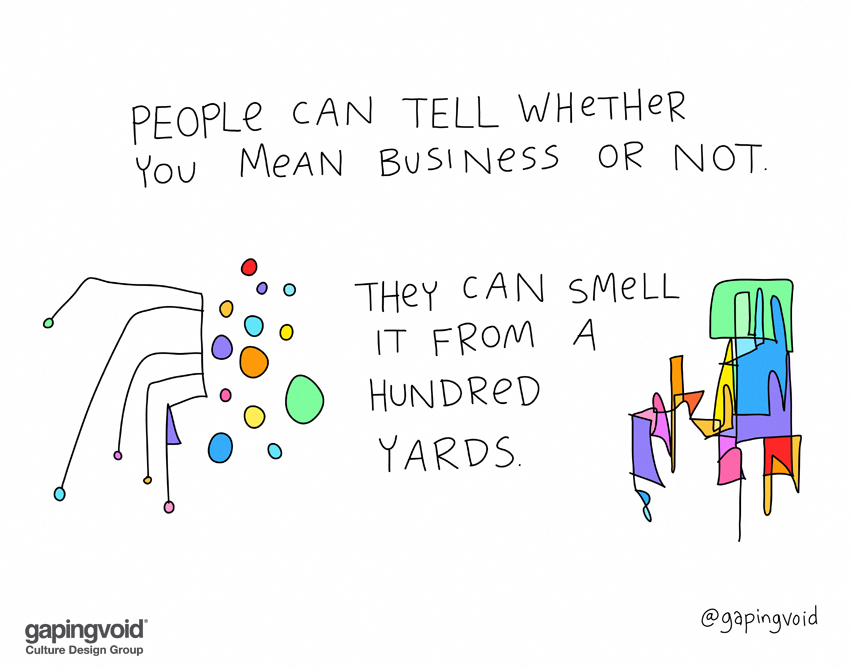
Illustration: gapingvoid
Idea Champions
Storytelling for the Revolution
Posted by Mitch Ditkoff at 12:02 AM | Comments (0)
August 28, 2018Be Yourself!
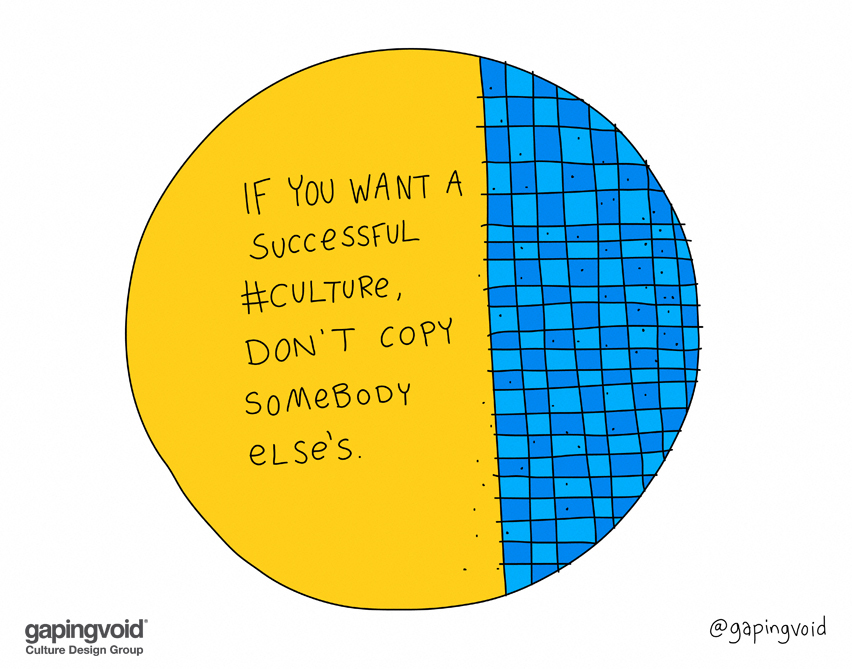
Your company is unique. Honor that uniqueness. While there is nothing wrong with benchmarking other company's best practices, be mindful not to mindlessly graft them on to your company's culture. Be who you are!
Illustration: gapingvoid
Idea Champions
Help for being who you truly are
The author of the book
Posted by Mitch Ditkoff at 06:15 PM | Comments (0)
June 20, 2018How to Spark Innovation in Your Company in 10 Minutes Per Week

Do you work in an organization that is trying to raise the bar for innovation, teamwork, storytelling, and leadership, but doesn't have the budget to pay for trainings, keynotes, and workshops? Here's an alternative -- Idea Champions' Micro-Learning for Innovators service. It all happens online. At your own pace.
The price? YOU decide on the value of our service and make us an offer. 95% of the time we go with what our prospective clients suggest. 5% of the time we decline. Interested? mitch@ideachampions.com
Posted by Mitch Ditkoff at 10:23 AM | Comments (0)
May 15, 2018VIDEO: Nine Steps to Creating a Culture of Innovation

Big thanks to Jon Peters, of Athena Online (the Micro-Learning Gods) for getting the word out about my culture of innovation work. Click here to watch the video. And here's Idea Champions' Micro-Learning offering to help you raise the bar for innovation. Simple. Self-paced. Cost-effective. Interested? info@ideachampions.com
Posted by Mitch Ditkoff at 12:48 AM | Comments (0)
May 09, 2018An Alternative to Launching Yet Another Innovation Initiative
 Many organizations committed to raising the bar for innovation, end up launching some kind of internally branded "innovation initiative". Logically speaking, this makes sense, but logic is not the most powerful driver of innovation. Most employees cringe at the thought of yet another "initiative" being foisted on them.
Many organizations committed to raising the bar for innovation, end up launching some kind of internally branded "innovation initiative". Logically speaking, this makes sense, but logic is not the most powerful driver of innovation. Most employees cringe at the thought of yet another "initiative" being foisted on them.
So... instead of launching an initiative, help people take initiative by becoming more committed to fostering innovation in every conversation they have on the job -- something you can learn more about, in then next three minutes, by watching this newly produced 3-minute video of me addressing this topic.
Innovation from the inside out
Idea Champions
My new book
Posted by Mitch Ditkoff at 03:01 PM | Comments (0)
April 26, 2018Micro-Learning for Innovators in Just 15 Minutes Per Week
 If you are looking for a simple, inexpensive way to spark innovation in your organization in just 15 minutes per week, here it is. No workshops. No trainings. No keynotes. No complicated idea management software. No headbanging. And the first three companies that respond to this post get to name their own price. Here's what one of our happy clients says about this innovative service of ours.
If you are looking for a simple, inexpensive way to spark innovation in your organization in just 15 minutes per week, here it is. No workshops. No trainings. No keynotes. No complicated idea management software. No headbanging. And the first three companies that respond to this post get to name their own price. Here's what one of our happy clients says about this innovative service of ours.
PS: If you want to know how much it costs, text me at 845.389.9096 and I'll let you know ASAP.
The creator of this service
The company he co-founded
This might be included
10 ways to enable innovation in the workplace
Another way of thinking about time
Posted by Mitch Ditkoff at 08:24 AM | Comments (0)
April 01, 2018The 10 Personas of an Effective Brainstorm Facilitator

Allow me to make a wild guess. You have participated in more than a few brainstorm sessions in your life. Yes?
And allow me to make another wild guess. Many of those sessions left you feeling underwhelmed, over-caffeinated, disappointed, disengaged, and doubtful that much of ANYTHING was ever going to happen as a result of your participation. Yes, again? I thought so.
There's a ton of reasons why most brainstorming sessions under-deliver, but the main reason -- the Mount Olympus of reasons (drum roll, please....) is the brainstorm facilitator. Armed with a short list of ground rules, a flipchart marker, and a muffin, most brainstorm facilitators miss the mark completely.
The reason has less to do with their process, tools, and techniques than it does with their inability to adapt to what's happening, real-time, in the room. In an all-too-professional attempt to be one-pointed, they end up being one-dimensional, missing out on a host of in-the-moment opportunities to spark the ever-mutating, collective genius of the group.
If only our well-intentioned brainstorm facilitators could abide by the words of Walt Whitman, when he confessed that he "contained multitudes."
Translation? If you or anyone you know is going to lead a diverse group of time-crunched, opinionated, multi-tracking, people through a process of originating breakthrough ideas, DON'T BE A ONE TRICK PONY! Be a multitude -- or, at the very least, be multi-faceted. Let it rip. Hang ten. Pull out the stops.
Use your right brain and your left. Let all the cats out of the proverbial bag -- and by so doing, exponentially increase your chances of sparking brainpower, brilliance, and beyond-the-obvious ideas.
OK. Enough bloggy pep talk. Let's get down to business. Take a few minutes now to rate yourself, on a scale of 1-10, for how skillful you are at embodying the following personas of a high flying brainstorm facilitator. Then tune into your biggest strength and ask yourself how you can amplify that quality. Then identify your biggest weakness and figure out how you can improve in that arena.

1.CONDUCTOR
A skilled brainstorm facilitator knows how to orchestrate powerfully creative output from a seemingly dissonant group of people. In the conductor mode, the facilitator includes everyone, evokes even the subtlest contributions from the least experienced participant, and demonstrates their commitment to the whole by offering timely feedback to anyone who "gets lost in their own song."
2.ALCHEMIST
A good brainstorm facilitator is able to transmute lead into gold -- or in modern terms -- knows how to help people "get the lead out." This talent requires an element of wizardry -- the ability to see without looking, feel without touching, and intuitively know that within each brainstormer lives a hidden genius just waiting to get out.
3.DANCER
Light on their feet, brainstorm facilitators move gracefully through the process of sparking new ideas. Able to go from the cha-cha to the polka to the whirling dervish spinning of a brainstorm group on fire, savvy facilitators take bold steps when necessary, even when there is no visible ground underfoot. "The path is made by walking on it," is their motto.
4. MAD SCIENTIST
Skillful brainstorm facilitators are bold experimenters, often taking on the crazed (but grandfatherly) look of an Einstein in heat. While respecting the realm of logic and the rational (the ground upon which most scientists build their homes), the enlightened facilitator is willing to throw it all out the window in the hope of triggering a "happy accident" or a quantum leap of thought. Indeed, it is often these discontinuous non-linear moments that produce the kind of breakthroughs that logic can only describe, never elicit itself.

5.DIAMOND CUTTER
Fully recognizing the precious gem of the human imagination (as well as the delicacy required to set it free), the high octave brainstorm facilitator is a craftsman (or craftswoman) par excellence -- focused, precise, and dedicated. Able to get to the heart of the matter in a single stroke without leaving anything or anyone damaged in the process.
6. ACTOR
Brainstorm facilitators are "on stage" whether they like it or not. All eyes are upon them, as well as all the potential critical reviews humanly possible. More often than not, the facilitator's "audience" will only be moved to act (perchance to dream) if they believe the facilitator is completely into his or her role. If the audience does not suspend this kind of disbelief, the play will close early and everyone will be praying for a fire drill or wishing they were back home eating a grilled cheese sandwich.
7.ENVIRONMENTALIST
Brainstorm facilitators are the original recyclers. In their relentless pursuit of possibility, they look for value in places other people see as useless. To the facilitator in full mojo mode, "bad ideas" aren't always bad, only curious indicators that something of untapped value is lurking nearby.
8. OFFICER OF THE LAW
One of the brainstorm facilitator's most important jobs is to enforce "law and order" once the group gets roaring down the open highway of the imagination. This is a fine art -- for in this territory speeding is encouraged, as is running red lights, jaywalking, and occasionally breaking and entering. Just as thieves have their code of honor, however, so too should brainstormers. Indeed, it is the facilitator's task to keep this code intact -- a task made infinitely easier by the ritual declaration of ground rules at the start of a session.''
9.SERVANT
Some brainstorm facilitators, intoxicated by the group energy and their own newly stimulated imagination, use their position as a way to foist their ideas on others -- or worse, manipulate the group into their way of thinking. Oops! Ouch! Aargh! Brainstorm facilitating is a service, not a personal platform. It is supposed to be a selfless act that enables others to arrive at their own solutions, no matter how different they may be from the facilitator's.
10. STAND-UP COMIC
Humor is one of the brainstorm facilitator's most important tools. It dissolves boundaries, activates the right brain, helps participants get unstuck, and shifts perspective just enough to help everyone open their eyes to new ways of seeing. Trained facilitators are always on the lookout for humorous responses. They know that humor often signals some of the most promising ideas, and that giggles, guffaws, and laughable side-talk frequently indicate a rich vein of possibility to explore. Humor also makes the facilitator much more "likable" which makes the group they are facilitating more amenable to their direction. Ever wonder why the words "Aha!" and "Ha-Ha" are so similar?
The book from which the article was excerpted
Idea Champions
Our clients
What they say
Our brainstorm training
Posted by Mitch Ditkoff at 12:11 AM | Comments (0)
February 06, 2018MICRO-LEARNING for Innovators (in just 15 minutes per week)

Innovation is a huge topic in organizations these days. Every company is looking for new and better ways to do more with less, differentiate themselves from the competition, and unlock the hidden genius of their workforce.
At the same time, many organizations are budget-constrained. Flying in an outside consultant to lead a workshop or training can sometimes be cost prohibitive. This I understand.
Which is precisely why my company, Idea Champions, is now offering Micro-Learning for Innovators, a cost-effective way to stir the innovation soup -- a virtual, self-organizing, just-in-time way to increase everyone's ability to be a proactive innovator on-the-job. And it only takes 15 minutes per week.
TOPICS INCLUDE: Mindset, Culture of Innovation, Creative Thinking, Idea Generation, Brainstorm Facilitation, Storytelling, Leadership, Teamwork/Collaboration, Listening/Feedback, Problem Solving

HOW IT WORKS:
1. You and I have a 20-minute phone conversation about WHY you want to raise the bar for innovation and creativity in your organization.
2. Based on your needs, I create a year-long, customized Micro-Learning for Innovators curriculum for you -- a landing page of links to 52 engaging articles and videos of mine on the topic (curated from more than 1,200 I have produced).
3. Each week (or month), for the next year, you forward selected links to your team (or whatever part of your workforce is participating in the program.)
4. Participants read/view the link(s) in preparation for their meeting (real-time or virtual) that you or one of your surrogates facilitates. All you need to reserve on your agenda is 10 minutes for the innovation topic. NOTE: This is micro-learning, not head-banging.
5. You (or your designated meeting moderator) facilitates the innovation-topic-of-the week conversation. This deepens learning, quickens the sharing of best practices, sparks creative thinking, ensures accountability, and establishes a robust, intrinsically motivated learning community.
OPTION #1: I send you a simple "Moderator's Guide" that helps ensure your weekly innovation-sparking conversations are as effective as possible.
OPTION #2: I participate on your launch call to help you set the context, inspire participation, and answer any questions your people might have about the value, purpose, and process of the program.
OPTION #3: At TBD intervals, throughout the year, you invite me to facilitate one of your online meetings/trainings.
FEE: Name your own price for an annual license. (In other words, you quantify the value of my service to your organization and make me an offer. If it's "in the zone," I will say YES. If your offer is below what I consider fair, we will talk and see if we can come to an agreement.
WHO CREATED THE PROGRAM? Mitch Ditkoff, Co-Founder of Idea Champions, Author of the two award-winning winning books on innovation and storytelling. Creator of a wide variety of storytelling workshops and keynotes. Innovation Blogger of the Year, two years running. Master storyteller. His clients.
Interested? email Mitch today: mitch@ideachampions.com
Our clients
What they say
Our workshops and trainings
One of our micro-learning partners
Posted by Mitch Ditkoff at 09:02 AM | Comments (0)
January 25, 2018ANONYMOUS REVEALED

I have a confession to make. Actually, it's more like a revelation than a confession.
You know all those fabulous quotes and articles you've read over the years with no attribution other than "Anonymous"? It was me. It's true. I have written thousands of things I've never signed my name to. I couldn't. I mean -- the writing just came through me. Like a storm. In fact, I was in such a state of presence as these pearls of wisdom appeared, there wasn't even a "me" involved, so how could I sign my name?
So I did the only thing I could do -- and that was to sign what I wrote with the now all-too-familiar word "Anonymous".
Please don't get me wrong. I'm not complaining, nor do I have any regrets about my selfless decision. It felt right at the time. But now, with the economy slowing down -- it's starting to make sense that I claim what is rightfully mine.
After countless hours of consultations with pundits, epistemological savants, numerologists, and intellectual property lawyers, I've arrived at an approach that is not only honorable and fair, but flawless and timely with absolutely no carbon footprint. Nor were any animals harmed in the writing of this paragraph.
I am pleased to announce that YOU, dear reader, get to play a key role going forward -- one that will take you less time than it will to order a take-out pizza.
Since I am claiming no royalties whatsoever from my past writings (many of which, by the way, went on to become blockbuster movies, novels, bumper stickers, and refrigerator magnets), I think it is only fair to request that every time you forward anything attributed to "Anonymous" you link it to this page -- a promo for my new online creativity course -- soon to be offered as a subscription service
My goal? To model what it's like to claim one's true inheritance and take the risk that this post will go viral and I will have to answer a lot of questions from slick talk show hosts more interested in their own TV ratings than my no longer anonymous success.
A small example of what I've never been paid for
Posted by Mitch Ditkoff at 09:37 PM | Comments (8)
January 23, 20185 Inexpensive Ways to Jump Start a Sustainable Culture of Innovation

Trying to create a culture of innovation is a daunting task for even the most committed organization. Cultures take decades to form. Changing them is not an overnight phenomenon, no matter how many outside consultants you've gotten on the case. You might as well try to end world hunger or wipe out Aids overnight. It's gonna take a while.
But if you and your colleagues are game, culture change is possible. The question, of course, is where to begin? Starting is always the hardest part. And, in the absence of clarity about where to start, procrastination creeps in -- and nothing changes.

OK. Enough preamble. Here are five ways to get started. Pick one or all five -- and don't forget to enjoy the process.
1. Name the Beast: If you want to change something, you will need to begin by understanding the current reality of that which you attempting to change. Make sense?
If you're getting into a new market, for example, you'd expect to do some competitive intelligence gathering, right? And if you've decided to parachute into Iran, it would make sense to do some diligence, before hand, no?
Same with the effort to foster a culture of innovation.
Get closer to the problem. Talk to people. Survey your workforce. Get everyone talking -- not just the C-Suite folks, but the people in the mail room, too.
Get off of the generic, politically correct stand that may be ruling the day and get down to the bones.
Then, when you make your case, more formally, you'll have some meaningful ground to stand on -- and the people listening will listen deeper than if you merely showed up one day with a few powerpoint slides, an anecdote from Google, and your newly expressed burning passion for the cause.
2. Set the Expectation: You get what you expect. That's the deal. Psychology experiment after psychology experiment has borne this out again and again.
You need a very strong intention to do this work and then you need to communicate it in a way that is compelling.
Your workforce needs to understand this is not the job of senior leadership, or HR, or R&D. It's everyone's job. Only when a critical mass of people in your organization embraces this effort will anything substantial happen.
If not, you will be wasting your breath -- and their time.
3. Define Innovation: Google "innovation" and you'll find thousands of definitions.
What do you mean by "innovation?" What is your definition? How do you want people thinking about it?
Is it incremental innovation? Disruptive innovation? Product innovation? Process innovation? Or is the whole thing really just a secret code for "cost cutting?"
Before anything significant can happen, you'll need to get aligned with your senior team about what, precisely, you mean by innovation -- and then communicate that, with some passion, to the workforce.

4. Frame the Challenges: OK. Let's say you want a sea change of innovation within your organization. Great. But in what specific domains? What are the specific challenges people can get their arms around and actually focus on?
As Charles F. Kettering once said, "A problem well-defined, is a problem half solved."
Towards that end, you and your team will need to dive in and start framing the problem. Not vaguely. Not generically. Very specifically. The clearer you are about communicating the domains in which you are asking people to innovate, the more results will show up.
The framing of the challenge, however, is not just your job. You'll need to invite others to get into the act.
If you've done your "name the beast" effort (see #1), this should be relatively easy.
5. Acknowledge What's Already Working: Lots of organizations who dive into the deep end of "culture change" have a tendency to get a sudden case of amnesia when it comes to their corporate history.
Inspired by the promise of the new, they forget to acknowledge the old -- paying precious little attention to what's already working well.
There are a ton of best practices already going on in your organization. There are many inspired "pockets of creativity" where turned-on-teams are doing exactly what they need to do to succeed.
The only thing is: very few people in the company know about this.
Everyone is so enmeshed in their own silos, that they have no clue what innovation-friendly behaviors are alive and well just down the hall -- behaviors they can learn from, adapt, and get rolling within their own spheres of influence.
Building on past successes will not only encourage people, it will guide their journey forward in ways that are empowering, uplifting, and real. And while you're at it, don't forget to routinely acknowledge current successes, as well -- the good things that happened today.
Thanks to Tim Gallwey for his refinement of #5.
Posted by Mitch Ditkoff at 02:58 PM | Comments (0)
December 06, 2017Why AHA and HAHA Are So Related

I don't think it's an accident that "aha" and "haha" are both almost spelled the same way. Indeed, there is a deep relationship between the Eureka moment and humor -- which is one of the reasons why Isaac Asimov once said "The most exciting phrase in science is not 'Eureka', but 'That's funny!'" And why? Because when something strikes you as funny it is often an indication that your assumptions are being challenged, as in what you were expecting to see was nothing more than a false conclusion cobbled together by the habitual ways in which you interpret the "data."
When a person has a Eureka moment (i.e. Archimedes in the bathtub, Newton under the apple tree), he or she experiences something that surprises them -- something beyond their logic and expectations. In a word, they are "dislocated" from their normal reality and it is this dislocation that sparks a new kind of perception.

It's the same with humor. When a person laughs upon hearing a story or a joke, it is usually because the storyteller or comedian, "dislocates" the listener. The listener is "set up" so to speak, lulled into believing the story or joke is going in one direction, only to have the logic of what they are listening to veer off in another direction. This unexpected moment of surprise often results in an involuntary reaction called "laughter." Indeed, it is the unexpected left turn or right turn that the storyteller makes -- via a well-told punchline -- that triggers a great release of laughter in the listener.
Bottom line, the AHA moment and the HAHA moment are both powered by the same phenomenon -- an unexpected turn of events... a surprise... a dislocation... and a sudden perceptual shift that opens the mind to new ways of seeing and feeling.
If you want to see your team, department, or organization be more innovative, consider bringing more humor into the workplace -- more opportunities for people to play with possibilities instead of being stuck in the "nose to the grindstone" position -- which, by the way, may give the appearance that people are working when, in fact, they are merely surviving. People who are laughing on the job are not necessarily slackers or goofballs. They may, in fact be out-of-the-box thinkers on the brink of a breakthrough.
A CEO, an ice skater, and proctologist walk into a bar...
Idea Champions
MitchDitkoff.com
What's funny about Ravel's Bolero
Posted by Mitch Ditkoff at 06:46 PM | Comments (0)
December 04, 2017Ask for Permission to Facilitate

Here's a useful tip for you the next time you find yourself standing in front of a group of people and about to facilitate a meeting of any kind: Before you begin, ask people to give you permission to facilitate.

This may sound like a complete waste of time, especially if you've been brought in by the powers-that-be to facilitate the meeting, but it's not. It's essential. Here's why:
If your meeting is anything like the other 11 million meetings being held each day in corporate America, chances are good that there will be a time during your gathering when at least one person -- bored, cranky, distracted, or angry that they weren't asked to facilitate, will do something (consciously or unconsciously) to derail the session.
This something can take many forms -- everything from incessantly checking email under the table... to returning late from breaks... to ranting on any number of topics that have absolutely nothing to do with the matter at hand -- moments that will require a skillful and well-timed response from the facilitator.
If you haven't bothered to ask for permission to facilitate, people will resist (or ignore) your spontaneous interventions every step of the way. And if they don't resist you every step of the way, they will silently retreat into their own private Idaho, perceiving you, in their fevered mind, as an invasive, disempowering, or egomaniacal facilitator.
Bottom line, you will lose them.
And, if the people you lose should happen to be "tribal chieftains" of any one of the many feudal kingdoms represented in the room that day, you will lose a bunch of other people, as well. Their minions.
This is not the outcome you want -- an outcome that will lead you to triangulating to third parties or wishing you had gone into your father's dry cleaning business.
The way out of this mess? Simple.
Within the first five minutes of your meeting, after establishing a few simple ground rules, let everyone know that you need their permission to play your facilitator role -- that there may be some times, during the meeting, when you may have to ask someone to hold a thought or shift their behavior in some way ... and that unless you have their permission to do so, they will likely end up resenting you or feeling mistreated when, in fact, all you are trying to do is ensure that the meeting is a productive one.
Invariably, meeting participants will gladly give their permission for you to facilitate, even if they chuckle, under their breath, while doing so. And if they just sit there, silently, after your request -- bumps on an analog -- all you need to do is ask them to give you some kind of visible indication that they agree -- either by standing up or giving you the "thumbs up".
This simple act of people visibly giving you permission to facilitate is often the difference between success and failure -- especially when, later in the meeting, someone starts acting out or marching to a drummer from another planet.
Armed with the permission they gave you at the beginning of the meeting, all you need to do is reinforce the ground rule that's been forgotten and remind them that all you're doing is playing the role they gave you permission to play in the first place.
Works like a charm every time.
Idea Champions
A good meeting
MitchDitkoff.com
Posted by Mitch Ditkoff at 11:18 PM | Comments (0)
November 30, 2017The Idiot Savant's Guide to Accelerating Culture Change

Imagine that you have been tasked with the challenge of addressing the need for "culture change" within your team, department, or entire organization. I'm assuming you didn't go to graduate school in "culture change" and that you also have a lot of other stuff on your plate. Correct? I thought so. Yours is a curious challenge that will require major clarity on the front end, skillful facilitation in the middle, and meaningful follow-up on the back end.
"Corporate culture change" is a head banger. It's easy to talk about, but hard to pull off. To increase your odds of success, lower your stress, and help you navigate your way through the maze, here are seven points to consider -- a homeopathic dose of what I've learned since 1987, providing various innovation sparking services to a whole bunch of forward thinking companies. Ready? Probably not, but keep reading anyway.
1. ENSURE SENIOR TEAM ALIGNMENT/SUPPORT: Are your key stakeholders on board about the culture change effort? Are they all on the same page? Are they willing to make a different kind of effort in order to raise the odds of the effort sustaining over time? Too often, "culture change" is a can kicked down the road. Senior Leaders, if they are really serious about seeing meaningful change, need to step up and OWN the effort more than they currently do. How this translates into action, is TBD, of course, but the effort will not sustain if your Senior Leaders are simply delegating their responsibility to their direct reports. Here's my rant on the topic.

2. LISTEN TO YOUR WORKFORCE. GIVE THEM A CHANCE TO WEIGH IN: The more the "rank and file" gets a chance to share their insights, needs, and perceptions, the better chance you have of succeeding. People usually take more responsibility for a goal/vision/challenge if they have been consulted on the front end. Also, your Senior Leaders will likely learn a lot more about the current reality of the situation if they provide a way for the people on the front lines to speak up and be heard. This can happen via focus groups, one-on-one interviews, or online polling. Here's how we do it.
3. CLARIFY YOUR HOPED FOR OUTCOMES: Imagine that your culture change efforts are a resounding success. How will you know? What will be different? In what ways will you quantify progress? The clearer you and Senior Leaders are about the end game, the more effective the process of getting there will be.
4. FRAME YOUR CHALLENGE ACCURATELY: Can you phrase your goal/challenge/problem as a question that starts with the words "How can we?" If you can't, take some time to get the right question. Then check in with other key stakeholders and see if your HOW CAN WE question is the same one that they think is the issue. If not, tawk amongst yourselves until you can agree on what the REAL question is. And, if there is more than one question/challenge/problem on the table, so be it.
5. DECIDE ON THE RIGHT MIX OF PEOPLE TO MEET: If you have 150 people in the soup, what are the sub-groups that make the most sense to be participate in the same, real time session? All 150 at once? Two sessions of 75? Three sessions of 50? Five sessions of 30? Size matters. So does the mix of people in the room. Assuming that all groups go through the same process, what groupings of people make the most sense -- and over what period of time?
6. CLARIFY YOUR FOLLOW UP STRATEGY: If you want your culture change efforts to sustain, start thinking about how your real-time sessions are going to be followed up. Will people be working in small teams on specific projects? Will there be any accountability? Will selected managers be expected to coach and/or monitor/acknowledge progress? Does it make any sense to offer people an online innovation-sparking curriculum? Also, it may make sense to establish an Innovation Council to keep things moving forward.
7. IDENTIFY YOUR BUDGET: Ah... the "B" word! How much money does your company have to invest in your TBD change process? This number will determine which of the above-mentioned variables get attended to or not -- and how deeply. NOTE: These days, I use the Gordian Knot One Sword Stroke approach, instead of endless proposal writing -- wasting your time and mine, here's an alternative approach: You tell me what your budget is. I tell you what Idea Champions can do within those budgetary constraints. Simple.
What our clients say
56 reasons why most corporate innovation efforts fail
Comic relief
Posted by Mitch Ditkoff at 02:53 PM | Comments (0)
November 28, 201712 Ways to Make Bad Decisions
 There are three things that astound me about most organizations: The cro-magnon way performance reviews are done; the pitiful way brainstorm sessions are run and; the voo doo way decisions are made.
There are three things that astound me about most organizations: The cro-magnon way performance reviews are done; the pitiful way brainstorm sessions are run and; the voo doo way decisions are made.
What follows is an elaboration of the third -- 12 common phenomena that contribute to funky decision making. As you read, think of the teams you work most closely with, which of these behaviors describes them, and what you can do to change the game.
1. Selective Search for Evidence: Gathering facts that support pre-determined conclusions, but disregard other facts that support different conclusions.
2. Premature Termination of Search for Evidence: Accepting the first alternative that looks like it might work.
3. Inertia: Being unwilling to change old thought patterns.
4. Selective Perception: Prematurely screening out information not assumed to be useful.
5. Wishful Thinking: Wanting to see things in a positive light.
6. Recency Effect: Putting undue attention on recent information and experience while minimizing the value of information collected in the past.
7. Repetition Bias: Believing what's been stated the most often and by the greatest number of sources.
8. Anchoring and Adjustment: Being unduly influenced by initial information that shapes your view of subsequent information.
9. Group Think: Conforming to peer pressure or the opinions of the majority.
10. Source Credibility: Rejecting input from sources prematurely judged to not be credible (or not "cool" or "in sync with the way you do business.")
11. Attribution Asymmetry: Attributing success to your team's abilities and talents, but attributing failures to bad luck and external factors.
12. Role Fulfillment: Conforming to the decision making expectations others have of someone in your position.
In what ways might you improve your team's decision making process?
Idea Champions
MitchDitkoff.com
Posted by Mitch Ditkoff at 11:28 PM | Comments (1)
November 17, 2017On Being a Better Listener

Good article from Fast Company on the emotional intelligence required to be a better listener.
If you want to innovate, listen more
24 quotes on good communication
Non-judgmental listening
Posted by Mitch Ditkoff at 06:13 PM | Comments (0)
November 08, 2017VOICE AMERICA RADIO INTERVIEW with Mitch Ditkoff on Fostering a Culture of Innovation

Here's everything you wanted to know about how to foster a culture of innovation in your organization -- a 56-minute VOICE AMERICA radio interview with Mitch Ditkoff, Co-Founder and President of Idea Champions and the writer of this blog. OK. maybe it's not everything you wanted to know, but at least it's trending in that direction. (Please forgive me for using the word "trending". I don't like that word. It just kind of slipped out).
The main thing? Click the link above and listen to the interview. Good food for thought -- something you might want to forward to you manager or other senior leaders in your company -- especially if they are claiming some interest in the "innovation thing."
Idea Champions
Culture of Innovation workshop
MitchDitkoff.com
Posted by Mitch Ditkoff at 01:54 AM | Comments (0)
November 05, 2017Beyond Sage on the Stage Consulting

To borrow a phrase from the radically changing world of healthcare -- the essence of organizational culture change can be boiled down to three words: "Physician heal thyself"-- as in companies restoring optimum health to their enterprise from the inside out.
While many patients, anxious about their well-being, simply want the doctor to tell them what to do, that is, ultimately, a prescription for failure. Sustainable change only happens when people take full responsibility for their own condition.
Being told to "take two aspirins and see me in the morning" by someone with a framed medical school degree above their desk may be comforting in the short-term, but it completely misses the point. It's a paradigm whose time has come and gone.
The long and disappointing history of "change initiatives" bears this out. The data is there. 70% of them fail. And the main reason why 70% of them fail is because most organizations who enter into the culture change process rely too much on outside "experts" who, invariably treat their "patients" as someone incapable or unwilling to heal themselves.
Does the phrase "co-dependence" ring a bell?
If you expect your organization to make the kind of changes required for it to succeed, long-term, know this: the outside consultant as prescriber model (referred to in the OD world as "sage on the stage") has got to go. It will not work.
We understand, of course, that your company's Senior Leaders need some kind of roadmap or blueprint to help them navigate their way forward. They are not about to embrace an "organic process" that does not frame out the strategies and tactics required to help their company become an agile, innovative, best-company-to-work for enterprise.
This we understand. And, we will be happy to provide you with a blueprint.
But please understand this: embedded into the DNA of our blueprint is the highly collaborative process of co-creating the blueprint with you, your Design Team, and selected Senior Leaders.

We are not prescribing two aspirins. We are not asking you to call us in the morning so we can prescribe two more aspirins or a tourniquet. We are engaging you in a dynamic, interactive, collaborative partnership to ensure that the effort made is genuine, robust, and sustainable.
And that only happens when a critical mass of people in your organization are deeply engaged in the change process from the very beginning. No aspirins required.
This is the primary difference between our approach and traditional "sage on the stage" consulting.
And while we're at it, here's another way to think about the choices before you -- vacations.
Some people like to go on Safaris. Some people like to go to 5-Star hotels.
On Safari, everything is not always neat and clean. Conditions change. Weather shifts. The road is often bumpy. There are unknowns and surprises that require flexibility, adaptability, and in-the-moment decision making.
In a 5-Star hotel, everything is buttoned down, pre-programmed, and effortless. Indeed, that is what 5-Star Hotel customers are paying for -- for someone else to do the work, someone else to cook the food, someone else to make the bed. We get it.
But a large scale, organizational change effort is not a 5-Star Hotel
It is more like a Safari. And while there are definitely best practices to abide by and time-tested principles to be guided by, success cannot be prescribed by a third party -- especially if you are committed to internalizing the mindset, skills, tools, and processes, needed for you organization to make this their own, replicable process in the years to come.
Make sense?
Idea Champions
What we do
What our clients say
Posted by Mitch Ditkoff at 12:44 PM | Comments (1)
November 04, 2017The Growing Relationship Between Storytelling and Lean Six Sigma

These two Lean Six Sigma practitioners walk into a bar. Wait... no... I mean three Lean Six Sigma practitioners walk into a bar. The first is wearing pink tights. The second is mumbling something about a fishbone diagram. The third is just back from a 10-day vacation in Croatia. Now that I have your attention, click here for a rousing 60-minute webinar on the relationship between storytelling, innovation, and Lean Six Sigma. The interviewer? The fabulous Elisabeth Swan, Managing Partner of GoLeanSixSigma. The interviewee? Mitch Ditkoff, President of Idea Champions and author of Storytelling at Work. Enjoy!
Posted by Mitch Ditkoff at 04:16 AM | Comments (0)
October 28, 2017Innovation from the Inside Out

These days, almost all of Idea Champions' clients are talking about the need to establish a culture of innovation. Some, I'm happy to report, are actually doing something about it. Hallelujah! They are taking bold steps forward to turn theory into action.
The challenge for them is the same as it's always been -- to find a simple, authentic way to address the challenge from the inside out -- to water the root of the tree, not just the branches.
External systems and protocols, no matter how seductive they are to create, are simply not sufficient to guarantee real innovation. In the words of Oliver Wendell Holmes, "Systems die. Instinct remains."
This is not to say that organizations should ignore systems and structures in their effort to establish a culture of innovation. They shouldn't. But systems and structures all too often become the Holy Grail -- much in the same way that Six Sigma has become the Holy Grail.
Unfortunately, when the addiction to systems and structures rules the day, an organization's quest for a culture of innovation degenerates into nothing much more than a cult of innovation.

Organizations do not innovate. People innovate. Inspired people. Fascinated people. Creative people. Committed people. That's where innovation originates -- from deep within the inspired individual who understands that his/her sustained effort is what's required to go beyond the status quo.
The organization's role -- just like the individual manager's role -- is to get out of the way. And while this "getting out of the way" will undoubtedly include the effort to formulate supportive systems, processes, and protocols, it is important to remember that systems, processes, and protocols are never the answer. They are the context, not the content. They are the husk, not kernel. They are the menu, not the meal.
Ultimately, organizations are faced with the same challenge that religions are faced with. Religious leaders may speak passionately about the virtues their congregation needs to abide by, but sermons only name the challenge and remind people to experience something -- they don't necessarily change behavior.
Change comes from within the heart and mind of each individual. It cannot be legislated or evangelized into reality.
What's needed in organizations who aspire to innovation is an inner change. People need to experience something within themselves that will spark and sustain their effort to innovate -- and when they experience this "something," they will be self-sustaining.
They will think about their projects in the shower, in their car, and in their dreams. They will need very little "management" from the outside. Inside out will rule the day -- not outside in. Intrinsic motivation will flourish.
People will innovate not because they are told to, but because they want to. You can create all the reward systems you want. You can reinvent your work space until you're blue in the face. You can license the latest and greatest idea management tool, but unless each person in your organization OWNS the need to innovate and finds a way to tap into their own innate brilliance, all you'll end up with is a mixed bag of systems, processes, and protocols -- the husk, not the kernel -- the innovation flotsam and jetsam that the next administration or next CEO or next key stakeholder will mock, reject or change at the drop of a hat if the ROI doesn't show up in the next 20 minutes.
You want culture change? You want a culture of innovation?
Great. Then find a way to help each and every person in your organization come from the inside out. Deeply consider how you can nurture, and develop the primal need all people have to create something extraordinary.
What is the simplest thing you can do, today, to spark innovation on your team?
Posted by Mitch Ditkoff at 10:58 AM | Comments (10)
August 01, 2017Watch These Videos If You Want to Foster a Culture of Innovation

If your organization (or any department, therein) is interested in establishing a culture of innovation, you may want to take a few minutes now to view the following brief (less than 8 minutes each) videos on the topic. The intention to raise the bar for innovation is, indeed, a noble one, and I applaud you for taking on the challenge. That being said, the effort required to achieve any kind of measurable results needs to be well-considered before jumping in with both feet.
Cultivating a Culture of Innovation
Organization Do Not Innovate. People Innovate.
The Six Sides of the So-Called Box
The Seed of Innovation Moment
The Dark Side of Innovation Initiatives
Posted by Mitch Ditkoff at 08:59 AM | Comments (1)
June 14, 2017The Most Important Ingredient to Ensure an Organization's Success

In a recent survey of 246 CEOs from around the world, "having the right culture to foster and support innovation" was rated the most important ingredient to ensure a organization's success. In other words, if innovation is the big fish companies are trying to hook, culture is the ocean in which those fish are swimming.
Changing a company's culture, however, is not an easy thing to do. When you think about how difficult it is for just one person to lose five pounds or stop smoking, imagine the challenge of getting thousands of people to go beyond their old habits and outdated mental models. That being said, it IS possible.
The key to success? Beginning. And the key to beginning? Giving people a simple roadmap of what they can do, within their sphere of influence, to make a difference
This is what Mitch Ditkoff's Jump Starting a Culture of Innovation keynote is all about. Each person in the audience exits the keynote not only with fresh insights, inspiration, and ideas about what they can do to move the needle, they craft a personalized game plan for how to actually make it happen.
Tell us about your need
50 Ways to Foster a Culture of Innovation
The Four Currents of a Culture of Innovation
Posted by Mitch Ditkoff at 04:28 PM | Comments (0)
May 16, 2017On Building the Case for Storytelling
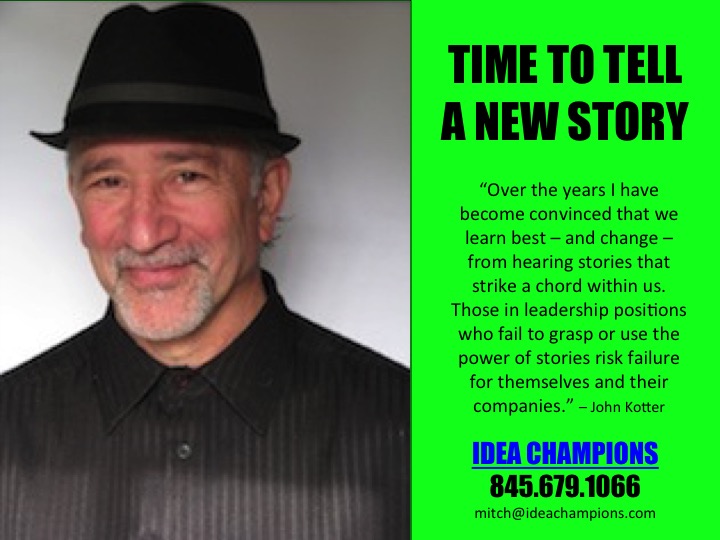
One of the biggest challenges that internal change agents have when it comes to fostering a culture of storytelling in the workplace is building the business case -- why it matters and what the impact can be. The quote below, from John Kotter, author of Leading Change, will help. If you need help building your case, shoot me an email and I will send you some more "grist for the mill" -- links to compelling articles and videos on the topic.
Storytelling at Work: the blog
Storytelling at Work: the book
The author of both
Posted by Mitch Ditkoff at 08:06 AM | Comments (0)
April 22, 2017FREE ONLINE POLL: How to Improve Your Company's Ideation Process

Here's the simplest way to figure out how to improve your company's ideation process: Enter Idea Champions' FREE IDEATION POLL CONTEST. Just send an email to office@ideachampions and write "Ideation Poll" in the subject line. We'll put your name in the proverbial hat on May 1st and, blindfolded, pick out three winners.
If YOU are one of the winners, we'll send you a link to our ideation poll which you, in turn, will forward to your workforce. A week after that we'll send you the results along with a some useful "food for thought". The value? You will better understand where the holes are in your company's idea generation bucket so you can patch them up or begin figuring out how to get a different bucket. Sneaky marketing shtick from us? None. Nada. Zero. Zilch.
What our clients say about us.
50 quotes on the power of ideas
More about ideation process
Posted by Mitch Ditkoff at 01:34 PM | Comments (0)
March 24, 2017Free Online Innovation and Creativity Summit 2017
Here's Nick Skillicorn introducing the upcoming, online Innovation and Creativity Summit 2017. I am happy to announce that I will be one of the 45 presenters. My topic? The power of storytelling to spark innovation. Cost? Zero. Zippo. Zilch. Click here to register. Summit begins on April 2.
MitchDitkoff.com
Storytelling at Work
Posted by Mitch Ditkoff at 10:53 AM | Comments (0)
March 07, 2017Innovation Begins with Fascination

I own a huge library of books on innovation. Mostly hardcover. The $27.95 variety with big indexes and forwards by people who make more money than I do. Some of these books are actually good. Most of them bore me. (I must confess I have a secret desire, whenever I enter a bookstore, to put glue between pages 187 & 188 in all of the new releases just to see if the publishers get any complaints).
The books attempt to describe the origins of innovation. You know, stuff like "the innate human impulse to find a better way" and "the imperative to find a competitive edge." That sort of thing.
Corporate-speak, in other words.
In my experience, the origin of innovation is fascination -- the state of being intensely interested in something. Enchanted. Captivated. Spellbound. Absorbed. What kids are naturally good at.
Kids and those mavericks at workwho make everyone nervous and running for their spreadsheets at the drop of a hat.A person who is fascinated does not need to be motivated... or managed... or "incentivized."
All that person needs is time, some resources, meaningful collaboration, and periodic reality checks from someone who understands what fascination is all about.
That's why Google gives its workforce 20% of their time to explore projects on their own. That's why 3M and W.L. Gore do something similar. They know that the root of innovation is fascination.
If you, or the people who report to you, are not currently in a state of fascination it's time to turn things around. That is, IF you want to spark some innovation.
How do you do this? For starters, try this simple exercise:
THE SEED OF FASCINATION
1. On a piece of paper, create three parallel headlines -- "What Fascinates Me," "People I Admire," and "What I Would Do If I Knew I Couldn't Fail."
2. Jot down at least five responses beneath each headline.
3. Look for intriguing, new connections between your responses. Any insights? Ahas?
4. Jot down your new ideas.
5. Circle your favorite idea and brainstorm it with a friend. Then pitch anyone who's influence can help you launchyour ideas for how to bring more fascinating projects into your work life.
Posted by Mitch Ditkoff at 11:24 PM | Comments (7)
March 04, 2017FOSTERING A CULTURE OF INNOVATION: The Keynote

Changing a corporate culture is about as easy as getting a teenage girl to clean up her room. Translation? It's not easy.
If your organization is committed to creating a culture of innovation, you'll need to begin by getting your head out of the OD clouds, come down to earth, and roll up your sleeves. The way gardeners do. Indeed, the process a gardener goes through to get a yield is the exact same process your organization will need to go through in order to establish a culture of innovation.
And I will show you how. But more than that, I will help everyone in the audience own their role, then generate their own ideas and game plan for HOW they can turn theory into practice. Seeds are what they need, not magic pills. Fertilizer, not bullshit. I've got the fertilizer and just enough tools to help everyone break new ground in a way that engages, empowers, and enlightens. Ripe tomatoes anyone?
Here's what my clients say
Interested? Contact Mike Frick, Speaking.com
My website
Posted by Mitch Ditkoff at 04:59 PM | Comments (0)
February 20, 2017Unresolved Conflict at the Top Produces Chaos in the Middle and the Bottom

A guest post by Idea Champions' newest leadership development consultant, Dr. Barry Gruenberg.
When those in senior leadership positions avoid conflict among themselves, the unresolved conflict ripples throughout the organization and paralyzes action at every level. Key issues go unresolved and the tension at the top pervades the organization. Followers of each of the powerful protagonists must constantly demonstrate their loyalty to their sponsors in their words and deeds; they must scrutinize all that they do to ensure that they are not seen as violating the party line.
Lower level employees are often enlisted to participate in task forces or committees to deal with the various by-products of the unresolved issues.
These efforts are virtually guaranteed to fail since any recommendations for resolution will compromise at least one of the contending senior managers who will usually use their power to veto the idea, leaving the task force frustrated and progress hindered.

This is ironic because the members of the task force will have attempted to remain loyal to their constituency throughout the proceedings and will usually feel that they have salvaged the most important interests of their group in the negotiation process. But the senior managers, who have delegated their conflict, will generally take an all or nothing posture on the outcome.
The only true resolution to this phenomenon requires the direct participation of the protagonists -- their committed effort to resolve their differences before the symptoms of their misalignment irrevocably muddies the organizational waters.
Idea Champions
Becoming an Adaptive Leader
Listening With Impact
Posted by Mitch Ditkoff at 09:07 AM | Comments (0)
October 07, 2016It All Began With Balls
Here's a fun, 7-minute story about Idea Champions big breakthrough soon after we started the business -- inspiration for YOU to do something different, provide your clients an EXPERIENCE, and have some fun along the way. "If you always do what you've always done, you'll always get what you've always got."
This story in the Huffington Post
Excerpted from this book
Posted by Mitch Ditkoff at 07:59 AM | Comments (0)
July 30, 2016Why Your Organization Needs to Create a Culture of Storytelling
Why create a culture of storytelling?
Storytelling videos, interviews and articles
Sparking innovation via storytelling
Idea Champions
Posted by Mitch Ditkoff at 10:42 AM | Comments (0)
June 07, 2016HOW TO GET PEOPLE OUT OF THE BOX: A 5-Minute Tutorial

Ever heard the expression "get out of the box?" Of course you have. Ever wonder what the six sides of that so-called box actually are? If not, here's your 5-minute tutorial of the day. Once you're clear about what the sides of the box are, you will be significantly more able to help people (and yourself) get out of it.
One way to get out of the box
Another way
My book on the subject
Boxes
Posted by Mitch Ditkoff at 11:24 AM | Comments (0)
March 02, 2016WOOF! Go Beyond Your Pet Ideas!

If your company runs brainstorming sessions, know this: too many of them have become veiled opportunities for people to trot out their pet ideas.
Because everyone is so ridiculously busy these days and real listening is at a premium, people use brainstorming sessions as a way to foist their pre-existing ideas on others.
And while this sometimes leads to results, it doesn't make best use of the opportunity a brainstorm session provides. The way around this phenomenon?
Give people a chance to express their pre-existing ideas at the beginning of a session. Clear the decks. Then use the rest of the time to explore the unknown. Woof! Woof!
High Velocity Brainstorming
Conducting Genius
Idea Champions
Posted by Mitch Ditkoff at 07:48 AM | Comments (2)
January 26, 2016Story as a Leadership Tool
Here's a lovely animated intro to why STORYTELLING is such a powerful communication and business tool -- by the author of Circle of the 9 Muses.
Storytelling at Work
More useful links about storytelling
And more
Posted by Mitch Ditkoff at 06:44 PM | Comments (0)
January 12, 2016How Storytelling Shapes Culture and Humanizes the Workplace

More goes on in the modern-day workplace than meets the eye. Indeed, it's often the stuff that meets the ear that makes all the difference. Click here to listen to Mitch Ditkoff's 60-minute VoiceAmerica interview on the power of personal storytelling in the workplace.
THE BOOK: Storytelling at Work
THE KEYNOTE: Storytelling at Work
THE BLOG: Storytelling at Work
Posted by Mitch Ditkoff at 01:50 AM | Comments (2)
September 15, 2015The Art of Sparking Innovation
When my mother was alive, she told me she had no idea what I did for a living. Around the canasta table, she would tell her friends I was a "motivational speaker", no matter how many times I explained what I actually did. The slide show below is dedicated to her and to YOU, too -- especially if you're wondering what the heck goes on in one of Idea Champions' innovation-sparking workshops. Best to view full screen.
Posted by Mitch Ditkoff at 05:18 PM | Comments (0)
September 04, 2015HOW TO MAXIMIZE IDEA POWER FOR FREE: A 3-Minute Video Tutorial

Need powerful, new ideas to grow your business, solve a problem, or find a better way? Don't want to go to yet another meeting to figure things out? Start paying attention to the ideas you are conceiving away from the workplace. And encourage others to do so, as well. Here's WHY and HOW.
Idea Champions
First, identify the problem
Innovation sparking keynotes
Free online creative thinking tool
Posted by Mitch Ditkoff at 10:34 AM | Comments (0)
July 17, 2015A Creative Tip from Einstein

One way to do so
Idea Champions
We talk our walk
Brainstorm Facilitation Training
Posted by Mitch Ditkoff at 04:30 PM | Comments (0)
May 01, 2015The Professor and the Jar

A college professor stood before his philosophy class at the start of a new semester. Silently, he picked up a very large jar and filled it with golf balls. Then he asked the students if the jar was full. They agreed that it was.
The professor then picked up a box of pebbles and poured them into the jar. He shook the jar lightly, pebbles settling into the open areas between the golf balls. He then asked the students again if the jar was full.
They agreed that it was.
The professor next picked up a box of sand and poured it into the jar. He asked once more if the jar was full. The students again responded with a resounding "yes."
The professor then produced two cups of tea from under the table and poured them into the jar, filling the empty spaces between the sand. The students laughed.
"Now," said the professor. "I want you to understand that this jar represents your life. The golf balls are the important things -- your family, health, friends, and feeling of well-being. If everything else was lost and only they remained, your life would still be full."
"The pebbles are the other things that matter -- your job, your house, your accomplishments etc. The sand is everything else -- the small stuff."
"If you put the sand into the jar first," he continued, "there's no room left for the golf balls or pebbles. The same holds true for life. If you spend all your time and energy on the small stuff, you'll never have room for the things that are really important to you."
"Pay attention to the things that are essential to your happiness. Spend time with your children. Spend time with your parents. Take your spouse out to dinner. Smell the flowers. Enjoy the beauty of existence. There will always be time to clean the house and fix the disposal. Take care of the golf balls first -- the things that really matter. The rest is just sand."
One of the students then raised her hand and asked what the two cups of tea were about
The professor smiled, "I'm glad you asked."
"The tea shows you that, no matter how full your life may seem, there's always room for tea with a friend."
This story is not in my forthcoming book, but 36 others are.
Idea Champions
Posted by Mitch Ditkoff at 09:36 AM | Comments (1)
March 06, 2015How to Cultivate a Culture of Innovation

Innovation, the endless effort to find a better way, cannot be achieved by robotically lining up best practices and imitating them. The real catalyzing agent for innovation is the ground from which these best practices spring -- the confluence of purpose, people, and processes better known as culture.
From where will the next wave of groundbreaking innovation come? Not from organizations mechanically mimicking each other's best practices, but from organizations with the commitment to take their stand on ground that has been cultivated for breakthrough.
If you check the contents of the most popular books on innovation, the same topics show up again and again: strategy, systems, process, leadership, customer focus, risk, speed to market, prototyping, metrics, mass collaboration, market intelligence, technology, and creative thinking.
Yes, all of these topics are important. But none of them can take root in an organization without one fundamental element being in place -- a consciously created culture of innovation.
Is such a culture simple to create? Yes. Is it easy? No. And the reason why it is not easy is because the ground of most organizations is hard, untilled, and in major need of clearing.

The metaphor that most clearly conveys the effort required is creating a garden. To experienced gardeners, the steps needed to create a garden are simple. To the inexperienced gardener, it is a tangle of complexity. Yes, gardening demands sustained and methodical effort. And yes, sweating comes with the territory. But getting a yield -- something to harvest -- is a fundamentally straightforward task.
If your company is clear about the effort required, creating a culture of innovation (lets just call it a garden of innovation) is simply a matter of taking the time to execute each step thoroughly -- in the time honored way gardeners have always practiced their craft.
1. WHET THE APPETITE
If you are serious about being a gardener of innovation, the first thing you will need is hunger -- a real appetite for results.
Growing a garden takes sustained effort. It is hard work -- most of it unglamorous and unappreciated. Hunger for a yield is the serious gardener's real motivator. Yes, the serious gardener likes being outdoors and, yes, the serious gardener likes getting exercise, but the ultimate product of his/her labors -- the harvest -- is what it is all about.
Without this level of commitment, the gardening effort remains only a hobby and does not have the roll up your sleeves and get dirty quality so essential to reaping a result.
If your workforce has no appetite for innovation, you will need to find a way to whet it. If you choose not to, people will sit idly by, waiting for R&D, senior leadership, or the tooth fairy to lead the charge. And while they may talk about growth, shovels, and the need for bulk purchase of mulch, talk will not put food on the table.
Fortunately, somewhere, deep inside everyone in your organization is the impulse to create. This impulse is innate. Your task is to awaken this impulse and help people own the effort to innovate. If they do not own the effort, the only thing you will be eating at harvest time will be your own words. (P.S.: Winter is on the way.)
2. STAKE and PREPARE THE GROUND
Amateur gardeners, fueled by visions of ripe tomatoes, have a tendency to plant before they are really ready. Unclear about how large a garden they can sustain, unsure about what is needed to prepare the ground, unable to resist the impulse for a quick yield, they rush in willy nilly.
The result? Lots of wasted effort and the kind of sweating that signifies almost nothing. The same holds true for organizations who claim they want a culture of innovation.
The antidote is a simple, two step process (though the description of the process is much simpler than the execution).
First, an organization needs to get clear about the scope of the effort they want to make. It needs to stake its territory or, more precisely, define the fields in which it wants to innovate. (If it tries to innovate everywhere, all the time, it will only deplete its resources and exhaust its workforce.)
Secondly, it needs to prepare the ground for planting.
This task includes removing obstacles that will interfere with growth, as well as enriching the fertility of the soil. Weekend gardeners cringe at this kind of preparatory effort. It does not feel like fun and there is nothing immediately to show for it. But without this effort there will be no foundation -- no ground -- for future success.
3. FIND THE SEEDS
You can have ample space to plant a garden. You can know exactly where that ample space is. And you can have lots of fertile soil in this ample space. But unless you have healthy seeds to plant, space is all you will ever have.
If you want a garden of innovation, you need seeds. Not just one kind of seed, but many. Indeed, the more varied seeds you have, the greater your chances for an interesting yield.
In the realm of innovation, ideas are the seeds. All innovation from the inside out with an idea. Ideas are the fuzzy front end of the innovation process -- the alpha and omega of new growth. No ideas, no innovation. Its that simple.
The big question, then, is this: Where will your company get its new ideas? Is there an existing process? And if so, is this process working? Can you count on your workforce to deliver high quality, game changing ideas? Or is there something else you need to be doing in order to tap their brilliance?
4. PLANT THE SEEDS
While it is true that some seeds, spontaneously carried by the wind and landing on fertile soil, find a way to plant themselves, most gardens require that seeds be planted in a more dependable way.
If your company is sincere about its intention to create a culture of innovation, it will need to refine its seed planting process. More specifically, it will need to establish a more effective way for the carriers of seeds to increase the odds of those seeds taking root.
Yes, aspiring innovators will need to become more adept at pitching/planting their ideas. But at the same time, the people to whom new ideas are being pitched will need to become more receptive to the possibility that something new is worthy of taking root.
Having a silo of healthy seeds is a good start, but ultimately those seeds need to be planted -- and they need to be planted in a way that will radically increase the odds of them growing into seedlings.
5. FENCE THE GARDEN
If you have ever planted a garden, you have experienced the phenomenon of uninvited predators showing up at all hours to devour your tender, young seedlings. Deer, raccoons, moles, rabbits, and a host of other unidentifiable varmints seem to have no other mission in life but to downsize your dreams of winning the state fair or, at the very least, eliminate all possibility of you having fresh lettuce for dinner. It comes with the territory. And it will continue to come with the territory unless you fence your garden.
Organizations of all shapes and sizes experience the same phenomenon.
Promising new business growth ideas -- the tasty indicators of breakthrough innovation -- are routinely devoured by ravenous corporate naysayers. That is, unless the organization finds a way to protect their aspiring innovators.
Your role, as a gardener of innovation, is to fence your garden and protect your people from the overly acidic scrutiny, doubt, and premature evaluation of predominantly left brained, metric driven, analytical inhibitors of innovation. It can be done. It must be done. And you are the one to champion the process.
6. TEND NEW GROWTH
Conceiving a garden is relatively easy. It requires no special skills, discipline, or education. Anyone can do it. Indeed, anyone does do it every single Spring and Summer. Getting a harvest, however, is an entirely different matter. It is not so easy -- and unlike conception, requires skill, discipline, resources, and the ability to learn on the job.
In the same way, conceiving new ideas is relatively easy. It happens every day of the year to millions of people. Bringing them to fruition is not so easy. Along the way, they get neglected, mishandled, and trampled on. What starts out as a brilliant new possibility, often shrivels on the vine. Most organizations have no conscious process for nurturing the growth of new ideas.
As a result, many powerful, new ideas never mature.
They may break new ground, but they do not necessarily flower and bear fruit. The good news? It does not have to be this way. With the right kind of sustained effort, gardeners of innovation can dramatically increase the odds of exciting new ideas becoming part of the harvest and making it to market.
7. THIN and TRANSPLANT
Inexperienced gardeners, intoxicated by their need for a big harvest and overcompensating for their fear of having nothing to show for their efforts, tend to plant too many seeds too close together. Their fear usually dissipates in a few weeks when the first sprouts emerge, but then another challenge surfaces -- what to do with the apparent bounty of new growth?
While the profusion of greenery certainly looks good to the untrained eye, the reality is different. New seedlings start competing with each other for water and nutrients. Roots entangle. Left unaddressed, the results are disappointing -- row after row of stunted, scraggly plants.
Savvy gardeners respond quickly, thinning out new growth to make room for a select number of the healthiest plants to flourish.
Really savvy gardeners go one step further -- transplanting the healthiest of the thinned out plants to new, roomier locations.
Organizations trying to raise the bar for innovation face the same challenge. Intoxicated by their need for impressive growth (and wanting to involve as many employees as possible in the process), they get overwhelmed by a profusion of ideas and initiate too many projects -- ideas and projects that end up competing for the same, finite resources.
The result? Scraggly, stunted, and undeveloped ventures.
The antidote? A clear strategy for how their organization will evaluate, select, and fund new initiatives -- along with a process for identifying promising new growth to be transplanted for future development.
8. CELEBRATE THE HARVEST
All cultures around the world have a holiday, ritual, or ceremony dedicated to expressing gratitude for the bounty of the harvest. In their bones, they understand the purpose, power, and privilege of giving thanks. Their recent harvest may have fed the body, but the collective acknowledgment of the harvest feeds the soul, strengthening everyones resolve to begin the growing process again the next season.
Corporate cultures could learn a lesson or two from this age old practice.
Historically, organizations have been severely lacking when the time comes to acknowledge the harvest and the people whose efforts were essential to manifesting that harvest. The endless demand for output drives most business leaders to conclude that acknowledging successes is a waste of time -- a luxury no bottom line watching organization could afford. Somehow, deep within the collective psyche of senior leaders, lurks the fear that celebrating successes will invariably lead to a fat and lazy workforce.
Nothing could be further from the truth.
People flourish when their efforts are acknowledged -- not only individually, but as an entire workforce. If you are serious about establishing a sustainable culture of innovation, remember to take the time to acknowledge your gardeners. For their effort. For their resilience. For their collaboration. And for whatever harvest they are able to manifest.
A good place to start: our workshop
My keynote on the subject
Idea Champions
What our clients say
Posted by Mitch Ditkoff at 03:10 PM | Comments (10)
February 28, 2015How to Deliver a Meaningful, Memorable Message Quickly

HINT: It has nothing to do with pep talks, powerpoint shows, case studies, statistics, data, performance reviews, carrots, or sticks. Give up?
Stories. That's right. Stories. Storytelling, done well, is the most effective way to deliver a meaningful, memorable message. It's been going on since the Stone Age. Why? Because it works.
Here's my 5-minute talking head video on the topic.
25 quotes on storytelling
As it applies to teenage girls
One of my stories
Our storytelling workshop
Posted by Mitch Ditkoff at 01:36 PM | Comments (1)
February 13, 2015How to Foster a Culture of Innovation

Want a culture of innovation? Choose a few of the following guidelines and make them happen. If not YOU, who? If not NOW, when?
1. Remember that innovation requires no fixed rules or templates -- only guiding principles. Creating a more innovative culture is an organic and creative act.
2. Wherever you can, whenever you can, always drive fear out of the workplace. Fear is "Public Enemy #1" of an innovative culture.
3. Have more fun. If you're not having fun (or at least enjoying the process) something is off.
4. Always question authority, especially the authority of your own longstanding beliefs.
5. Make new mistakes.
6. As far as the future is concerned, don't speculate on what might happen, but imagine what you can make happen.

7. Increase the visual stimuli of your organization's physical space. Replace gray and white walls with color. Add inspiring photos and art, especially visuals that inspire people to think differently. Reconfigure space whenever possible.
8. Help people broaden their perspective by creating diverse teams and rotating employees into new projects -- especially ones they are fascinated by.
9. Ask questions about everything. After asking questions, ask different questions. After asking different questions, ask them in a different way.
10. Ensure a high level of personal freedom and trust. Provide more time for people to pursue new ideas and innovations.
11. Encourage everyone to communicate. Provide user-friendly systems to make this happen.
12. Instead of seeing creativity training as a way to pour knowledge into people's heads, see it as a way to grind new glasses for people so they can see the world in a different way.
13. Learn to tolerate ambiguity and cope with soft data. It is impossible to get all the facts about anything. "Not everything that counts can be counted. Not everything that can be counted counts," said Einstein.
14. Embrace and celebrate failure. 50 to 70 per cent of all new product innovations fail at even the most successful companies. The main difference between companies who succeed at innovation and those who don't isn't their rate of success -- it's the fact that successful companies have a LOT of ideas, pilots, and product innovations in the pipeline.
15. Notice innovation efforts. Nurture them wherever they crop up. Reward them.
16. When you're promoting innovation in-house, always promote the benefits of a new idea or project, not the features.
17. Don't focus so much on taking risks, per se, but on taking the risks OUT of big and bold ideas.
18. Encourage people to get out of their offices and silos. Encourage people to meet informally, one-on-one, and in small groups.
19. Think long term. Since the average successful "spin-off" takes about 7.5 years, the commitment to innovation initiatives need to be well beyond "next quarter."
20. Create a portfolio of opportunities: short-term, long-term, incremental, and discontinuous. Just like an investment portfolio, balance is critical.
21. Involve as many people as you can in the development of your innovation initiative so you get upfront buy-in. This is the "go-slow now to go-fast later" approach. (The opposite approach of having a few people go off to a desert island and come back with their concept is almost always doomed to failure).
22. Improve the way brainstorming sessions and meetings are facilitated in your organization. Create higher standards and practices.

23. Make sure people are working on the right issues. Identify specific business challenges to focus on. Be able to frame these issues as questions that start with the words, "How can we?"
24. Communicate, communicate, communicate, communicate, communicate and then communicate again. Deliver each important message at least six times.
25. Select and install idea management software for your intranet. (Or, if you've got an intranet and certain directories available to everyone, set up your own idea depository/database and make it as interactive as you want).
26. Don't focus on growth. Growth is a product of successful innovation. Focus on the process of becoming adept at taking ideas from the generation stage to the marketplace.
27. Make customers your innovation partners, while realizing that customers are often limited to incremental innovations, not breakthrough ones.
28. Understand that the best innovations are initiated by individuals acting on their own at the periphery of your organization. Don't make your innovation processes so rigid that they get in the way of informal and spontaneous innovation efforts. Build flexibility into your design. Think "self-organizing" innovation, not "command and control" innovation.
29. Find new ways to capture learnings throughout your organization and new ways to share these learnings with everyone. Use real-life stories to transfer the learnings.
30. Stimulate interaction between segments of the company that traditionally don't connect or collaborate with each other.
31. Develop a process of trying out new concepts quickly and on the cheap. Learn quickly what's working and what's not.
32. Avoid analysis paralysis. Chaotic action is preferable to orderly inaction.
33. Before reaching closure on any course of action, seek alternatives. Make it a discipline to seek the idea after the "best" idea emerges.
34. Know that attacking costs as a root problem solves nothing. Unreasonable costs are almost always a sign of more profound problems (e.g. inefficient structures, processes or training).
35. A great source of new ideas are people that are new to the company. Get new hires together and tap their brainpower and imagination.
36. Get customer feedback before committing resources to a product's development.
37. Seek diversity of viewpoints. Get people together across functions. A diversity of views sparks more than conflict -- it sparks innovation.
38. Invite outside partners early on when exploring new opportunities. Find ways for your company to partner with others and actively share ideas, technologies, and other capabilities.
39. Avoid extreme time pressures.
40. Don't make the center of your efforts to help people be more creative a physical "creativity center." Fold your innovation resources into your business units.
41. Don't make innovation the responsibility of a few. Make innovation the responsibility of each and every employee with performance goals for each and every functional area.
42. Give your people specific, compelling, and measurable innovation goals.

43. Try to get as much buy-in and support from senior leadership as you can while realizing that true change NEVER starts at the top. How often does the revolution start with the King?
44. Realize that "resource allocation" is the last bastion of Soviet-style central planning. Think of new innovation opportunities as "resource attractors."
45. Pay particular attention to alignment. Ensure that the interests and actions of all employees are directed toward key company goals, so that any employee will recognize and respond positively to a potentially useful idea.
46. Reward collective, not only individual successes, but also maintain clear individual accountabilities and keep innovation heroes visible.
47. Do your best to ensure that linear processes give way to networks of collaboration.
48. Remove whatever organizational obstacles are in the way of people communicating bold, new ideas to top management.
49. Systematize. Find problems (not only with products, but with processes, customer service, and business models) and solve them.
50. Drive authority downwards. Make decisions quickly at the lowest level possible.
What We Do
Culture of Innovation keynote
Culture of Innovation workshop
NOTE: This list co-authored with Val Vadeboncoeur
Posted by Mitch Ditkoff at 06:31 PM | Comments (19)
January 24, 2015Radio Woodstock in the House!

We just received this very nice piece of feedback from the President of Radio Woodstock, Gary Chetkof.
"Idea Champions was a true partner in helping us untangle some of the issues we were struggling with. They were very easy to work with and the processes used were fun and creative and they worked splendidly. We were able to find out what the major obstacles were and our entire team worked together to find solutions. Everyone participated fully, and everyone now has much more clarity about how to better work together. We even have our new mission statement that you can see on our Facebook page! I wholeheartedly recommend Idea Champions to any business that wants to problem solve, brainstorm, or get their employees to work more harmoniously together."
Our teambuilding offerings
Yes, Idea Champions is based in Woodstock!
And this just in from Richard Fusco, Radio Woodstock's General Manager:
"As a small company where everyone wears many hats, being organized and all pulling in the same direction is key. Strangely, as a communications company, our internal communications were off. Val Vadeboncoeur of Idea Champions helped us with all three. His sessions were focused and fun. We all came away with a new unified working spirit."
Posted by Mitch Ditkoff at 11:34 AM | Comments (0)
December 15, 2014The Seed of Innovation Moment

If you want to foster innovation in your company, stop obsessing about programs and initiatives for a moment and simply help your people learn how to tune into the seed of innovation moment. It's much less expensive, and much more likely to yield results.
A simple way to begin
Idea Champions
Posted by Mitch Ditkoff at 12:56 AM | Comments (0)
December 10, 2014Win a Subscription to Free the Genie

In an effort to ho, ho, ho the ground for innovation in 2015 (and in gratitude for YOU being a reader of Heart of Innovation), Idea Champions will be giving away five annual subscriptions to our Free the Genie creative thinking app. If you want to enter the raffle, simply send an email to info@ideachampions.com by 12/26 and include one New Year's resolution you are making for the coming year. If your name is selected, we'll send you the link to your free subscription on 12/31. Go for it! And happy holidays to you!
FreeTheGenie.com
Five ways to use Free the Genie
The non-virtual version
Posted by Mitch Ditkoff at 12:28 PM | Comments (0)
December 07, 2014PEACE: The Ultimate Innovation
PEACE ON EARTH: The biggest innovation possible. (And it begins with YOU -- right here, right now).
Idea Champions
Brainstorm Champions
Posted by Mitch Ditkoff at 11:16 PM | Comments (0)
November 25, 2014Jump Start Innovation the Easy Way

Are you interested in raising the bar for innovation in your organization? Do you want to jump start creativity? Curious to explore new ways of upgrading the quality of your brainstorming sessions?
If so, here are eight short videos from Idea Champions' Co-Founder, Mitch Ditkoff, that very much relate to what you are interested in. May ring some chimes or open some doors or whatever metaphor you prefer that describes how to tune into new realms of possibility.
Brainstorm Champions
In defense of brainstorming
Posted by Mitch Ditkoff at 03:20 PM | Comments (0)
October 26, 2014Innovation Pipeline or Pipedream?
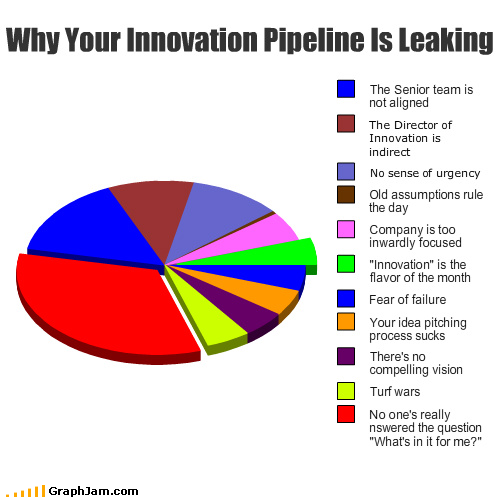
Posted by Mitch Ditkoff at 10:55 PM | Comments (0)
October 07, 2014THE SEED OF INNOVATION MOMENT: A 3-Minute Video Tutorial

If you are trying to spark a renaissance of innovation in your company by launching some kind of "innovation initiative", consider the fact that the seed of innovation is already available in every conversation that people are having. This 3-minute video tutorial dives in deeper.
The Seed of Innovation keynote
Create change agents
A more structured way to do this
Posted by Mitch Ditkoff at 03:51 PM | Comments (0)
September 15, 2014Is Peace the Innovation We Need the Most?

"Innovation" continues to be a hot topic in corporate circles these days -- a "competitive edge" organizations are increasingly attempting to hone so they can not only differentiate themselves from the competition, but survive in today's topsy turvy economy.
That being said, there are some forward thinking organizations out there who are going beyond the status quo and seriously asking themselves what they can do differently to not only be "socially responsible", but use their corporate clout to help various peace-themed global causes truly impact positive change.
If that describes your organization, please contact us. Idea Champions, in 2015, will be launching a new innovation-sparking service to help corporations, world wide, figure out HOW they can leverage their resources, bandwidth, and brainpower to foster peace and well-being in the world -- and still make a profit.
International Day of Peace in the Huffington Post
Idea Champions
Posted by Mitch Ditkoff at 02:35 PM | Comments (0)
September 01, 2014REAL ROI: Return on Imagination!
If you're a champion of innovation, chances are good you've encountered the ROI beast more than a few times -- senior leaders looking at you cross-eyed and questioning the value of your efforts. Stop the madness! Change the game! Forward this slide show today!
First, get clear about your problemPosted by Mitch Ditkoff at 11:26 AM | Comments (1)
August 02, 2014Unleashing Business Brilliance

That's what we do. And below are five ways we do it.
Conducting Genius
Engaging Innovation
Ingenious Leadership
What's the Problem?
Team Innovation
What our clients say
Posted by Mitch Ditkoff at 05:00 PM | Comments (0)
March 29, 201456 Reasons Why Most Corporate Innovation Initiatives Fail

Innovation is in these days. The word is on the lips of every CEO, CFO, CIO, and anyone else with a three-letter acronym after their name. As a result, many organizations are launching all kinds of "innovation initiatives" -- hoping to stir the creative soup. This is commendable. But it is also, all too often, a disappointing experience.
Innovation initiatives sound good, but usually don't live up to expectations. The reasons are many. What follows are 56 of the most common -- organizational obstacles we've observed that get in the way of a company truly raising the bar for innovation.
See which ones are familiar to YOU. Then, sit down with your Senior Team... CEO... innovation committee, or team and jump start the process of going beyond these obstacles.
56 Reasons Why Most Corporate Innovation Initiatives Fail
1. "Innovation" framed as an initiative, not the normal way of doing business
2. Absence of a clear definition of what "innovation" really means
3. Innovation not linked to company's existing vision or strategy
4. No sense of urgency
5. Workforce is suffering from "initiative fatigue"
6. CEO does not fully embrace the effort
7. No compelling vision or reason to innovate
8. Senior Team not aligned
9. Key players don't have the time to focus on innovation
10.Innovation champions are not empowered
11. Decision making processes are non-existent or fuzzy
12. Lack of trust
13. Risk averse culture
14. Overemphasis on cost cutting or incremental improvement
15. Workforce ruled by past assumptions and old mental models
16. No process in place for funding new projects
17. Not enough pilot programs in motion
18. Senior Team not walking the talk
19. No company-wide process for managing ideas
20. Too many turf wars. Too many silos.
21. Analysis paralysis
22. Reluctance to cannibalize existing products and services
23. NIH (not invented here) syndrome
24. Funky channels of communication
25. No intrinsic motivation to innovate
26. Unclear gates for evaluating progress
27. Mind numbing bureaucracy
28. Unclear idea pitching processes
29. Lack of clearly defined innovation metrics
30. No accountability for results
31. No way to celebrate quick wins
32. Poorly facilitated meetings
33. No training to unleash individual or team creativity
34. Voo doo evaluation of ideas
35. Inadequate sharing of best practices
36. Lack of teamwork and collaboration
37. Unclear strategy for sustaining the effort
38. Innovation Teams meet too infrequently
39. Middle managers not on board
40. Ineffective roll out of the effort to the workforce
41. Lack of tools and techniques to help people generate new ideas
42. Innovation initiative perceived as another "flavor of the month"
43. Individuals don't understand how to be a part of the effort
44. Diverse inputs or conflicting opinions not honored
45. Imbalance of left-brain and right brain thinking
46. Low morale
47. Over-reliance on technology
48. Failure to secure sustained funding
49. Unrealistic time frames
50. Failure to consider issues associated with scaling up
51. Inability to attract talent to risky new ventures
52. Failure to consider commercialization issues
53. No rewards or recognition program in place
54. No processes in place to get fast feedback
55. Inadequate sense of what your customers really want or need
56. Company hiring process screens out potential innovators
Posted by Mitch Ditkoff at 01:31 PM | Comments (4)
March 16, 2014How to Spark Wisdom in the Workplace
Dear Heart of Innovation Readers:
If you have received any value from this blog and would be interested in supporting my next, big project -- now launched as a GoFundMe campaign -- click here for a 3-minute video of me describing it and a written description of what the whole thing is all about -- a venture which includes the writing, publication, and promotion of a new book, Wisdom at Work, along with the launching of WISDOM CIRCLES in organizations around the world.
Whatever support you can provide is very much appreciated, Plus, you will be sent a copy of the book when it's published, if you want.
Mitch Ditkoff's GoFundMe campaign
Posted by Mitch Ditkoff at 09:35 AM | Comments (0)
February 19, 2014How to Open the Door to Innovation

There is no magic pill, but there is a key. And the key has a lot to do with creating a critical mass of savvy innovation catalysts and change agents who know how to open doors (and minds).
Posted by Mitch Ditkoff at 08:32 PM | Comments (0)
February 17, 2014Would You Invest Three Hours to Save Yourself Months of Wasted Effort?

Idea Champions has just launched a groundbreaking three-hour workshop that will save your organization untold time, tons of money, and a thousand pounding headaches you can't afford to have.
Posted by Mitch Ditkoff at 02:18 PM | Comments (0)
February 15, 2014How to Help Your Senior Team Get Aligned About a Strategic Direction

I am totally inspired by the feedback that Steven McHugh, co-Founder and Chief Innovation Officer of Idea Champions, received from Life Care Centers of America, in response to a two-day Senior Team Strategy Offsite he designed and facilitated for them. See below...
 "I wanted to thank you for the wonderful work you've done for us at Life Care Centers of America.
"I wanted to thank you for the wonderful work you've done for us at Life Care Centers of America.
As you know, when I left my CFO position at Olin Corporation to help lead Life Care, I was presented with a number of difficult challenges. Due to strict government regulations, the long-term care industry was in turmoil. In 30 years, Life Care had not performed any unified, long-term strategic planning, and there was no HR department for over 27,000 employees.
Based on the excellent work you did for over five years with my former company, I knew you had the skills to help us. Your role in aligning 230 different facilities into a unified force has been remarkable, especially in the short time frame you were given.
As you know, the results of the process you took us through have been astounding. In an environment where five of the top six public nursing home companies have declared bankruptcy, we have enjoyed unprecedented growth. You helped our senior officers transform into a dynamic leadership team. Our clarity around an aligned mission translated into a powerful vision that we can communicate to the rest of the organization.
Your Vision Mapping sessions were the catalysts for communicating our message to the rest of the organization. Your ability to develop balanced scorecards for all 230 facilities was the key to translating strategy into results.
It is now clear what actions are important for us to take, and for the first time, our people know how their success will be measured.
From the senior level to the staff in each facility, actions are now aligned to achieve strategic goals.

As an interesting byproduct of your work here, we are beginning to develop leaders at all levels in the organization who are empowered to do whatever it takes to get the job done. They have a clear line of sight to the strategic goals and are stepping up to the plate to get them done.
I am proud of how we have responded to the process you have embedded into our culture. Thank you for justifying my faith in bringing you in to facilitate this major change in how we operate.
I look forward to continuing our work together in developing a high performance organization."
-- Michael Waddell, President, Life Care Centers of America
50 quotes on possibility
50 quotes on vision
Creators on Creating
What we do
Idea Champions
Posted by Mitch Ditkoff at 01:26 PM | Comments (0)
October 15, 2013Go Beyond the Impostor Syndrome

In a rapidly changing, highly complex and unpredictable world, leadership has little to do with being the smartest person in the room.
It is often the case that those holding positions of authority believe they must justify their position by providing the best solutions to the problems they face.
Often this need to demonstrate that one "has the answer" is grounded in a deeply rooted fear that one, in fact, does not truly know what to do and that revealing one's uncertainty will lead to an erosion of confidence in one's superiors and subordinates.
They see their authority as grounded in their knowledge and expertise and feel obliged to demonstrate their acumen whenever consequential problems are addressed.
This phenomenon invariably leads to compensatory behavior in which one's inner doubts and uncertainty about how to address complex and ambiguous issues leads to unjustified rigidity of positions and an inability to see the value of alternative points of view.

If we must constantly prove to everyone that we deserve the position we have attained, we can never allow ourselves to be seen as needing to learn anything or to rely on anyone else.
This dilemma -- often referred to as the "impostor syndrome", -- systematically undermines one's ability to learn, to benefit from the perspectives of others, and to appreciate the value of others' strengths and points of view.
It also often leads to behaviors in which we diminish others in order to reassure ourselves of our importance and our value.
Lastly, it virtually guarantees that the decisions that get made are not the best ones because they are not informed by the experience, insight, and creativity of the people around us.
- Barry Gruenberg
Idea Champions
34 Awesome Quotes on Leadership
Posted by Mitch Ditkoff at 01:50 AM | Comments (2)
March 27, 2013Infusing Your Workplace with Humanity
62% of all Americans are dissatisfied with their work. 85% of the general public don't trust business leaders to tell the truth when confronted with difficult issues. If YOUR organization wants to explore practical ways of raising the quality of the workplace experience and engaging employees in ways that are humane and sustainable, here's your starter kit. You may also be interested in our Humanizing the Workplace keynotes, town meetings, and workshops.
Posted by Mitch Ditkoff at 10:33 AM | Comments (0)
March 21, 2013The Humanize the Workplace Poll
If you work for an organization that needs to become a more benevolent and humane workplace, I invite you to respond to Idea Champions' new Humanizing the Workplace poll.
Not only will it jump start your thinking about simple changes that can be made on the job, it will also provide us with the vital input we need to really tune into the issues.
You'll need about five minutes.
We'll be posting the results of the poll here in a few weeks, but if you'd like us to email the results to you directly, just note your email address in the comments box or send a message to info@ideachampions.com
You can read more about this topic in my latest Huffington Post article.
Posted by Mitch Ditkoff at 08:15 AM | Comments (0)
March 20, 2013How to Humanize the Workplace
A recent poll has revealed that 62% of Americans are dissatisified with their work.
While there are a lot of contributing factors, one BIG factor is that most workplace environments are not wired to bring out the best in people. Quite the contrary.
That's what my newly published article in the Huffington Post is all about.
It doesn't just name the problem, however. It also provides a simple "starter kit" for how each and everyone of us can begin to humanize our workplace environments.
Click here to weigh in on the topic by responding to my Humanizing the Workplace poll. If you want to register for my April 4th Telesummit on this topic, click here. It's free.
Idea Champions
Posted by Mitch Ditkoff at 12:32 PM | Comments (0)
January 08, 2013Got the Business Blues? Sing It Out!

If you work in an organization where complaint rules the day, it's time to do something about it. Yes, it's possible. Bitching and moaning can actually give way to genius and engagement. A homeopathic dose of the blues is all you need.
I'm talking about Face the Music -- a very cool, interactive "business blues" simulation that gives people a chance to get things off their chest AND, at the same time, learn what it takes to get out of the box, take a risk, build a team, and have some fun for a change.
I co-founded this baby, with Paul Kwicienski, back in 1999. It's still cooking -- a great way to add life to any corporate conference, retreat, meeting, or awards ceremony.
Posted by Mitch Ditkoff at 07:07 PM | Comments (0)
November 09, 201250 Awesome Quotes on Risk Taking
Is it time
to try
something new?
Get out of
your comfort zone?
Take a new step
or leap?
Feeling
a little queasy?
Need some
inspiration
to go beyond
the status quo?
Here's the ticket.
50 quotes on risk taking,
my latest piece
on Huffington Post.
Posted by Mitch Ditkoff at 11:05 AM | Comments (0)
October 25, 2012The Kindness-At-Work Manifesto
This just in! We're here for just a little while. No one gets out of here alive. Not even Donald Trump. So while you're here, remember to be kind and go beyond judgment, blame, and impatience -- especially when things start getting stressed out. Like on-the-job.
Here's my inspired rant on the subject, just published in The Huffington Post.
Posted by Mitch Ditkoff at 11:38 PM | Comments (0)
The Kindness-At-Work ManifestoThis just in! We're here for just a little while. No one gets out of here alive. Not even Donald Trump. So while you're here, remember to be kind and go beyond judgment, blame, and impatience -- especially when things start getting stressed out. Like on-the-job.
Here's my inspired rant on the subject, just published in The Huffington Post.
Posted by Mitch Ditkoff at 11:38 PM | Comments (0)
October 13, 201256 Reasons Why Most Corporate Innovation Initiatives Fail
If you
want to
create a
culture of
innovation,
begin by
becoming aware
of the possible
detours along the way.
Click below
for 56
reasons why
most corporate
innovation initiatives
fail,
a new
article of mine
in the
Huffington Post.
(And yes, it's still possible)
Posted by Mitch Ditkoff at 11:53 PM | Comments (0)
August 10, 2012Web Workshops from Idea Champions
Here's a 3minute video overview of Idea Champions newest service -- Web Workshops -- highly engaging 60-minute tutorials to help your workforce raise the bar for innovation, collaboration, and communication.
Posted by Mitch Ditkoff at 04:11 PM | Comments (0)
July 17, 2012Rethinking The Role of a Manager
The root of the word "manager" comes from the same root as the words "manipulate" and "maneuver", meaning to "adapt or change something to suit one's purpose". Although these words may carry a pejorative meaning, there is nothing inherently wrong with them. Indeed, into each life a little manipulation and maneuvering must fall.
For example, if the door to your office gets stuck, a handyman might need to manipulate it to get it working again. If there is a log jam at the elevator, you might decide to maneuver around the crowd and take the stairs.
However, there is another kind of manipulation and maneuvering that is a problem -- when managers use their position to bend subordinates to their will.
While short-term gains may result, in the end the heart is taken out of people. Your staff may become good soldiers, but they will lose something far more important in the process -- their ability to think for themselves.
Unfortunately, ingenuity in many corporations has gone the way of the hula-hoop. "Intellectual capital" is the name of the game these days -- and it is the enlightened manager's duty to learn how to play. Only those companies will succeed whose people are empowered to think for themselves and respond creatively to the relentless change going on all around them.
Managers must make the shift from manipulators to manifesters. They must learn how to coach their people into increasingly higher states of creative thinking and creative doing. They must realize that the root of their organization's problem is not the economy, cycle time, strategy or outsourcing, but their own inability to tap into the power of their workforce's innate creativity.
Where does this empowerment start? First, by recognizing what power is: "the ability to do or act". And second, by realizing that power is intimately connected to ideas.
Most managers, unfortunately, perceive new ideas as problems -- especially if the ideas are not their own. More often than not, managers don't pay enough attention to the ideas of the people around them. They say they want innovation. They say they want "their people" to do something different. But they do precious little to support their subordinates in their efforts to do so. More commonly, they foist their own ideas on others and can't figure out why things aren't happening faster.
That's not how change happens. If people are only acting out somebody else's ideas, it's only a matter of time before they feel discounted, disempowered and just plain dissed. People are more than hired hands; they are hired minds and hearts, as well.
Let's start with the basics. Everything you see around you began as an idea. The computer. The stapler. The paperclip, the microchip and the chocolate chip. All of these began as an idea within someone's fevered imagination.
The originators of these ideas were on fire. Did they have to be "managed?" No way. In fact, if they had a manager, he or she would have done well to get out of the way.
If you want to empower people, honor their ideas. Give them room to challenge the status quo. Give them room to move -- and, by extension, move mountains.
Who has the power in an organization? The people who are allowed to think for themselves and then act on their ideas! Who doesn't have power? The people who have to continually check-in with others.
Think about it. The arrival of a new idea is typically accompanied by a wonderful feeling of upliftment and excitement -- even intoxication. It's inspiring to have a new idea, to intuit a new way of getting the job done. Not only does this new idea have the potential to bring value to the company, it temporarily frees the idea originator from their normal habits of thinking. A sixth sense takes over, releasing the individual from the gravity of status quo thinking.
In this mindset, the idea originator is transported to a more expansive realm of possibility. All bets are off. The sky's the limit. All assumptions are seen for what they are -- limited beliefs with a history, but no future.
If you are a manager, you want people in this state of mind. It is not a problem. It is not the shirking of responsibility. It is not a waste of time. On the contrary, it's the first indicator that you are establishing a company culture that is conducive to innovation.
This is not to say, of course, that you have to fund every idea that comes your way. On some level, ideas are a dime a dozen -- and only a handful of them are ever going to amount to much. But if you treat all ideas as if they are worthless, you will never find the priceless ones.
You, as a manager, want to increase the number of new ideas being pitched to you. You want to create an environment where new ideas are popping all the time. If you do, old problems and ineffective ways of doing things will begin dissolving. This is the hallmark of an innovative organization -- a place where everyone is encouraged and empowered to think creatively. Within this kind of environment managers become coaches, not gatekeepers.
It's one thing to tell people "you want their ideas", it's quite another to create the kind of environment that makes this rhetoric real.
How does a manager do this? First, by expressing a lot of positive regard. Get interested! Pay attention! Be present to the moment! This is not so much a technique as it is a state of mind. If your head is always filled with your own thoughts and ideas, there won't be any room left to entertain those of others. It's a law of physics. Two things cannot occupy the same place at the same time.
Your willingness to sit up and take notice needs to be just as strong as if a customer were to call and complain. If possible, drop what you're doing, focus all of your attention on the idea generator, take a deep breath, and begin a series of questions that demonstrate your interest. If you cannot drop what you are doing, schedule some time -- as soon as possible -- for the idea originator to pitch you.
And whether the pitch is now or later, your response -- in the form of exploratory questions -- needs to be as genuine as possible. Consider some of the following openers:
* "That sounds interesting. Can you tell me more?"
* "What excites you the most about this idea?"
* "What is the essence of your idea - the core principle?"
* "How do you imagine your idea will benefit others?"
* "In what ways does your idea fit with our strategic vision?"
* "What information do you still need?"
* "Is there anything similar to your idea on the market?
* "What support do you need from me?"
Most of us, however, are so wrapped up in our own ideas that we rarely take the time to listen to others. Your subordinates know this and, consequently, rarely share their ideas with you.
But it doesn't have to be this way. And it won't necessarily require a lot of time on your part. Some time, yes. But not as much as you might think. Choose not to listen and you will end up frantically spending a lot more time down the road asking people for their ideas about how to save your business from imminent collapse. By that time, however, it will be too late. Your workforce will have already tuned you out.
How can you make more time to listen to the ideas of your direct reports and teammates?
Posted by Mitch Ditkoff at 07:14 AM | Comments (0)
July 05, 2012Introducing Interdependence Day!

One day after
Independence Day,
its time to introduce
a new holiday:
Interdependence Day.
Yes, it's true,
we are all
in this together.
You cannot
do this alone,
no matter how skillful
or experienced
you may be.
Innovation is a team sport.
1+1=11.
Today,
declare your
interdependence.
Connect!
Cooperate!
Collaborate!
Commit!
Posted by Mitch Ditkoff at 05:34 PM | Comments (0)
June 13, 2012Find a Reliable GPS for Your Organization's Innovation Journey

ED NOTE: It has recently come to our attention that some of our most avid readers still don't know the full scope of what Idea Champions (that's us) does. Here you go:
For 25 years, Idea Champions has catalyzed organizational innovation -- guiding forward-thinking companies to both short-term and long-term success in their marketplace.
As a result of our work, our clients not only learn to quickly adapt to constantly changing markets, but also evolve and invent offerings that blow their competition out of the water.
These companies are committed to what we call the "Innovation Journey." Think of us as your GPS for the journey.
We provide innovation consulting, skill-building training, team facilitation, catalytic conferences, and products to help you create a strategic, systemic and sustainable innovation process -- one that fully engages your workforce.
We have the road map. We know the shortcuts. We know the detours. And we also know how to get you to your destination with the least amount of wheel spinning, frustration, and expense.
To build capacity for innovation, we provide services in five key areas:
1. Innovation Journey Consulting: Needs assessments, senior team alignment sessions, visioning, roadmapping, and a simple process for choosing and developing ideas.
2. Creative Thinking Sessions: Skills for opportunity finding, ideation, brainstorming, breakthrough thinking, and idea assessment. Includes creative thinking tools, support materials, and webinars.
3. Leadership Development Workshops: Customized meetings to increase the core competency of innovation for your organization's "best and brightest". Focuses on helping participants go beyond business as usual and establish a sustainable, culture of innovation.
4. Team Collaboration: Jump starts the process of groups becoming teams and teams becoming high-performing teams. Focuses on team culture, values, communication, collaboration skills, coaching, and how to create low-cost business incubators.
5. Catalytic Conferences: Innovation-sparking events focused on generating new revenue, reducing costs, incubating new business models, and establishing a sustainable culture of innovation. Includes interactive keynotes and conference design, and expert facilitation.
Idea Champions turns theory into practice in a way that is engaging, enlivening, and empowering. Top down. Bottom up. Inside out. And outside in.
Our approach is collaborative, empowering, creative, productive, and fun. Everybody commits to taking the journey together so innovation becomes a mindset, not a program.
We can start small -- with a team or department event. Or we can start BIG, with a series of Innovation Journey Roadmap sessions designed to align and enroll your senior team on their innovation strategies for the future.
Call us today to begin: 845.679.1066. Or email.
What our clients say
How we get the job done
Our team
Our values
Posted by Mitch Ditkoff at 01:42 PM | Comments (0)
May 08, 2012Creating Time to Innovate

On Thursday May 17th, I will be delivering a live webinar on Fostering a Culture of Innovation. The first 50 people to sign up get half off, so register now!
During the past few years I've noticed a curious paradox heading its ugly rear among business leaders tooting the horn for innovation.
On one hand they want the rank and file to step up to the plate and own the effort to innovate.
On the other hand, they are unwilling to grant the people they are exhorting any more TIME to innovate.
Somehow, magically, they expect aspiring innovators to not only generate game-changing ideas in their spare time, but do all the research, data collection, business case building, piloting, project management, idea development, testing, report generation, and troubleshooting in between their other assignments.
Tooth fairy alert!
This is not the way it happens, folks! Not only is this approach unreasonable, it's unfair, unbalanced, and unworkable.
You cannot shoehorn game-changing innovation projects into the already overcommitted schedules of your overworked workforce.
If you do, it won't be innovation you'll get, only half-finished projects and a whole lot of cranky people complaining to you in between yet another unnecessary meeting.
Oh sure, there are always a few who will find a way, via skunkworks and caffeine, to find the time... but for the most part, organizations are painting their people into a corner.
Aspiring innovators don't need pep talks. They need TIME. Time to think. And time to dream. Time to collaborate. And time to plan. Time to pilot. And time to test. Time to tinker. And time to tinker again.

That's why Google gives its engineers 20% of their time to work on projects not immediately connected to its core business. That's why W.L. Gore gives its workforce a half day a week to follow their fascinations. That's why Corel instituted it's virtual garage program.
"Dig where the oil is," Edward deBono once said. Indeed! And where is the oil? Right beneath the feet of each and every employee who is fascinated by the work they do, aligned with their company's mission, and given enough time to make magic happen.
Need proof? 50% of Google's newly launched features were birthed during this so-called "free time". -- midwived by engineers, programmers, and other assorted wizards happily following their muse.
The fear? If you give people "freedom" they'll end up playing video games and taking 3-hour lunches. Alas, when fear takes over, folks, (the same fear Peter Drucker asked us all many years ago to remove from the workplace), vision is supplanted by supervision and all his micromanaging cousins.
Time to innovate is not time wasted. It is time invested.
Freedom does not necessarily lead to anarchy. It can lead to breakthrough just as easily.
Remember, organizations do not innovate. People do. And people need time to innovate. Time = freedom. Freedom to choose. Freedom to explore. Freedom to express. And yes, even freedom to "fail."
If you've hired the right people, communicated a compelling vision, and established the kind of culture that brings out the best in a human being, you are 80% there.
Now all you need to do is find a way to give your people the time they need to innovate.
For more of our wisdom on innovation, creative thinking, and becoming the best company you can be, check out our newly launched webinars at www.ideachampionsuniversity.com!
Posted by Mitch Ditkoff at 12:36 AM | Comments (1)
May 03, 2012The Power of Positive Feedback
Most high level executives do not expect a lot of recognition from others. Neither do they give a lot of recognition to others.
Many managers are like the classic husband who, when his wife complains that he doesn't tell her he loves her any more, responds that he told her he loved her when he married her -- and would have let her know if anything had changed.
Similarly, most managers act as if the act of hiring an employee is recognition enough -- this in spite of the fact that every one of these managers wants to be valued and appreciated by their superiors, and is regularly disappointed by the lack of appreciation coming their way.
In today's workplace, there is a great fear that only the most extraordinary achievements warrant recognition and that all "just good" performance is merely what should be expected and does not require any special recognition.
The fear most manager's have? That "excessive" recognition will dilute the praise they give and reduce future motivation for outstanding performance.
The data, of course, indicates otherwise.
Acknowledgment of good performance increases the probability of more good performance. And specificity of feedback -- telling people exactly what you liked about what they did and why you liked it -- dramatically increases the likelihood of that performance occurring again.
The bottom line?
If we can get to a place where we are more generous and specific in the expression of our positive feedback, we will notice, in time, a dramatic increase in the quality of employees' performance and their overall satisfaction with work.
-- Barry Gruenberg
Posted by Mitch Ditkoff at 08:47 AM | Comments (1)
May 01, 201256 Reasons Why Most Corporate Innovation Initiatives Fail
Innovation is in these days. The word is on the lips of just about every CEO, CFO, CIO, and anyone else with a three-letter acronym after their name.
As a result, many organizations are launching all kinds of "innovation initiatives" -- hoping to stir the soup. This is understandable. But it is also, far too often, very disappointing.
Innovation initiatives sound good, but usually don't live up to the expectations. The reasons are many.
What follows are 56 of the most common ones -- organizational obstacles we've observed in the past 25 years that get in the way of a company really raising the bar for innovation.
56 Reasons Why Most Corporate Innovation Efforts Fail
1. Innovation framed as an initiative, not the normal way of doing business
2. Absence of a clear definition of what "innovation" really means
3. Innovation not linked to company's existing vision or strategy
4. No sense of urgency
5. Workforce is suffering from "initiative fatigue"
6. CEO does not fully embrace the effort
7. No compelling vision or reason to innovate
8. Senior Team is not aligned
9. Key players don't have the time to focus on innovation
10.Innovation champions are not empowered
11. Decision making processes are non-existent or fuzzy
12. Lack of trust
13. Risk averse culture
14. Overemphasis on cost cutting or incremental improvement
15. Workforce ruled by past assumptions and old mental models
16. No process in place for funding new projects
17. Not enough pilot programs in motion
18. Senior Team not walking the talk
19. No company-wide process for managing ideas
20. Too many turf wars. Too many silos.
21. Analysis paralysis
22. Reluctance to cannibalize existing products and services
23. NIH (not invented here) syndrome
24. Funky channels of communication
25. No intrinsic motivation to innovate
26. Unclear gates for evaluating progress
27. Mind numbing bureaucracy
28. Unclear idea pitching processes
29. Lack of clearly defined innovation metrics
30. No accountability for results
31. No way to celebrate quick wins
32. Poorly facilitated meetings
33. No training to unleash individual or team creativity
34. Voo doo evaluation of ideas
35. Inadequate sharing of best practices
36. Lack of teamwork and collaboration
37. Unclear strategy for sustaining the effort
38. Innovation Teams meet too infrequently
39. Middle managers not on board
40. Ineffective roll out of the effort to the workforce
41. Overemphasis on structures, protocols, and processes
42. Innovation initiative perceived as another "flavor of the month"
43. Individuals don't understand how to be a part of the effort
44. Diverse inputs or conflicting opinions not honored
45. Imbalance of left-brain and right brain thinking
46. Low morale
47. Over-reliance on technology
48. Failure to secure sustained funding
49. Unrealistic time frames
50. Failure to consider issues associated with scaling up
51. Inability to attract talent to risky new ventures
52. Failure to consider commercialization issues
53. No rewards or recognition program in place
54. No processes in place to get fast feedback
55. No real sense of what your customers really want or need
56. Company hiring process screens out potential innovators
Others we may have missed?
We can help. Click here for more.
Thanks to Barry Gruenberg, Bill Shockley, Chuck Frey, and Farrell Reynolds for their sage input.
Posted by Mitch Ditkoff at 12:17 PM | Comments (0)
April 01, 2012Our World Wide Webinatrix Speaks!

The writers of this blog are excited, thrilled, and tickled to announce the launching of a entirely new service to the known universe: Webinars powered by Idea Champions University.
Having spent the past 25 years delivering a wide variety of innovation-sparking workshops, trainings, meetings, conferences, and consulting interventions to forward thinking organizations everywhere, we've decided to let go of our addiction to Frequent Flyer miles and go virtual.
Our new venture began with a simple question: "How can we have the biggest impact on the most amount of people in a cost-effective, highly engaging, low carbon footprint way?"
The answer? Build a webinar curriculum and deliver our services online.

Which is exactly what we've done and will continue to do as long as the need in the marketplace exists.
Bottom line, if you're looking for a better way to build the core competency of innovation, you've come to the right place.
No airfare required. No cabs. No sending your people to overpriced hotels and wondering whose gonna cover for them while they're eating muffins and collecting one more three-ring binder they will never read.
Operators are not standing by. But our website is. And so is our integrity -- the collective mojo we've built for the past 25 years with some of the finest organizations in the world.
So visit us online to learn more about what we're offering. And while you're at it, feel free to register for one of our upcoming open-enrollment webinars -- a great way to kick our virtual tires.

If you are one of the first 50 people to register, you'll receive a 50% discount and a free annual subscription to our highly regarded online Free the Genie app.
If you'd rather schedule a group webinar (for up to 100 people), contact Sarah Jacob, our World Wide Webinatrix.
She means business.
Posted by Mitch Ditkoff at 01:48 AM | Comments (0)
March 20, 2012Why Good Leaders Pause
It's often the case that people expect their leaders to be decisive -- able to make difficult decisions quickly. Indeed, this kind of behavior is interpreted as one of the hallmarks of good leadership.
The reality is different, however.
The "rush to judgment" mindset creates undue pressure on leaders -- the kind of pressure that causes them to prematurely choose a path forward even when confronting a complex problem.
To be truly effective, leaders need to balance the need to quickly converge on a single solution with the conflicting requirement that multiple perspectives be considered.
Yes, spending time to gain an understanding of the thought processes behind conflicting perspectives slows down the decision-making process. But it also creates a rich opportunity for much more robust solutions.
Slowing down is not necessarily a sign of procrastination or indecision. More accurately, it is a sign of impending wisdom about to be applied.

Tolerating this period of pause requires leaders to exhibit two qualities that seem to be in short supply these days:
1. Self-confidence (not bravado).
2. Patience (not procrastination).
Unfortunately, as external pressures from above and below increase, leaders experience an increasing tendency to internalize these pressures, causing self-doubt, stress, and a relentless need to prove their worth.
The result? Leaders end up adopting pre-existing solutions not well-suited to the challenges at hand. They decide fast, but the decisions they make are all too often fatally flawed.
Being able to resist mounting pressures to act quickly requires great intestinal fortitude. It requires leaders to keep themselves and others passionately engaged in the process of finding a way through the uncertainty instead of grasping at known "solutions" which only make the problem worse.
This phenomenon is similar to the classic story of the drunkard looking for his car keys under a streetlight even though he knows it's not where he dropped them.
"I know my keys aren't there," he confesses, "but that's where the light is."
It's not easy searching in the dark. Nor is it easy convincing others to join you in the search.
Which is precisely why being an authentic leader is so difficult these days.
- Barry Gruenberg
Here's another one of Barry's fine articles.
Posted by Mitch Ditkoff at 11:39 AM | Comments (0)
January 30, 2012The Art and Science of Losing Count
"Not everything that can be counted counts, and not everything that counts can be counted."
-- Albert Einstein
If you have even the slightest respect for the wild-haired father of modern physics, consider this: Your organization's fascination with metrics is often nothing more than a thinly veiled attempt to quantify the unquantifiable -- a compulsive effort to validate that which you and everyone else already know to be true.
I'm not suggesting you abandon metrics (I track, daily, how may unique visitors make it to my website) -- all I'm saying is not everything needs to be measured, at least not all of the time.
The core of your company's "innovation process" is actually less about mind, and more about heart. (And if you're about to ask me how I know that, please read the Einstein quote one more time).
Posted by Mitch Ditkoff at 08:17 AM | Comments (0)
January 11, 2012Have Innovation Challenge Will Travel
Because I post a lot on this blog (and because I was recently voted the #1 innovation blogger in the world), many people think all I do is write.
Not true.
My day job is being the President and Chief Creativity Officer of Idea Champions, a highly regarded consulting and training company, founded in 1987.
But hey, don't take my word for it. Take a look at what our clients have to say about the value of our work.
Intrigued? Interested in raising the bar for innovation in your organization? Drink coffee? Eat cheese? Breathe? If so, click here to get the ball rolling.
Posted by Mitch Ditkoff at 02:24 AM | Comments (0)
January 07, 2012Go Beyond the Business Blues

For years I was trying to figure out what all my clients had in common. Opposable thumbs? Yes. The Isle of Langerhans. That, too. Big, fat opinions about everything. For sure.
But even more than the aforementioned stuff in the preceding paragraph which you just read and probably haven't yet forgotten even though your short-term memory is getting shorter by the nanosecond and you're probably wondering, by now, why I'm rambling on and on when most blog postings are supposed to be short and sweet, it dawned on me one fine day as I was scraping marinara sauce off my shirt that the main thing all my clients had in common was the blues.
Yes, indeed. The blues. The same blues Muddy Waters had. And Robert Johnson. And BB King. Those blues.
Unlike the blues greats, however, my clients didn't have a way to express their blues. And, in the absence of this opportunity, their God given right to get right was lost.
But no more, brothers and sisters! No more!
Now, even the most buttoned down, white collared, bow-tied creators of spreadsheets at midnight have a chance to get those business blues off their chest and move towards a better future -- not to mention have fun, collaborate, and learn what it takes to innovate on the fly.
Ladies and gentlemen, without any further ado, allow me to introduce you to the world's first business blues band -- Face the Music!.
PS: Should you decide to contact them, be sure to mention that it was Idea Champions who sent you. (We give 5% of our referral fees to TPRF, one of the most well-run and inspired humanitarian organizations in the world).
The Six Sigma Blues
My blues encounter at Pfizer
The Email Blues
The Gotta Have a Process Blues
Idea Champions
Posted by Mitch Ditkoff at 01:33 AM | Comments (0)
September 26, 2011The Six Sigma Blues

One of my favorite clients of all time was a key manager in a prominent Fortune 500 company.
She was smart. She was funny. She was creative. And she was kind.
Then her company adopted Six Sigma.
I couldn't help but notice that soon after this she started becoming very cranky, not unlike the way an artist gets upon filling out a tax form.
When I asked her how the Six Sigma initiative was going, she rolled her eyes and mumbled something about "going through the motions."
In a lucid online Business Week posting, Brian Hindo deconstructs some of the flawed assumptions of the Six Sigma approach.
"The very factors that make Six Sigma effective in one context," explains Hindo, "can make it ineffective in another. Traditionally, it uses rigorous statistical analysis to produce unambiguous data that help produce better quality, lower costs, and more efficiency. That all sounds great when you know what outcomes you'd like to control. But what about when there are few facts to go on -- or you don't even know the nature of the problem you're trying to define?
"New things look very bad on this scale," says MIT Sloan School of Management professor Eric von Hippel, who has worked with 3M on innovation projects that he says 'took a backseat' once Six Sigma settled in.
"The more you hardwire a company on total quality management, the more it is going to hurt breakthrough innovation," adds Vijay Govindarajan, a management professor at Dartmouth's Tuck School of Business. "The mindset that is needed, the capabilities that are needed, the metrics that are needed, the whole culture that is needed for discontinuous innovation, are fundamentally different."
And so, dear Heart of Innovation readers, in honor of all people who have ever questioned the long-term value of Six Sigma... in honor of all the people who have understood that increasing -- not decreasing -- variability is often the key to success, it is my utmost pleasure to make my graceful exit from this latest blog posting with the immortal, finger-snapping, toe-tapping, knee-slapping, put-on-your-blues-hat-and-sunglasses lyrics to....
THE GOTTA HAVE A PROCESS BLUES
I woke up this morning,
put both feet on the floor,
but I didn't have a process
to find the bathroom door,
so all I did was shuffle,
first the left foot, then the right,
forgot to count the tiles,
(hey boss, I ain't too bright.)
We got green belts, black belts,
corporate karate,
and soon we'll need a process
for going to the potty.
Lord, I need a chart and graph to help me choose
just what to name this song about the Six Sigma blues.
Back when we were kids
the only processed thing was cheese,
now we need a process
every single time we sneeze,
I say "achoo," I blow my nose,
I try to get it right,
my Black Belt says my charts don't flow,
not once a gesundheit.
I make no mistakes,
I do everything right --
to make sure nothing breaks,
I stay up all night,
I'm a Six Sigma cowboy
cutting cycle time in half,
I measure every joke
and the way it makes me laugh.
We got green belts, black belts,
corporate karate,
and soon we'll need a process
for going to the potty,
a fishbone diagram would be so cool to help me choose
just what to name this song about the Six Sigma blues.
I barely make a boo boo, I rarely blow a deal,
you might call it voo doo, but that's just how I feel,
I'm one in a million
though my defects number three,
I log on while I'm sleeping
and I've changed my name to "E."
We got green belts, black belts,
corporate karate,
and soon we'll need a process
for going to the potty.
-- Blind Willy Nilly (aka "Mitch Ditkoff")
Photo
Face the Music
Idea Champions
Posted by Mitch Ditkoff at 10:10 PM | Comments (2)
June 08, 2011The Hero Culture
The hero culture is alive and well in many organizations.
Riding in on a white horse to rescue the company from a downward spiral, occasioned by a history of poor decisions, will win you lots of recognition and rewards.
On the other hand, insisting on the importance of truly understanding customer needs prior to deciding on a product's features... or really thinking through the technical challenges associated with achieving a desired outcome... or taking the time to engage people before instituting a difficult reorganization, will likely gain you the reputation of being an obstacle, poor team player, or just plain indecisive.
Unfortunately, being the person who seems to know all the answers and can turn things around by telling everyone what to do is often what we are looking for these days.
Creating an organization that is agile and can run on its own -- where decisions are made close to the customer and higher level managers only need to provide strategic direction and uphold key values -- is not the fastest way to "the top" these days.
What is?
Making sure your thumbprint is on every critical decision and that you're the person who always has the last word with the CEO.
So by all means -- if you want to get to the top -- do not make your organization self-sufficient, do not develop your successor, and do not make yourself anything but "indispensable".
-- Barry Gruenberg
Idea Champions
The Anti-Heroes
Photo
Posted by Mitch Ditkoff at 10:34 AM | Comments (1)
May 23, 2011Reinventing the Technology of Human Accomplishment
Here is an impassioned, inspired, lucid, refreshing 15-minute presentation by Gary Hamel on the need for organizations to radically reinvent the way they manage their people. Hamel not only builds a compelling case for something you've always felt (but never quite had the words to express), he uses motion graphics in a way that adds major mojo to his presentation.
Posted by Mitch Ditkoff at 11:56 PM | Comments (1)
April 16, 2011How the Ivy League is Killing Innovation
Here's a wonderful article, just published in Bloomberg Business Week that raises a very curious paradox -- why academics are teaching innovation.
Authors G. Michael Maddock and Raphael Louis Viton state their case clearly, cleanly, and with just enough of an edge to draw blood.
"Process-driven cultures love process-driven experts. Organizations, just like people, do what makes them feel strong, and nothing makes mature, process-driven companies feel stronger than having a template for doing anything (even if having a completely buttoned-down-ain't-no-exceptions-allowed template for innovation seems oxymoronic on its face).
Need innovation? Simply call in a PhD with a bow tie and trademarked process and watch your innovation portfolio grow. Right? Nope."
If you are a professor and find Maddock and Viton's article objectionable, speak up! Let them know what you think -- and why. Maybe you're the one who's found a way to teach innovation in a novel, cut-to-the-chase, non-academic way. I know there are some of you out there. Yes?
If you are a high roller in a corporation looking for the "secret innovation sauce," I invite you to read their article before reaching out to academia for your next keynote speaker.
Posted by Mitch Ditkoff at 07:11 PM | Comments (0)
April 14, 2011Beer and the Invention of the Wheel
You may not know it, but I wrote an award-winning book in 2008, Awake at the Wheel. It's a business fable about the creative process. Easy to read. Fun. A real support for aspiring innovators.
I'm guessing the caveman in the Bud Lite ad below would have found a better way of getting their beer to the party if they had read it.
But enough about me. Let's talk about YOU.
Do you have a creative venture that needs an infusion of mojo, inspiration, and clarity?
Yes? Good. Click. Buy.
Posted by Mitch Ditkoff at 02:22 PM | Comments (0)
April 04, 2011Getting Out of the Organizational Box

Last Thursday, I had an opportunity to be the keynote speaker at the Ethical Sourcing Forum, in NYC, a conference sponsored by Intertek, a world class organization dedicated to "helping customers improve performance, gain efficiencies in manufacturing and logistics, overcome market constraints, and reduce risk."
The topic? Sustainable Innovation. Or, more specifically, how people who work in large organizations can get out of the so-called "box".
After the keynote, I was approached by two very animated people from 3BL, a savvy media company specializing in corporate social responsibility, sustainability and cause marketing communications. Apparently, they liked what they heard and wanted to dig deeper -- on camera.
So, it was off to their make shift media center down the hall for an impromptu interview. Click here to watch the 7-minute video.
My innovation keynotes
My speaker's bureau
Posted by Mitch Ditkoff at 03:40 PM | Comments (1)
March 03, 2011What, Exactly, IS the Box?
"Innovation" is the holy grail for most organizations. Everyone wants it. Everyone talks about the need to "get out of the box" and do something different. But there's a huge gap between the rhetoric and the reality.
The reasons are many -- but the biggest reason is this: No one really knows what the so-called box really is.
And because we don't, we end up shadow boxing imaginary monsters -- coming up with untold processes, protocols, and pep talks that don't really get to the heart of the matter. Not a good idea.
So, dear aspiring innovator -- what do YOU think the box is?
Next week, in this space I will share my current understanding of the box, name all six sides -- and kick start the conversation of how you, your organization, and the rest of world can get out of it.
Posted by Mitch Ditkoff at 10:40 AM | Comments (0)
March 01, 2011The Hole In the Soul of Business
If there was an Oscar to be given out for Management Revolution (or better yet, Management Revelation), I would award it to Gary Hamel, author of The Future of Management, Leading the Revolution, and a truckload of other leading edge materials on how to reinvent management.
Gary is the real deal -- a great combination of head and heart. He's got the in-the-trenches experience to know what he's talking about and he's got the head-in-the-clouds aspirations of a true visionary.
Here's a recent blog posting of his that rings very true for me.
I like to think of Gary as the Eric Clapton of management consultants. Go, Gary, Go!
Posted by Mitch Ditkoff at 06:07 PM | Comments (0)
September 23, 2010Unity Takes Two
Mitch Ditkoff and I have an interesting mercurial chemistry when we get together.
Certain things get completed when we riff and improvise. He and I, and the rest of the Idea Champions crew, have all been talking about what creates a culture of innovation for a few years now. Often, all it takes is two people who have what I call "creative resonance."
Show me any two people who can agree and disagree with equal enthusiasm and respect and I'll show you a duo who can brainstorm persistently at high heat.
A great new series on Creative Pairs at Slate talks eloquently about the dynamic balance and high energy the right two people can create when they "complete" each other.
As a successful professional songwriter, I grew up loving the songs of John Lennon and Paul McCartney, Mick Jagger and Keith Richards, and older teams like Rogers and Hammerstein, the Gershwin brothers, and Lerner and Lowe. It makes perfect sense to a songwriter that creative pairs would launch some of the most successful companies of the last 35 years.
The creative boom in digital technology started in the early 70's with Bill Gates and Paul Allen, Steve Jobs and Steve Wozniak, and continued a generation later when Larry Page and Sergey Brin created Google.
Great duos exist in every vocational and artistic field: Watson and Crick, Gilbert and Sullivan, Engels and Marx.
Two centuries ago, breakthrough composers often arrived in pairs, pacing each other even when they weren't working as teams: piano innovators Chopin and Schumann (both born 1810), opera titans Wagner and Verdi (both born 1813).
Creative pair chemistry ignites when two people spontaneously strike a agreement to both compete and collaborate with each other simultaneously. That tension between collaboration and competition is more easily achieved and managed in pair relationships than any other kind of team configuration.
Joshua Wolf Shenk's Creative Pairs series is now in its third installment at Slate. Part 1 of Inside the Lennon/McCartney Connection starts here and continues on to Part 2.
If you really want to see how simple the crucible of creativity can be, be sure to keep following Shenk's series. You'll think differently about that colleague you argue with all the time.
One little tweak, a mutual change in attitude and mindset, and something magical could happen.
-- Tim Moore
Posted by Tim Moore at 11:08 PM | Comments (0)
August 10, 2010Getting Down to the Business of Creativity
Here's a terrific article on creativity, based on the work of three Harvard researchers/professors.
According to Teresa Amabile's research, "inner work life" is one of the biggest determinants of creative output. In other words, a positive mood is a pre-condition for creativity in the workplace.
If you are attempting to establish a sustainable culture of innovation in your organization, you (and everyone else) would be well-served to do everything humanly possible to positively impact the mood (i.e. tone, feeling, atmosphere, vibe, spirit) of the environment in which you work.
And that begins, of course, with the individual.
When you treat people with respect, acknowledgment, and genuine positive reinforcement, you significantly increase the odds of creativity -- and by extension, innovation -- flourishing in your organization.
Common sense? For sure. But common sense is all too uncommon in most organizations these days. In our rush to produce, get an edge, and accomplish, we forget the most important thing -- and that is the quality of our interactions with others.
Posted by Mitch Ditkoff at 05:35 AM | Comments (0)
July 21, 2010Top 100 Amazon Reviewer Favorably Compares "Awake at the Wheel" to "Who Moved My Cheese?"

Nice review of my book from Thomas Duff, Top 100 Amazon reviewer:
Awake at the Wheel: Getting Your Great Ideas Rolling (in an Uphill World) can, in my opinion, be compared to the classic "Who Moved My Cheese?".
Ditkoff does for creativity what Johnson and Blanchard did for living with change... It gives the reader a short, humorous story loaded with meaning and concepts that hit the reader right where they live.
Ditkoff explores the world of ideas and creativity though the story of Og. Og is a caveman who spends more time thinking than the average Neanderthal.
He stumbles upon the concept of a circle, and becomes obsessed with what it could mean to the group. Of course, most of his fellow cavemen are more concerned about maintaining the status quo... hunting, eating, staying warm.
Og takes a journey to talk with a wise one, and from that trip the wheel is born.
But even then, others in his clan are more interested in shooting it down as something that will never work. But one person does figure out the practical application, and pretty soon everyone is "rolling along" with the greatest thing since dried mammoth...
I really did like this book.
Taking the concept of ideas and putting them in caveman terms freshens up what could be just another book on creativity.
At the end of the book are 35 "tools" you can use to spur your own idea machine, as well as how best to make sure these fleeting thoughts don't disappear like smoke from a campfire.
Like many companies have done with "Cheese", this should be a mass purchase, handed out toall employees, and then discussed in team meetings.
Those who are into this genre will love it, and the Neanderthals who are cynical will likely spend the 30 minutes or so it should take to read it.
And they might even come out of that experience as the new Og of your organization.
What others are saying about it.
Winner of Axiom Business Book Award: (scroll to category #22)
Posted by Mitch Ditkoff at 03:11 PM | Comments (0)
February 21, 2010The Rise of the Innovation Ninjas
Every once in a while I come across a quote or excerpt from an article that I want to immediately post on the windshield of every client of mine. It cuts to the chase and lucidly states what I've been trying to say, in various Neanderthalic ways, all these many years.
Take Einstein for example: "Not everything that counts can be counted; and not everything that can be counted counts." Bingo! Bullseye! What a perfect way of explaining to a left-brained addicted world that metrics and analysis is not the only game in town.
And then there's Gary Hamel. He takes a bit more time than Albert to make his point, but hey, it's all relative isn't it? Check this out from the man behind one of my favorite business books of all time:
"Today, innovation is the buzzword du jour in virtually every company, but how many CEOs have put every employee through an intensive training program aimed at boosting the innovation skills of the rank and file? Sure companies have electronic suggestion boxes, slush funds for new ideas, elaborate pipeline management tools, and innovation awards -- but in the absence of a cadre of extensively trained and highly skilled innovators, much of the investment in these innovation enablers will simply be wasted."
"Imagine that you coaxed a keen, but woefully inexperienced golfer onto the first tee at Pebble Beach. After arming the tyro with the latest titanium driver, you challenge him to split the fairway with a monster drive. You promise the neophyte a $100 bonus every time he hits a long bomb that stays out of the rough, and another $100 for every hole where he manages to break par.
But what you don't do is this: You don't give him any instruction -- no books, no tips from Golf Digest, no Dave Pelz and Butch Harmon, no video feedback, and no time off to perfect his swing on the practice range. Given this scenario, how many 200-yard drives is our beginner likely to land in the fairway?
How long is he likely to stay avidly devoted to the task at hand? And what kind of return are you likely to get on the $2,000 you spent on a bag full of high tech clubs and the 450 bucks you shelled out for a tee time? The answers are: Not many, not long, and not much. And no one who knows anything about golf would ever set up such a half-assed contest.
"That's why I'm dumbfounded by the fact that so few executives have invested in the innovation skills of their frontline employees. The least charitable explanation for this mind-boggling oversight: senior managers subscribe to a sort of innovation apartheid.
They believe that a few blessed souls are genetically equipped to be creative, while everyone else is a dullard, unable to come up with anything more exciting than spiritless suggestions for Six Sigma improvements.
A more charitable reading: CEOs and corporate HR leaders simply don't know how to turn on the innovation genes that are found in every human being.
"Obviously, you can't teach someone to be an innovator unless you know where game-changing ideas come from. In other words, you need a theory of innovation -- like Ben Hogan's theory of the golf swing.
This is why, a few years back, I and several colleagues analyzed more than a hundred cases of business innovation. Our goal: to understand why some individuals, at certain points in time, are able to see opportunities that are invisible to everyone else. Here, in a pistachio-sized shell, is what we learned:
Successful innovators have ways of seeing the world that throw new opportunities into sharp relief. They have developed, usually by accident, a set of perceptual "lenses" that allow them to pierce the fog of "what is" in order to see the promise of "what could be." How? By paying close attention to four things that usually go unnoticed:"
1. Unchallenged orthodoxies -- the widely held industry beliefs that blind incumbents to new opportunities.
2. Under-leveraged competencies -- the "invisible" assets and competencies, locked up in moribund businesses, that can be repurposed as new growth platforms.
3. Under-appreciated trends -- the nascent discontinunities that can be harnessed to reinvigorate old business models and create new ones."
4. Unarticulated needs -- the frustrations and inconveniences that customers take for granted, and industry stalwarts have thus far failed to address."
Thanks Gary!
Clearly, what's needed these days are organizations full of Innovation Ninjas. Skillful, agile, perceptive, courageous, and highly trained individuals who know how to find their way through the seeming obstacles in the way in order to get a result.
These obstacles might be "internal" -- as in the outdated assumptions, paradigms, and habits of people with three letter acronyms after their name. OR the obstacles might be "external" -- as in an organization's funkadelic infrastructure, protocols, and processes.
But whatever the obstacles encountered (not counted!), our nimble ninjas of necessity manage to find their way to the goal. Imagine if you had hundreds of these people working in your company. Imagine you had thousands.
Posted by Mitch Ditkoff at 12:57 AM | Comments (0)
January 08, 2010The Eight Irresistible Principles of Fun
One reason why "innovation initiatives" don't work all that well is because their well-meaning architects usually take them too seriously. If people aren't having any fun in the workplace, chances are slim they will ever innovate. There is a huge relationship between AHA! and HAHA!
Posted by Mitch Ditkoff at 07:45 AM | Comments (0)
September 16, 2009The Google Brain Drain?
"From rock star engineers like Mark Lucovsky to whiz entrepreneurs like Dick Costolo, Google seems to lose a top tier employee every week. Why are so many talented people fleeing such a successful company?" More
Posted by Mitch Ditkoff at 05:25 AM | Comments (2)
March 25, 2009Generation "F" vs. the Fortune 500
This just in from Gary Hamel.
"The experience of growing up online will profoundly shape the workplace expectations of "Generation F" -- the Facebook Generation. At a minimum, they'll expect the social environment of work to reflect the social context of the Web, rather than as is currently the case, a mid-20th-century Weberian bureaucracy."
Hamel's 12 key concepts:
1. All ideas compete on an equal footing
2. Contribution counts for more than credentials
3. Hierarchies are natural, not prescribed
4. Leaders serve rather than preside
5. Tasks are chosen, not assigned
6. Groups are self-defining and self-organizing
7. Resources get attracted, not allocated
8. Power comes from sharing information, not hoarding it
9. Opinions compound and decisions are peer-reviewed
10. Users can veto most policy decisions
11. Intrinsic rewards matter most
12. Hackers are heroes
Posted by Mitch Ditkoff at 10:57 PM | Comments (0)
March 13, 2009USA! USA! We're # 8!
America may the world's biggest consumer of Frappucinos, but we're #8 in innovation, according to a joint study of 110 countries by the Boston Consulting Group, National Association of Manufacturers, and the Manufacturing Institute.
But hey, if you don't really care about joint studies (and who can blame you?), click here for an inspiring music video by my good friend, Stuart Hoffman, the Hindi-Hasidic founder of the LA-based Hoffmaniacs.
Posted by Mitch Ditkoff at 02:33 AM | Comments (0)
February 14, 2009Find Your Creative Tribe on Facebook
Yo! Back in the day, whenever I wanted to hang out with other "creative types" I had to do weird stuff like pound my chest or send smoke signals at midnight. No more!
Now there's Facebook Groups. Or more specifically, my new Create, Innovate, Get Out of the Cave! group -- a place for aspiring innovators to gather round the cyberspatial fire and stoke the flames of creation.
Hey, don't be a neanderthal! You're not in this alone!
Dig it. I struggled to invent the wheel thousands of years before the Mesopotamians (who got all the credit). I had, like, one friend, Ugh, to help me through the process. But YOU have thousands! And they're all starting to meet here.
Posted by Mitch Ditkoff at 07:31 AM | Comments (0)
January 05, 200910 Reasons to Design a Better Corporate Culture
If your organization is committed to creating a corporate culture that is conducive to growth, innovation, and high employee morale, take a look at this insightful article from Harvard Business School's Working Knowledge Newsletter.
The article won't tell you how to create the ideal culture, but it does make a strong case for why it's important. Good ammunition for you in case you need to get the attention of senior leaders and other key stakeholders.
PS: If you're looking for guidelines to help you establish a culture of innovation, click here.
Posted by Mitch Ditkoff at 10:47 AM | Comments (0)
November 05, 2008Baking the Change and Innovation Cake
Last night, my 11-year old daughter, Mimi, and her good friend, Zoe, stayed up late to watch the election results. After Obama was declared the winner, they baked a cake in his honor and, in the morning, frosted it.
As they left the house this morning, Mimi stopped, cake in hand, and shouted out Obama's name at the top of her lungs. Something deep within her rose to the surface and begged to be expressed. Which, being 11 and free of the politically correct constraints that rule the lives of too many adults, she accomplished with great flair.
That same intrinsic motivation that moved Mimi and Zoe to bake their cake, needs to be alive and well in your company if you are truly serious about raising the bar for innovation and change. Mimi and Zoe didn't need to be TOLD to bake the cake. They wanted to. Even more than that, they HAD to.
FOOD FOR THOUGHT: In what ways can you create the kind of culture in your organization that will encourage everyone to bake their cake for change and innovation?
Posted by Mitch Ditkoff at 10:22 AM | Comments (0)
November 04, 2008"It's No Time to Forget About Innovation"
Writing in the New York Times, Janet Rae-Dupree reminds us that even or especially in times "of corporate belt-tightening," companies reduce their efforts to strengthen innovation at their own risk.
She quotes Jon Fisher, a business professor, serial entrepreneur, and author of "Strategic Entrepreneurism," saying, "'Innovation has to be embedded in the daily operation, in the entire work force.' Addressing companies whose aim is to be bought by a major player in their vertical, he explains, 'A large acquirer's interest in a start-up or smaller company is binary in nature: They either want you or they don't, based on the innovation you have to offer.'
"In fact, hard times can be the source of innovative inspiration, says Chris Shipley, a technology analyst and executive producer of the DEMO conferences, where new ideas make their debuts. 'Some of the best products and services come out of some of the worst times,' she says. In the recession of the early 1990s, 'tiny Palm Computing managed to revitalize the entire industry in a matter of months.'"
Also on the encouraging side: as I write this, Rae-Dupree's article is number six on the most-emailed in the Business section.
"It's No Time to Forget About Innovation" - NYT, 11/1/08.
(Illustration: The White Rabbit, by John Tenniel (1820-1914), from the original "Alice In Wonderland.")
Posted by at 04:17 PM | Comments (0)
October 18, 2008Keep It Simple, Genius!
When I was in my 20s, I worked at the University of Virginia Medical Center. Initially, I was impressed when I heard the interns and residents spicing their diagnostic conversations with impressive sounding Latin words. It made me feel like I was in the presence of experts -- people in the know -- professionals to whom I could entrust my life should I ever get really sick.
In time, it became clear to me that the Latin name dropping routine was just a game -- a way that insecure medical students could instantly feel better about themselves, somehow justifying all those long nights of studying while, at the same time, raising their perceived value in the eyes of their overwhelmed patients.
It is not just medical students who are enamored of complexity. We all are. Somehow, in our over-caffeinated, multi-tracking, digitally-assisted life, we have come to equate complexity with knowledge. Complexity is not knowledge. Complexity is complexity. Simplicity is where its at.
All savvy business leaders I meet these days have a knack for keeping things simple. They demystify. They speak in the language of the people. They cut to the chase in a way that cuts no one in the process. And if they write a book, you do not need a translator to understand it.
My invitation to you today? Keep it simple -- whatever business you are in. You will feel better at the end of the day -- and so will all the people you work with.
Everything should be as simple as possible -- but no simpler. Albert Einstein
Simplicity is the ultimate sophistication. Leonardo DaVinci
Our life is frittered away by detail... Simplify, simplify, simplify! Henry David Thoreau
Simplicity is the final achievement. After one has played a vast quantity of notes and more notes, it is simplicity that emerges as the crowning reward of art. Fredrich Chopin
There is no greatness where there is no simplicity. Leo Tolstoy
Nothing is true, but that which is simple. Goethe
Posted by Mitch Ditkoff at 06:56 PM | Comments (0)
August 30, 2008Innovation Slush Funds
Nortel, the fiber optics giant, allocates pools of money (or "innovation slush funds") at different organizational levels for any idea a manager thinks has great potential, but doesn't want to be accountable for the bottom-line result. Very cool.
A client of mine, at Michelin, does a similar thing. He is authorized to distribute as much as $10,000 to aspiring innovators who have done their homework and are able to convince him that their high potential projects need a bit funding to get untracked. Also very cool.
What I like about this approach is that it sidesteps the bureaucratic hokey pokey, run-it-up-the-flagpole, command and control, funky chicken shuffle that all too often scuttles powerful new ideas in need of a timely infusion of capital to get them rolling.
Of course, these "innovation slush fund" scenarios require some trust and clearly defined evaluation criteria to keep things on the up and up -- but that is simply done. No Six Sigma required. It's such a simple thing to do and can radically reduce the time it takes for breakthrough ideas and aspiring innovators to make magic happen in your organization.
In what ways can YOU establish some kind of innovation slush fund this month? And if you have already done so, click "comments" below and let us know how it's working out.
And remember, as one wise pundit put it, "It's not the money that starts the idea, it's the idea that starts the money."
Posted by Mitch Ditkoff at 09:30 PM | Comments (1)
August 03, 2008INNOVATION SCHMINNOVATION: Give Peace a Chance!
Yes, we're all interested in innovation and that's a good thing, but if innovation doesn't lead to something more than increased marketshare, profits, and stuff to consume, we're in big trouble. Here's a very cool, new video by Stuart Hoffman that will lift your spirits and, hopefully, inspire you to think about new ways in which you can focus your innovation efforts on bringing peace to the world. Got any ideas?
Posted by Mitch Ditkoff at 09:56 AM | Comments (2)
July 29, 200850 Ways to Foster a Culture of Innovation

I hear a lot of talk, these days, about how important it is for organizations to establish a sustainable culture of innovation. I agree. It is important. The key is to close the gap between the hot talk on the topic and execution. It's easy to wax poetic about "culture change." It's quite another thing to effect it. Cultures take years to form... and they take years to change.
That being said, the effort to do so is a noble one and worth your time.
And so, to help you focus your efforts, here's Idea Champions' list of 50 things you can do to foster a culture of innovation.
1. Remember that innovation requires no fixed rules or templates -- only guiding principles. Creating a more innovative culture is a creative act.
2. Wherever you can, whenever you can, always drive fear out of the workplace. Fear is "Public Enemy #1" of an innovative culture.
3. Have more fun. If you're not having fun (or at least enjoying the process) something is off.
4. Always question authority, especially the authority of your own longstanding beliefs.
5. Make new mistakes.
6. As far as the future is concerned, don't speculate on what might happen, but imagine what you can make happen.
7. Increase the visual stimuli of your organization's physical space. Replace gray and white walls with color. Add inspiring photos and art, especially visuals that inspire people to think differently. Reconfigure space whenever possible.
8. Help people broaden their perspective by creating diverse teams and rotating employees into new projects -- especially ones they are fascinated by.
9. Ask questions about everything. After asking questions, ask different questions. After asking different questions, ask them in a different way.
10. Ensure a high level of personal freedom and trust.
11. Encourage everyone to communicate. Provide user-friendly systems to make this happen.
12. Instead of seeing creativity trainingas a way to pour knowledge into people's heads, see it as a way to grind new glasses for people so they can see the world in a different way.
13. Learn to tolerate ambiguity and cope with soft data. It is impossible to get all the facts about anything. "Not everything that counts can be counted. Not everything that can be counted counts," said Einstein.
14. Embrace and celebrate failure. 50 to 70 per cent of all new product innovations fail at even the most successful companies. The main difference between companies who succeed at innovation and those who don't isn't their rate of success -- it's the fact that successful companies have a LOT of ideas, pilots, and product innovations in the pipeline.
15. Notice innovation efforts. Nurture them wherever they crop up. Reward them.
16. When you're promoting innovation in-house, always promote the benefits of a new idea or project, not the features.
17. Don't focus so much on taking risks, per se, but on taking the risks OUT of big and bold ideas.
18. Encourage people to get out of their offices and silos. Encourage people to meet informally, one-on-one, and in small groups.
19. Think long term. Since the average successful "spin-off" takes about 7.5 years, the commitment to innovation initiatives need to be well beyond "next quarter."
20. Create a portfolio of opportunities: short-term, long-term, incremental, and discontinuous. Just like an investment portfolio, balance is critical.
21. Involve as many people as you can in the development of your innovation initiative so you get upfront buy-in. This is the "go-slow now to go-fast later" approach. (The opposite approach of having a few people go off to a desert island and come back with their concept is almost always doomed to failure).
22. Improve the way brainstorming sessions and meetings are facilitated in your organization. Create higher standards and practices.
23. Make sure people are working on the right issues. Identify specific business challenges to focus on. Be able to frame these issues as questions that start with the words, "How can we?"
24. Communicate, communicate, communicate, communicate, communicate and then communicate again. Deliver each important message at least six times.
25. Select and install idea management software for your intranet.
26. Don't focus on growth. Growth is a product of successful innovation. Focus on the process of becoming adept at taking ideas from the generation stage to the marketplace.
27. Make customers your innovation partners, while realizing that customers are often limited to incremental innovations, not breakthrough ones.
28. Understand that the best innovations are initiated by individuals acting on their own at the periphery of your organization. Don't make your innovation processes so rigid that they get in the way of informal and spontaneous innovation efforts. Build flexibility into your design. Think "self-organizing" innovation, not "command and control" innovation.
29. Find new ways to capture learnings throughout your organization and new ways to share these learnings with everyone. Use real-life stories to transfer the learnings.
30. Stimulate interaction between segments of the company that traditionally don't connect or collaborate with each other.
31. Develop a process of trying out new concepts quickly and on the cheap. Learn quickly what's working and what's not.
32. Avoid analysis paralysis. Chaotic action is preferable to orderly inaction.
33. Before reaching closure on any course of action, seek alternatives. Make it a discipline to seek the idea after the "best" idea emerges.
34. Know that attacking costs as a root problem solves nothing. Unreasonable costs are almost always a sign of more profound problems (e.g. inefficient structures, processes or training).
35. A great source of new ideas are people that are new to the company. Get new hires together and tap their brainpower and imagination.
36. Get customer feedback before committing resources to a product's development.
37. Seek diversity of viewpoints. Get people together across functions. A diversity of views sparks more than conflict -- it sparks innovation.
38. Invite outside partners early on when exploring new opportunities. Find ways for your company to partner with others and actively share ideas, technologies, and other capabilities.
39. Avoid extreme time pressures.
40. Don't make the center of your efforts to help people be more creative a physical "creativity center." Fold your innovation resources into your business units.
41. Don't make innovation the responsibility of a few. Make innovation the responsibility of each and every employee with performance goals for each and every functional area.
42. Give your people specific, compelling, and measurable innovation goals.
43. Try to get as much buy-in and support from senior leadership as you can while realizing that true change NEVER starts at the top. How often does the revolution start with the King?
44. Realize that "resource allocation" is the last bastion of Soviet-style central planning. Think of new innovation opportunities as "resource attractors."
45. Pay particular attention to alignment. Ensure that the interests and actions of all employees are directed toward key company goals, so that any employee will recognize and respond positively to a potentially useful idea.
46. Reward collective, not only individual successes, but also maintain clear individual accountabity and keep innovation heroes visible.
47. Do your best to ensure that linear processes give way to networks of collaboration.
48. Remove whatever organizational obstacles are in the way of people communicating bold, new ideas to top management.
49. Systematize. Find problems (not only with products, but with processes, customer service, and business models) and solve them.
50. Drive authority downwards. Make decisions quickly at the lowest level possible.
Idea Champions
Posted by Mitch Ditkoff at 05:28 PM | Comments (0)
June 25, 2008POLL RESULTS: Where and When Do You Get Your Best Ideas?
Einstein used to get his best ideas while shaving. Mozart used to exercise before composing. The Scientific Method came to Rene Descartes in a dream.
One of our clients gets her best ideas when blow drying her hair.
Fascinated by the question of what catalyzes people's best ideas, Idea Champions polled 163 people and are sharing the results with you here (i.e. "Where and When Do You Get Your Best Ideas?")
Why bother reading it?
1. It will help you be more creative.
2. It will increase your ability to capture your best ideas.
3. It will give you insights about how to create a culture of innovation.
4. It's fascinating (i.e Out of 80 choices, the "workplace" ranked #35. "Daydreaming" was #6.)
If, after reading the poll, you think of other "best idea" catalysts, let us know. When we get 20 or more, we'll share them with Heart of Innovation readers here.
And if you're looking for help establishing a sustainable culture of innovation, click here... or here...or here. (Clicking your shoes three times ain't gonna cut it.)
Or, if you want to spring for $13.95, you can read Awake at the Wheel: Getting Your Great Ideas Rolling (in an uphill world).
(Much thanks to Tim Moore (scroll down to the 8th bio) for his deep thinking, coordination, analysis, and report writing on this project!)
Posted by Mitch Ditkoff at 03:53 PM | Comments (0)
June 10, 2008Getting All Googley
Interesting summary of Google CEO's speech to the Economic Club of Washington this Monday.
Among other things, Schmidt talked about his company's attempts to innovate, including allowing engineers to use 20 percent of their time to work on projects of their own choosing. Schmidt acknowledged that trusting the workforce to follow their fascination has resulted in many successes for the enterprise. "Part of Google's success is creating more luck," he said.
Success also needs a positive environment and encouragement for employees to be more creative and innovative, Schmidt said.
"It is possible to build a culture around innovation, it is possible to build a culture around leadership, and it is possible to build a culture around optimism," added the googley Mr. Schmidt
Posted by Mitch Ditkoff at 03:58 PM | Comments (0)
June 01, 2008AWAKE AT THE WHEEL: Getting Your Great Ideas Rolling (in an uphill world)

Ta da! After seven years, 22 rejections, multiple rewrites, 2 agents, and a whole lot of looking at myself in the mirror, here it is: the publication of my new book, AWAKE AT THE WHEEL: Getting Your Great Ideas Rolling (in an Uphill World). Part fable, part creative thinking toolbox, the book is a wake up call for all aspiring innovators -- a simple way to help people "get out of the cave" and manifest BIG ideas in a world not always ready for the new and the different.
If you have an inspired idea that is lingering in your mind and needs a fresh jolt to see the light of day, this book is for you.
To order from Amazon, click here.
Tim Gallwey: "A superb catalyst for anyone with the urge to bring their best ideas into reality."
Donna Fenn: "Og may have invented the wheel, but Mitch Ditkoff has created a GPS for the innovation process. Awake at the Wheel is a witty and inspiring roadmap for the journey from ideas to invention."
Jay Conrad Levinson: "Nothing is as powerful as an idea whose time has come. The time has come for this book and Mitchell Lewis Ditkoff has put it into words. He has done a masterful job."
Jack Mitchell: "Go ahead and 'hug' your employees by giving them Awake at the Wheel and creating a company culture that fosters, develops, and celebrates the best of their ideas."
Joyce Wycoff: "A highly accessible alchemist's stone for aspiring innovators."
Melinda McLaughlin: Awake at the Wheel illuminates! It's the perfect book for those of us who have felt the excitement of the 'aha' moment only to experience the frustration that comes when no one sees the brilliant lightbulb above our head. Mitch Ditkoff takes us on an engaging journey that re-imagines how to turn an idea into great success and makes it suddenly seem easy.?
Chuck Frey: "Entertaining and inspiring."
Posted by Mitch Ditkoff at 06:05 AM | Comments (0)
May 21, 2008"The Business of Life is Not a Life of Business."
Yes, it's true. The business of life is not a life of business. And only when you realize that, will your business (and your life) really flourish.
Research has shown that business people are more creative when they are happy. Indeed, a positive mood is one of the precursors to a culture of innovation.
If you are a manager, entrepreneur, or simply someone who gets absorbed in their work, you would be well-served to create more balance in your life. All work and no play not only makes Jack a dull boy, it screws up marriages, friendships, health, parenting, and ultimately the workplace environment.
Any thing specific you can do this week to walk the talk?
Posted by Mitch Ditkoff at 04:57 PM | Comments (0)
May 15, 2008BOOK REVIEW: Growing Great Employees

I love this management development book by Erika Andersen. It's simple. It's beautifully written. And it's very useful.
It's clear that Erika is talking from her real-world experience and not the jive zone of wannabee consultants. It's rare to find a business book devoid of gobbledygook. This book is that rare book.
I thoroughly enjoyed the various ways in which Andersen coaches the reader through real-time challenges in the corporate workplace -- especially the art of hiring and listening.
Growing Great Employees reminds me of what Michelangelo said when asked how he made the David. "I just took away everything that wasn't."
It sure seems to me that the very talented Ms. Andersen has found that secret formula, taking away everything that didn't need to be in this book and leaving the reader with everything they need in order to understand what it means to manage people skillfully and with great humanity.
Posted by Mitch Ditkoff at 10:42 PM | Comments (1)
April 29, 2008Got The Email Blues?
At least once a week, one of my friends or one of my clients complains about email -- how they get too much of it and how too much of what they get is spam. I feel their pain. I really do. Which is what inspired me to write this little blues song, first performed by Face the Music, back in 2000.
THE EMAIL BLUES
I logged on this morning
And found out I'd been spammed,
Got 500 emails, Lord, my inbox was way too jammed,
Most of it was useless, the rest of it was jokes
Sent by friends with downtime to the rest of us working folks.
Oh baby, I'm so digitally cool,
Oh baby, I'm gonna start my own gene pool,
Oh baby, I'm a nanosecond fool,
Gonna download half the universe,
Challenge Bill Gates to a duel.
I logged on this morning, heard that familiar digital buzz,
Had to double check my password to find out who I was,
Read the stock quotes in a minute, the box scores and the news,
But all I really learned was... I had those email blues.
Oh baby, I'm so digitally hip,
Oh baby, I'm a dot com chocolate chip,
Oh baby, my life is just a blip,
Gonna download half the universe,
Don't you give me no more lip.
I logged on this morning and found out I was dead,
At least that's what I think my new webmaster said,
I guess it kind of shocked me since I haven't seen the light,
But when I get to heaven I'll just launch my new website.
Oh baby, I'm so digitally fine,
Oh baby, I got fiber optic up my spine,
Oh baby, my life is so divine,
Gonna download half the universe,
Don't know where to draw the line.
Want to listen to the Email Blues? Now's the time.
What kind of blues do you get? Let us know and we'll choose the most compelling topic, write a blues song about it, and post the lyrics here within the next 30 days.
Posted by Mitch Ditkoff at 01:40 AM | Comments (0)
January 21, 2008The Big Game

Last night I watched the NY Giants beat the Green Bay Packers 23-20 in an NFL championship football game.
I watched it with eight friends. As always, we had a fantastic time -- an experience that our wives (no matter how wonderful they may be) have never been able to truly fathom. Our viewing behavior, to them, is merely a parody of the American male: two-dimensional, woefully predictable, and absurd.
That assessment, however, was not my experience last night. No way. On the contrary, my experience was noble, ecstatic, tribal, and divine. Beyond the pretzels, popcorn, chips, and beer something else was happening.
At the risk of making a mountain out of a football game, allow me to share a few observations about the experience and, by extension, the experience of millions of men huddled together before the Big Game. In that sacred act of viewing, NOTHING ELSE WAS HAPPENING! Zero. Nada. Zilch. No work. No bills. No back taxes. No car repairs. No war in Iraq. No recession. No primaries. No relationship issues. No cholesterol. No this and no that. Only The Game.
Pure immersion it was. Spontaneous expression. Presence. Unbridled emotion. Liberated laughter. And the kind of concentration most yogis would trade their third eye for.
What, you may ask, has any of this to do with innovation -- the supposed topic of this supposed blog? Plenty. The state of mind (no, make that state of being), of last night's BIG-GAME watching, pretzel- munching men is exactly the state of being required by an individual, team, or organization in order to have even the slightest chance of innovating.
OK. Let's go to the slow motion, video replay of that last sentence: I'm talking focus, friends. I'm talking compelling goal. The experience of community. Uncensored delight. Resilience. Loyalty. Humor. Hope. Perseverance. The entertainment of possibility. And the soulful appreciation of each other.
Please don't get me wrong. I'm not talking about the common garden variety trance experience induced by watching TV or a movie. No. I'm talking about the BIG GAME. The "All In" moment. The Full Monte. The No Turning Back. The This Is It. The There's No Tomorrow. And all of it sprinkled with a healthy dose of pepperoni, cheese, and celebration even before anyone knows the final score.
Yes, I admit, the eight of us didn't deliver anything as a result of watching the BIG GAME -- no output, no product, no proof that we had used our time well. But so what? When you're eating chips and experiencing the Unified Field of Consciousness on the day the Lord rested and time stops as your team huddles in the freezing cold, against all odds, to gather together one more time, focused on the goal and absolutely free of constraint, doubt, and delusion, what is there left to say except:
Giants 23, Packers 20. (And in overtime, yet!)
The Year of Creativity launches on April 1.
Posted by Mitch Ditkoff at 01:30 AM | Comments (0)
January 02, 2008Give Everything You Have
If you are looking for a breakthrough in 2008 -- whether it's in the realm of innovation, collaboration, business, or personal relationships, allow me to offer you one simple piece of advice: give everything you have. Yup. Go all the way. Let it rip. Put all your chips on the table. Go all in. "A monomaniac on a mission" is how Peter Drucker once put it.
Martha Graham said the same basic thing, but a bit more poetically: "There is a vitality, a life force, that is translated to you into action, and because there is only one of you in all time, this expression is unique. And if you block it, it will never exist through any other medium, and will be lost."
Yessiree. Now's the time -- the time to translate your life force into action no matter what form it takes. Book to write? Move to make? Idea to manifest? Business to turnaround? Whatever. The key is to go for it. Give it everything you have. And yet, the act of giving everything you have is only HALF the battle. The other half... is HOW you give it.
And so, for all Heart of Innovation readers and any one else who has somehow found their way to this virtual space and time, I offer the following as a gift to you for a life well-lived in 2008. Imbibe it's meaning and you will find yourself succeeding beyond your wildest dreams. Not only will your cash flow, but so will you...
GIVE EVERYTHING YOU HAVE
Give everything you have,
and after you have given,
give what's left.
After you give what's left,
give what remains.
After giving that,
give the feeling of having given.
After giving the feeling
of having given,
give what you get
for having given.
Then give again,
never stopping, always giving.
And should it come to pass that you forget,
forgive yourself immediately.
Then begin again,
giving everything you have,
and after you have given,
give what's left.
Posted by Mitch Ditkoff at 10:17 PM | Comments (0)
December 30, 2007Seeing Innovation Clearly

There's an old Indian adage that goes something like this: "When a pickpocket meets a saint, all he sees are pockets." Psychologists summarize this phenomenon in three words: "Motivation affects perception." In other words, if you're hungry when driving through a town, you'll notice the restaurants. If you're running out of gas, you'll notice the gas stations. If your mother is dying, you'll notice the funeral homes.
What is the meaning of this to you?
Simply this: If you are really serious about innovating in 2008, first you will need get clear about your motivation -- what's driving you. The clearer you are, the more your efforts will be free of the hidden agendas, assumptions, and filters that limit your ability to create what you SAY you want to create.
For example, if you think your real motivation is to create a breakthrough product, but what is really driving you is the need for short term profits, you won't have the kind of patience and perseverance required to aacomplish your goal.
Metaphorically speaking, if "innovation" is the "saint" you are seeking, you don't want to be approaching it like a pickpocket.
Next month, in this space, we'll be posting a poll to explore this phenomenon more deeply. We want to find out WHY people want to innovate. To jump start this effort, we invite you NOW to tell us why YOU want to innovate in 2008. What's in it for you? Why bother? What's the payoff?
Is it survival? Is it an attempt to keep pace with the competition? A way to enjoy your job more? A calling? Your strategy to get promoted? Something else? Simply click the "comments" link and let us know.
Which reminds me of that old Woody Allen joke: This guy goes into a psychiatrist's office and, in great distress, confesses that his brother thinks he's a chicken.
"Bring him in," the psychiatrist says.
"I can't," explains Woody.
"Why not," the psychiatrist asks.
"We need the eggs."
Posted by Mitch Ditkoff at 02:43 AM | Comments (0)
July 26, 2007InnovationTools' "Quote of the Week" is from Mitch
In a nice and unexpected coincidence with the kickoff of our blog here, the Quote of the Week in the current InnovationWeek newsletter is from our own Mitch Ditkoff, President and co-founder of Idea Champions. The newsletter is published by the respected InnovationTools.com.
Innovation Quote of the Week"In today's flattened, restructured, downsized organization, your role is much more than getting the best out of people. It's getting the best out of the best part of people - out of their inspired imaginations, their ability to dream, conjure and conceive - and transforming those inspired ideas into the products, services and improvements that will not only keep your business humming, but make the world an even better place for all of us to live."
- Mitch Ditkoff
The quote comes from near the end of an article of Mitch's, "Innovation Coaching, The Manager as Idea Midwife." The article also appears on the InnovationTools site (demonstrating at the very least what a thorough reader their Chuck Frey is).
Posted by at 07:12 PM | Comments (0)
July 24, 2007Talking Innovation: 3M's Secret Weapon
When talking (or blogging) about practical innovation in the corporate world, there's no better place to start than 3M, a company whose name has become synonymous with the word. 3M is committed to 30% of its revenues coming from recently introduced new products.
Impressive, indeed, but how do they do it?
Dr. Larry Wendling, VP of 3M's corporate research labs, revealed 3M's "secret weapon," in what he refers to as the "Seven Habits of Highly Innovative Organizations."
The Seven Habits are (paraphrased from Amy Rowell's Innovate Forum article):
1. Totally commit to innovation from top management on down.
2. Actively maintain an innovative culture.
3. Maintain a broad base of technology.
4. Encourage formal and informal networking.
5. Reward employees.
6. Quantify efforts.
7. Tie research to customers.
It all makes perfect sense, of course, starting with Wendling's first habit, the commitment of top management. But the fourth habit, what Wendling calls 3M's "secret weapon," is often overlooked, or even ignored, much of the time in organizations. In Rowell's words: "Talk, talk, talk. Management at 3M has long encouraged networking -- formal and informal -- among its researchers."
I think Wendling calls this 3M's "secret weapon" because so few other companies do this well, or are even aware of its importance. But what could be more important to innovation than encouraging the collaboration and teamwork we know lies behind every innovation since the invention of the wheel?
This is where the "silo" mentality and the "not invented here" syndrome intrudes on an innovation culture. Strict, formal reporting structures, loyalty to business unit before the organization, and the human tendency to only interact with people who already share our own views and experiences, all come into play. Any or all of these can block, or at least slow down, many companies' internal "network of innovation."
I can't tell you how many times I've facilitated a brainstorm session at a major corporation when a proposed idea will get criticized, or even rejected, because the development of the idea would involve another department or business unit! Sometimes the excuse is that there is no protocol for working with the other unit, and one would have to be created. Sometimes there is a poor previous history of collaboration between the two departments, (often involving, unsurprisingly, the two people at the top of each division).
In any case, I can't help but wonder how many great ideas fall between the cracks because executing them falls between the purviews of two different departments. And, unfortunately, it is in space between two major realms of focused business activity where we would expect to find some of the most exciting and profitable innovations!
To its credit, 3M actively encourages employees to talk to each other; across business units and despite formal roles, responsibilities, and organizational charts. If an employee has the kernel of an idea, he (or she) has the permission, indeed, the responsibility, to reach out and find out if it's viable, or if someone else has the missing piece. They're free to ask if others are interested in developing it, no matter where they work in the organization! (You mean you're allowed to DO that? Who knew?)
So, how does YOUR company's culture deal with employee networking? Does it encourage employees reaching out across organizational boundaries to share insights and ideas? Does it ignore this important aspect of innovation? Or is it actually hostile to it, punishing employees who reach out to others in order to get something started?
Here's a relatively cost-free way to improve the culture of innovation of your organization. Take advantage of 3M's experience and success and make employee networking your innovation "secret weapon" as well.
And, yes, you ARE allowed to do that!
Posted by Val Vadeboncoeur at 06:45 PM | Comments (7)
Talking Innovation: 3M's Secret WeaponWhen talking (or blogging) about practical innovation in the corporate world, there's no better place to start than 3M, a company whose name has become synonymous with the word. 3M is committed to 30% of its revenues coming from recently introduced new products.
Impressive, indeed, but how do they do it?
Dr. Larry Wendling, VP of 3M's corporate research labs, revealed 3M's "secret weapon," in what he refers to as the "Seven Habits of Highly Innovative Organizations."
The Seven Habits are (paraphrased from Amy Rowell's Innovate Forum article):
1. Totally commit to innovation from top management on down.
2. Actively maintain an innovative culture.
3. Maintain a broad base of technology.
4. Encourage formal and informal networking.
5. Reward employees.
6. Quantify efforts.
7. Tie research to customers.
It all makes perfect sense, of course, starting with Wendling's first habit, the commitment of top management. But the fourth habit, what Wendling calls 3M's "secret weapon," is often overlooked, or even ignored, much of the time in organizations. In Rowell's words: "Talk, talk, talk. Management at 3M has long encouraged networking -- formal and informal -- among its researchers."
I think Wendling calls this 3M's "secret weapon" because so few other companies do this well, or are even aware of its importance. But what could be more important to innovation than encouraging the collaboration and teamwork we know lies behind every innovation since the invention of the wheel?
This is where the "silo" mentality and the "not invented here" syndrome intrudes on an innovation culture. Strict, formal reporting structures, loyalty to business unit before the organization, and the human tendency to only interact with people who already share our own views and experiences, all come into play. Any or all of these can block, or at least slow down, many companies' internal "network of innovation."
I can't tell you how many times I've facilitated a brainstorm session at a major corporation when a proposed idea will get criticized, or even rejected, because the development of the idea would involve another department or business unit! Sometimes the excuse is that there is no protocol for working with the other unit, and one would have to be created. Sometimes there is a poor previous history of collaboration between the two departments, (often involving, unsurprisingly, the two people at the top of each division).
In any case, I can't help but wonder how many great ideas fall between the cracks because executing them falls between the purviews of two different departments. And, unfortunately, it is in space between two major realms of focused business activity where we would expect to find some of the most exciting and profitable innovations!
To its credit, 3M actively encourages employees to talk to each other; across business units and despite formal roles, responsibilities, and organizational charts. If an employee has the kernel of an idea, he (or she) has the permission, indeed, the responsibility, to reach out and find out if it's viable, or if someone else has the missing piece. They're free to ask if others are interested in developing it, no matter where they work in the organization! (You mean you're allowed to DO that? Who knew?)
So, how does YOUR company's culture deal with employee networking? Does it encourage employees reaching out across organizational boundaries to share insights and ideas? Does it ignore this important aspect of innovation? Or is it actually hostile to it, punishing employees who reach out to others in order to get something started?
Here's a relatively cost-free way to improve the culture of innovation of your organization. Take advantage of 3M's experience and success and make employee networking your innovation "secret weapon" as well.
And, yes, you ARE allowed to do that!
Posted by Val Vadeboncoeur at 06:45 PM | Comments (7)
July 23, 2007Welcome
Welcome to the Heart of Innovation, Idea Champions' new blog -- a place to slow down, take a breath, and spark new possibilities. If you're interested in what it takes to get past your limiting assumptions, access your brilliance, and turn creative thought into action, you've come to the right place.
This is an equal opportunity blog. Everyone is welcome. Whether you're left-brained, right-brained, whole-brained, or air-brained, you'll find plenty of inspiration, insights, and tools to help you on your way. We've been working with major corporations since 1986, and have gotten quite a guided tour of what enables innovation and what gets in its way -- both for individuals and for organizations. We'll be sharing lessons and tales from our epic saga here, with a special focus on what it takes for organizations to establish a sustainable culture of innovation.
So relax. For the moment, forget all the books you've read, pundits you've listened to, and best practices you've heard about. When it comes right down to it, innovation is all about you, a hopefully inspired human being committed to getting your most meaningful ideas out of your head and into the world. The world needs your ideas. Now's the time for you to connect with others, and do your best to make magic happen.
We hope you'll find the spark that lights your genius here.
Whatever we choose to focus on, you can count on one thing: we're going to keep it simple. As the great jazz musician, Charles Mingus, once said; "Making the simple complicated is commonplace; making the complicated simple, awesomely simple, that's creativity."
Welcome aboard!
Posted by Mitch Ditkoff at 05:27 PM | Comments (0) | TrackBack




